


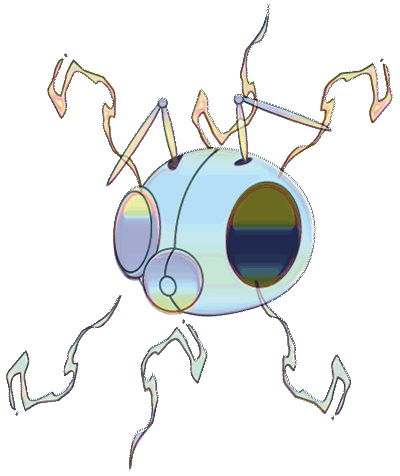
DOWNLOAD PRESS RELEASE (.pdf)
SEE IMAGES FROM ACCOMPANYING EVENTS
LISTEN to a recording of the conversation with John Conomos and Steven Ball at Furtherfield Gallery
Deep Water Web is a free exhibition at Furtherfield Gallery in London’s Finsbury Park, connecting opposite sides of the Earth to understand human impacts on the environment and the wider consequences for people living in both locations.
Artists Steven Ball (London, UK) and John Conomos (Sydney, Australia) have collaborated to present a multi-projection installation where London and Sydney are continuously connected across time zones. The exhibition is an immersive experience which the artists have termed a ‘hyperlandscape’ including real time streaming waterscapes and multiple local manifestations of global ecologies with their own sonic environments and narrated reflections.

Deep Water Web is a poetic meditation around contemporary and historical geopolitical contexts, underscored by London and Sydney’s situation around large bodies of tidal water in the forms of the River Thames and Sydney Harbour. These bodies of water bear material evidence of the local impact of global warming, such as rising tide levels caused by melting ice caps, leading to flooding, and increasingly extreme climate fluctuation. Both cities are also centres of neoliberal capitalism, inscribing the effects of privatisation, fiscal austerity and deregulation of markets across the planet.
Deep Water Web weaves rhetorical explication of postcolonial relationship, elaborating the precarious material forms of climate change, and post-labour late capitalist neoliberal urban developments of waterfronts of former Docklands, considered within the geological and rhetorical ecology of the Anthropocene.
The age of global warming and global neoliberal capitalism are figured here as critical rhetorical realms. These phenomena can be described as what Timothy Morton has called hyperobjects, objects so massively distributed in time and space as to transcend localisation. While they are impossible to comprehend at scale, hyperobjects exert a profound effect at a local level.

Deep Water Web will also become a catalyst for a workshops series at Furtherfield Commons, which will extend its themes through media based excavations. [dates and full details to be confirmed]
Both artists both have long standing moving image based practices and an interest in landscape and the representation of place. As a hyperlandscape this project suggests that questions of relationship to place, and the construction of landscape, can in the Anthropocene no longer be considered as simply pictorial representation or subjective experience, but is constituted from a range of critical, ethical, ecological, and political positions and concerns.
+ MORE INFO: http://deepwaterweb.net
Deep Water Web is supported by Arts Council England.
Exhibition Tour with artist Steven Ball
Tuesday 4 October 2016 – 5:30-6:15pm – Furtherfield Gallery
Revolutions and Complex Systems
Every Tuesday for 6 weeks
6:30 – 8:30pm at Furtherfield Commons – from 27 September 2016
BOOKING ESSENTIAL
A conversation with John Conomos and Steven Ball
2-3pm Saturday 29 October – Furtherfield Gallery
Booking is essential for this free event
Furtherfield in partnership with the antiuniversity and Radical Think Tank are proud to present this new 6-part course led by Graham Jones.
Aimed at people with an interest in social change, the course will apply concepts from complex systems theory to understanding revolutions and social movements. Sessions will involves a mix of speaker presentation and participatory discussions/activities, covering subjects such as ecology, network theory and new materialist philosophy.
Graham Jones is an activist based in East London, working with groups such as Radical Assembly, Radical Housing Network and Radical Think Tank. Booking Essential.

Steven Ball is an artist, writer and academic based in London, working with audio-visual media engaged with landscape and spatial representation, in local and global, social, political and post-colonial spheres. Since 2003 he has been Research Fellow at Central Saint Martins and was instrumental in developing the British Artists’ Film and Video Study Collection.
John Conomos is an artist, critic and writer based in Sydney, Australia. His books, essays and artworks are framed within four traditions of contemporary art: Anglo-American and Australian cultural studies, critical theory and post-structuralism. He is a New Media Fellow of the Australia Council for the Arts, and Honorary Professor at Victorian College of the Arts, University of Melbourne.
Furtherfield was founded in 1997 by artists Marc Garrett and Ruth Catlow. Since then Furtherfield has created online and physical spaces and places for people to come together to address critical questions of art and technology on their own terms.
Furtherfield Gallery
McKenzie Pavilion
Finsbury Park, London, N4 2NQ
Visiting Information
Furtherfield Gallery is supported by Haringey Council and Arts Council England
Several months ago I stayed in an offbeat Amsterdam hotel that brewed its own beer but refused to accept cash for it. Instead, they forced me to use the Visa payment card network to get my UK bank to transfer €4 to their Dutch bank via the elaborate international correspondent banking system.
I was there with civil liberties campaigner Ben Hayes. We were irritated by the anti-cash policy, something the hotel staff took for annoyance at the international payments charges we’d face. That wasn’t it, though. Our concern was intuitive about a potential future world in which we’d have to report our every economic move to a bank and the effect this could have on marginalised people.
‘Cashless society’ is a euphemism for the “ask-your-banks-for-permission-to-pay society”. Rather than an exchange occurring directly between the hotel and me, it takes the form of a “have your people talk to my people” affair. Various intermediaries message one another to arrange an exchange between our respective banks. That may be a convenient option, but in a cashless society, it would no longer be an option at all. You’d have no choice but to conform to the intermediaries’ automated bureaucracy, giving them a lot of power and a lot of data about the microtexture of your economic life.

Our concerns are unfashionable. Without any explicit declaration, the War on Cash has begun. Proponents of digital payment systems are riding upon technology-friendly times to proclaim the imminent Death of Cash. Sweden leads in the drive to reach this state, but the UK is edging that way too. London buses stopped accepting cash in 2014 but do accept MasterCard and Visa contactless payment cards.
Every cash transaction you make is one that payments intermediary like Visa takes no fee from, so it has an interest in making cash appear redundant, deviant and criminal. That’s why, in 2016, Visa Europe launched its “Cashfree and Proud” campaign to inform cardholders that “they can make a Visa contactless payment with confidence and feel liberated from the need to carry cash.”
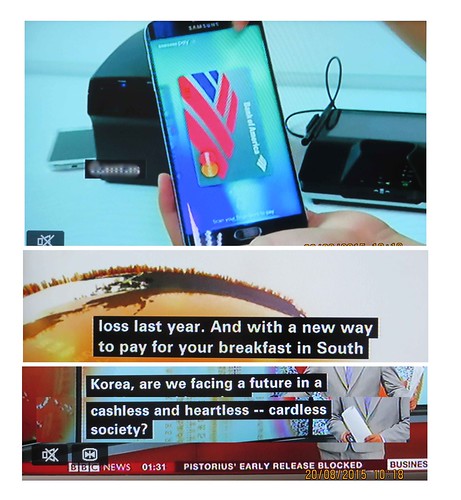
The company’s press release declared the campaign “the latest step of Visa UK’s long-term strategy to make cash ‘peculiar’ by 2020.”
There you have it. An orchestrated strategy to make us feel weird about cash. Propaganda is a key weapon of war, and all sides present themselves as liberators. Visa comes across like a paternalistic commander when assuring us that we – like a baby taking first steps – will feel a sense of achievement at liberating ourselves from the burden of cash dependence. Visa technology offers freedom without dependence or dangers.
Other propagandists join Visa. In 2014 Penny for London arrived, an apparently altruistic group set up by the Mayor’s Fund for London and Barclaycard, using charity as a hook to switch people to contactless cards on the London Underground. PayPal plastered cities with billboards claiming that “new money doesn’t need a wallet”, and a video proclaiming: “New money isn’t paper, it’s progress”. Astroturfing campaigns like No Cash Day are backed by American Express, highlighting such anti-cash themes as the environmental impact of banknotes. Other tactics include pointing out that criminals use cash, that it fuels the shadow economy, that it’s unsafe, and facilitates tax evasion.
These arguments have notable shortcomings. Criminals use many things we keep – like cars – and fighting crime doesn’t prioritise maintaining other social goods like civil liberties. The ‘shadow economy’ is a derogatory term used by elites to describe the economic activities of people they neither understand nor care about. As for safety, having your wallet cash stolen pales compared to having your savings obliterated in a digital account hack. And if you care about tax justice, start with the mass corporate tax avoidance facilitated by the formal banking sector.
However, the peculiar feature of this war is that only one side is fighting. Very few media champions defend cash. It is like a taken-for-granted public utility, whereas digital payment platforms are run by private companies with an incentive to flood the media with their key messages. When they fight this war, their target is our cultural belief in cash and the belief that its provision should be a public right.
The UK government does not plan to maintain that right and is siding with the payments industry. Their position is summed up by economist Kenneth Rogoff in his new book The Curse of Cash. He argues that, apart from facilitating crime and tax evasion, cash hampers central banks from setting negative interest rates. In the absence of cash, everyone must keep their money in the form of digital bank deposits. During recessions, central banks could then use the banking system to deliberately corrode people’s deposits via negative charges, ‘inspiring’ them to spend rather than hoard.
The emergent consensus among economic and political elites is that this is the direction to go in, but to manufacture consent for this requires a drip-drip erosion of public resistance. Hearts and minds must be shown that the change represents inevitable and desirable progress.
Anyone defending cash in this context will be labelled as an anti-progress, reactionary, and nostalgic Luddite. That’s why we must not defend cash. Rather, we should focus on pointing out that the Death of Cash means the Rise of Something Else. We are fighting a broader battle to maintain alternatives to the growing digital panopticon that is emerging all around us.
To understand this conflict, we must step back. A monetary transaction involves exchanging specific goods or services for tokens giving access to general goods and services from others. The pub landlord hands me a beer at night if I transfer tokens that allow him to get cigarettes from a shopkeeper in the morning.
There are two ways to implement this, though.
The first is to give the tokens a physical form. In this scenario, ‘getting rich’ means accumulating those physical things and ‘making a payment’ means handing them over to someone else. They are bearer instruments, which means nobody keeps a record of who owns them. Rather, whoever holds them owns them. This is your wallet with notes in it. This is cash.

Alternatively, you can use a ledger. Someone sets up a database with spaces allotted to different people. This is then used to keep a record of who has tokens. These tokens have no physical form but are written into existence. They are ‘data objects’ and are ‘moved around’ by editing the record. The keeper of the ledger thus maintains an account of what money is attributable to you, ‘keeping score’ of it for you. In this system, ‘getting rich’ means accumulating a high score on your account. ‘Making a payment’ involves identifying yourself to the keeper of the ledger via a communications system and requesting that they edit your account and the account of whoever you are paying.
Does this sound familiar? It is your bank account.
Old banks used actual books to maintain these account ledgers, but modern banks use digital databases housed in huge data centres. You then interact with them via your internet banking portal, your phone app, or by going into a branch. This is not a minor part of the monetary system. Over 90 per cent of the UK’s money supply exists nowhere but on bank databases.
It is upon this underlying infrastructure that payment card companies like Visa build their operations. They deal with situations in which someone with one bank account finds themselves in a shop owned by someone else with another bank account. Rather than the pub landlord giving me his bank details for a manual transfer, my card sends messages through Visa’s network to automatically arrange the editing of our respective accounts.
Many fintech – financial technology – startups specialise in finding ways to augment, gamify or streamline elements of this underlying infrastructure. Thus, I might use a mobile phone fingerprint reader to authorise changes to the bank databases. – ‘disruption’ merely involves putting slicker clothes on the same old emperor.
The use of high-speed communications systems to rearrange binary code information about who has what money might be new, but ledger money is as old as any bearer form. The Rai stones of the island of Yap were huge and largely unmovable stones that, while seeming like physical tokens, were a form of ledger money. Rather than being physically moved – like cash would – a record of who owned the stones was kept in people’s heads, stored in their communal memory. If the owners wished to ‘transfer’ a stone to another, they ‘edited the ledger’ of who possessed the tokens by merely informing the community. Why physically roll the stone if you can get everyone to remember that it has ‘moved’ to somebody else? The main reason that we struggle to recognise this as a form of cashlessness is that the ledger is invisible and informal.
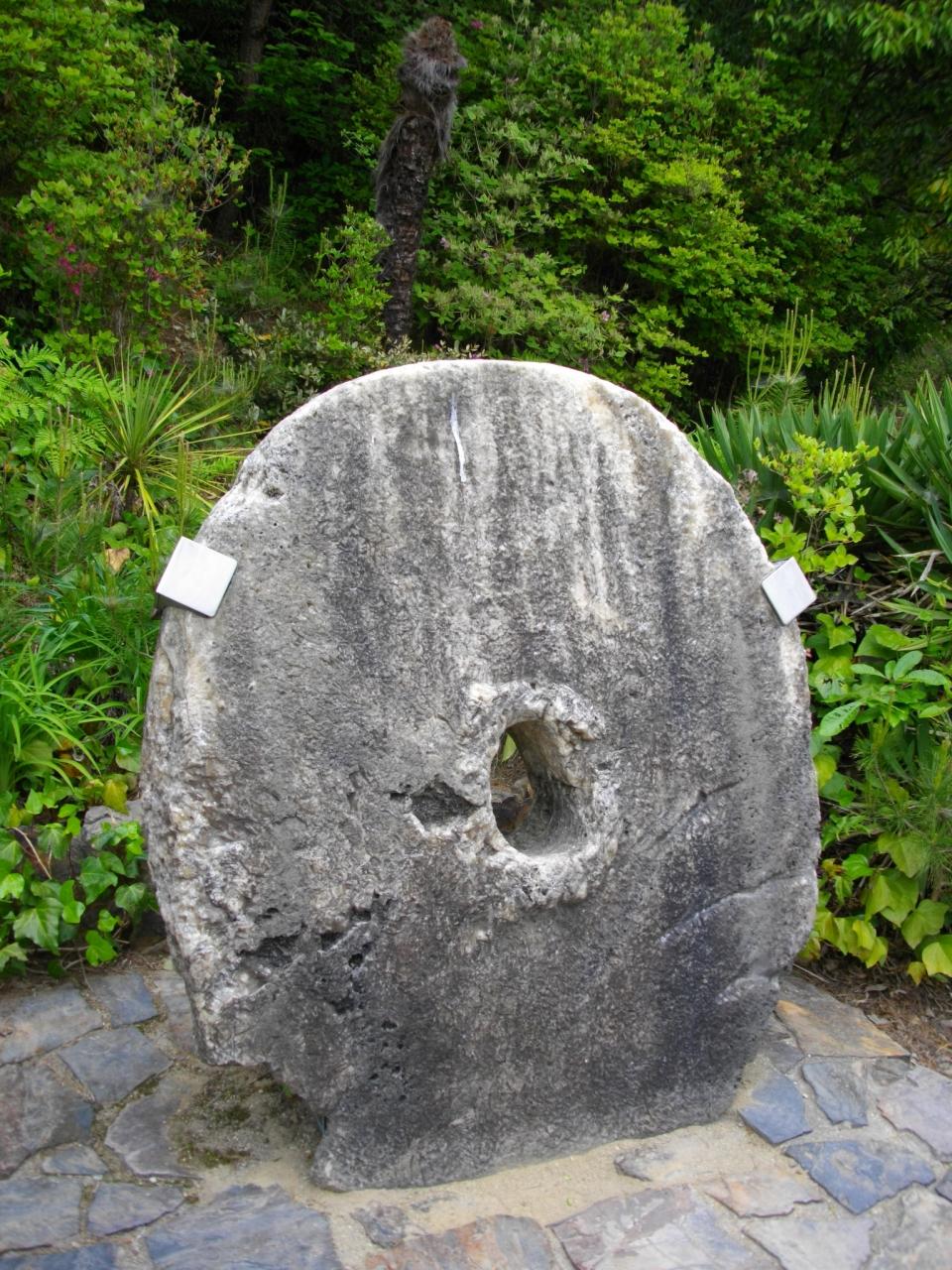
Cashless society, though, is presented as futuristic progress rather than past history, a fashionable motif of futurists, entrepreneurs and innovation gurus. Nevertheless, while there are real trends in behaviour and tastes to be spotted in society, there are also trends in behaviour and taste among trend-spotters. They are paid to fixate upon change and have the incentive to hype minor shifts into ‘end of history’ deaths, births and revolutions. Innovation communities are always at risk of losing touch within an echo chamber of buzzwords, amplifying one another’s speculations into concrete future certainties. These prediction factories always produce the same two unprovable sentences: “In the future we will… ” and “In the future, we will no longer… “. Thus, in the future, we will all use digital payments. In the future, we will no longer use cash.
This is the utopia presented by the growing digital payments industry, which wishes to turn the perpetual mirage of a cashless society into a self-fulfilling prophecy. Indeed, a key trick to promoting your interests is to speak of them as obvious inevitabilities already underway. It makes others feel silly for not recognising the apparently obvious change.
To create a trend, you should also present it as something others demand. A sentence like “All over the world, people are switching to digital payments” is not there to describe what other people want. It’s there to tell you what you should want by making you feel in sync with them. Here’s fintech investor Rich Ricci invoking the spectre of millennials, with their strange moral power to define the future. They are repulsed by the revolting physicality of cash and feel all warm towards fintech gadgets. But these are not, on the whole, real people. They are a weapon in the arsenal of marketing departments to make older people feel prehistoric. We’re not pushing this. We’re just responding to what the new generation demands.
And so we get Visa’s Cashfree and Proud campaign. If people really were ashamed of cash, they wouldn’t need ads to tell them. Visa must engineer that shame to teach you that what you want is the same as what they want. And if you don’t want it, just remember that a cashless society is inevitable. Don’t get left behind.
But this system will leave many behind. It is hardwired to include only those with access to a bank account, and bank accounts are hosted by profit-seeking corporations that operate at scale. They have no time for your individual idiosyncrasies. They cannot make a profit off anyone who cannot easily be categorised and modelled on a spreadsheet.
So, good luck if you find yourself with only sporadic appearances in the official books of state, if you are a rural migrant without a recorded birthdate, identifiable parents, or an ID number. Sorry if you lack markers of stability if you are a rogue traveller without a permanent address, phone number or email. Apologies if you have no status symbols or are an informal economy hustler with no assets and low, inconsistent income. Condolences if you have no official stamps of approval from gatekeeper bodies, like university certificates or records of employment at a formal company. Goodbye if you have a poor record of engagements with recognised institutions, like a criminal record or a record of missed payments.
This is no small problem. The World Bank estimates that there are two billion adults without bank accounts, and even those who do have them still often rely upon the informal flexibility of cash for everyday transactions. These are people bearing indelible markers of being incompatible with formal institutional space. They are often too unprofitable for banks to justify the expense of setting them up with accounts. This is the shadow economy, invisible to our systems.
The shadow economy is not just ‘poor’ people. It’s potentially anybody who hasn’t internalised the correct state-corporate narrative of normality and anyone seeking a lifestyle outside of the mainstream. The future presented by self-styled innovation gurus has no scope for flexible, unpredictable or invisible people. They represent analogue backwardness. The future is a world of endless consumer choice built upon an inescapable digital uniformity of automated rules, a matrix outside which you can neither exist nor think.
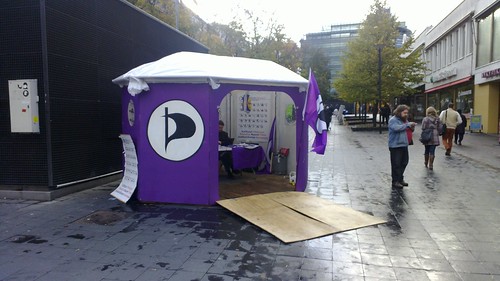
Back in Amsterdam, I hang out with Ancilla van de Leest of the Netherlands Pirate Party. She only visits establishments that accept cash, true to her political belief in individual privacy from prying eyes.
However, it would be wrong to assume that Ancilla’s primary concern involves surveillance by a Big Brother-style bogeyman. It’s true that your spending patterns reveal much about how you actually live, and the privacy implications of having these recorded in searchable database format are only starting to be uncovered. We know that targeted individual surveillance of payments occurs by the likes of the FBI and NSA, but routinised mass surveillance could become a norm. Imagine automatic flagging systems triggered by anyone engaging in a combination of transactions deemed subversive. Tax authorities are bound to be building systems to flag discrepancies between your spending patterns and your declared profits.
It’s also true that at London fintech gatherings, the exciting visions of a cashless society occasionally come with a disclaimer that we should think about the power granted to those who control the system. Not only can payment intermediaries see every time you buy access to a porn site, but they have the ability to censor your transactions, like Visa, PayPal and MasterCard attempting to choke WikiLeaksby refusing to process people’s donations. We could imagine some harsh sci-fi scenario in which a theocratic regime issues decrees to payment processors to block anyone buying books deemed sexually deviant. Such decrees could be automatically enforced via code, with subroutines remotely triggering smart locks to place the offending miscreant under house arrest while automatically deducting a fine from their account.
Such automated dystopias should ideally be avoided, so a dose of paranoia about digital payment systems is a healthy impulse, even if it might be unwarranted.
But that isn’t really the point. What’s more important to Ancilla and me is the looming sense of an external watcher that ‘assists’, ‘guides’ or ‘helps’ you in your life, tracking and logging your moves to influence you. The watcher is not a single entity. It’s a collective array being incrementally built in stages by startups and companies worldwide as we speak. We feel it seeping deeper into our lives, a mesh of connected devices, cookies and sensors. Whether we visualise it as the benevolent eyes of a parent or the menacing eyes of a tyrant doesn’t matter. The point is that the eyes have the potential to monitor you all the time.
The proclaimed Death of Cash is thus an episode in the broader drama that is the Death of Privacy, the death of the breathing room, and the death of informal, non-measured, unaccounted-for behaviour. Every action you take must forever be attached to your digital persona, dragging a data trail extending back to the day you were born. We face creating an entire generation of people who do not know what it feels like not to be monitored.
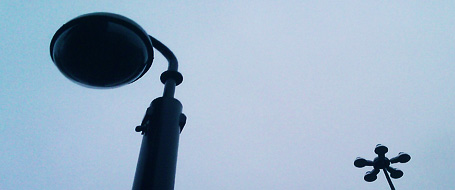
For many economists, the War on Cash will be resolved by their favourite mystical demigod, the market. This guiding force prevails when utility-maximising producers and consumers make rational choices with perfect information about their options and total freedom to choose whether or not to exercise them. If digital payment transaction costs are lower, then the cash will rightly die.
The pristine realm of market theory is unfit to assess the dynamics of this situation. Our sense of what constitutes a legitimate choice does not form in a vacuum. We are born into social power structures that tell us what normality is and shame us for not choosing ‘correctly’. You might be a rebel who challenges prevailing cultural norms, but those norms are conditioned by those with the greatest financial and media clout. At this moment, the blaring of propaganda extolling the short-term conveniences of digital payment is dulling our critical impulses to rearrange our cultural DNA. Who is thinking about the longer-term implications of building our lives around these systems and thereby locking ourselves into dependence upon them?
Unlike a battle fought using violence, hegemony is the assertion of power by getting people to believe in it, to see it as inevitable, unassailable and normal. Visa’s four-year plan is one such exercise, and once we’ve internalised it, we’ll choose to build their power. We’ll feel strangely comforted by the MasterCard billboard endorsed by the Mayor of London. We’ll find ourselves downloading ApplePay like a dazed child accepting a gift.
So, let’s prepare for the War on Cash. Remember, this is not about romanticising the £10 notes with the Queen. This is about maintaining alternatives to the stifling hygiene of the digital panopticon being constructed to serve the needs of profit-maximising, cost-minimising, customer-monitoring, control-seeking, and behaviour-predicting commercial bureaucrats. And fear not, the Germans are onside, along with the criminals, the homeless, the street-side buskers and an army of people whose lives will never get a five-star rating on a mainstream reputation scoring system. We will forge alliances with purveyors of non-bank alternative currency systems and maintain the option to use our payment cards. Because what we fight for is precisely that. The option.
When looking at the many artistic projects focused on how and why we use the internet, it’s easy to find yourself lost in a field which doesn’t show obvious, strong ties with what we normally know as “traditional art history”. This is due to historical and social reasons that emerged between the 80s, 90s and early 2000. These artists were at the vanguard of art culture and pushed at the edges of what art could be, whilst living in a post-punk and postmodernist era, and on tip of this, the arrival of the Internet in 94 changed everything. Many artists took on the challenge of what the Internet offered the world creatively, and explored it not merely as a marketing tool or a place to upload images and videos, but as a medium in its own right, inventing new technically informed, artistic tools and also building grass root led, networked art groups with new infrastructures as cultural platforms. Turning away from anything relating to the mainstream art world and what was seen as outmoded and tired traditions.
In the last decade, we’ve seen the expansion of the Internet and its use by younger generations where the medium is no longer something you exploit to change the culture, but more to integrate in traditional terms, canonical contexts.However, artist Jan Robert Leegte (born in 1973) is a very important figure to reflect upon, in order to understand this transition; while other artists of his generation were taking the internet for a non-hierarchical distributed system, he chose to explore it from a classical studies background that forged the cardinal points of his artistic research. He reflects an Internet art influenced practice which not only exists online but also in physical space. In fact, we can safely say he can be considered as one of the first Post-Internet artists. This makes him a pivotal figure in this historical segment and it’s under this light that one must visit the online exhibition On Digital Materiality (Carroll / Fletcher Onscreen, 3 August-12 September 2016). It’s a retrospective show presenting some of the most important and representative works of the Dutch artist, who wrote for the occasion an essay in which describes some of the most important aspects of his work.
Leegte says, the “materials I first used were basic HTML objects, buttons, scrollbars, frame borders, table borders, and also plain color fields and found images. I questioned what it was that rendered this practice similar to making installations rather than collages. At first it was the simulacrum of real world interactive elements (buttons, window frames, etc.). The operating system extended this haptic strategy with traditional paper-based forms, like check boxes, text fields, lists, etc, and, along with the form elements and the interactive document, led to an ecosystem of fake 3D, interactive objects.”
The work fluctuates between working on the surface and thinking in three dimensions. The same difference can be found with his use of Photoshop and HTML. If in the former case an image editing software operates directly on the final result, for the latter there is the need to know how to write code while at the same time imagine what the potential results will bring via its translation in the public space, the internet. In this sense, we do not hesitate to define Leegte as an artist who studies and uses the tools of the sculptor; he wonders how to place objects in the space, he feels the problem of contextualising a work in relation to a public and physical environment.
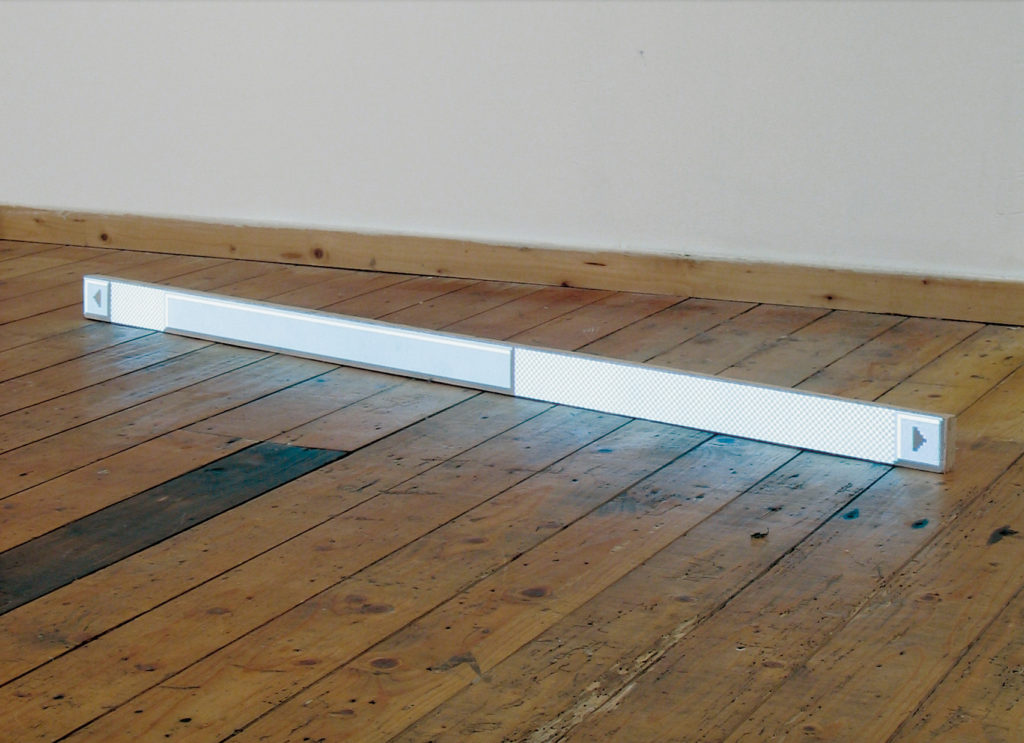
The perception of a substantial difference between surface and space is also proven with his interest in the basic elements of composing the digital interface (scrollbars, mouse pointers, etc). His research examines the artificial environment built by Microsoft and Apple designers. The colours and the shapes were designed to not be perceived as evident mediating agents between the user and the content – in this sense, it is interesting to note that Microsoft has often chosen a minimalist style (shades of grey, square shapes) while with Apple systems the style is usually more exuberant.
However, we should not look at the former as a less culturally relevant product. In the same way, we should not take the white cube exhibition space as a synonym of neutrality (unless we want to think that the whiteness and emptiness stay for an objectivity). This is an aspect that the artist does not seem to detect (in the text, he writes that he “preferred the aesthetics of the Windows classic interface design because of its minimalistic design – no rounded corners and ribbings like the OS 9 design, but simple beveled grey rectangles and a button object was merely a highlight and a shadow, nothing more”).
The artist reflected on how specific design elements may in some sense be preserved, as reflections and products of a particular aesthetic and cultural taste: “In Memory of New Materials Gone” (2014) is a work made by a print of the OS9 scrollbar placed in a transparent case in the same way you would do with an object no longer fashionable. This project and all the other works belonging to The Scrollbar Composition Series programmatically address the perception of virtually anonymous and transparent objects on the screen in a three-dimensional space. In a situation where their significance must be noticed; it’s the artist himself who begs to not see in this a disruptive act, an action that reveals the subtle ways in which they influence us. It is, however (but not “in opposition to”), a reflection on the artist’s activity; as we previously noted, these works are shown on the internet in the same manner in which they would be set up in a gallery space.

Perhaps, the highest point of the artist’s reflection on the differences you meet working on a surface or in three dimensions is The Photoshop Marquee Selection Series. “Random Selection in Random Image” (2012), in which a randomly generated selection marquee is shown within an image randomly obtained from the net. It is the most important work of this series because it opens three-dimensional gaps which have been created sculpturally in two-dimensional images – a dynamic that has echoes of “Scrollbar Composition” (2000), in which the Web browser’s monodimensional space is broken down and reassembled in many windows, many independent spaces sharing only the mathematical material they are made of.

The works featured in this exhibition are related to questions that go beyond the historical and cultural contingency in which they have been created. This makes many of them feel very much alive even 20 years after their creation (a novelty in digital art, I would say). This allows a healthy dialogue between different generations of artists to exist as common ground. It also engages art experts who want to be introduced to artistic issues linked to the internet. It is a dynamic that makes this exhibition a special opportunity for us all to relook at this so-called digital culture and its traditional and non-traditional art theories and its practice under a peculiar and exciting light.
On Digital Materiality – an Internet exhibition is online at Carroll / Fletcher Onscreen until 12 September 2016
Artist collective THEY ARE HERE invite you to play with and test software that allows wireless-enabled computers and mobile devices to directly form a spontaneous communication network independent of the internet.
Across a series of drop-in sessions facilitated by THEY ARE HERE, games and experiments will be trialled as part of the development process for their forthcoming exhibition at Furtherfield in October 2016.
These activities will take place online & offline around Finsbury Park.
Please bring a wi-fi enabled device to the workshop and if possible download the software Qaul.net in advance (qaul.net/software.html.)
No experience is necessary. Each session will be a discrete event, so you can attend as many or as few as you care to.
Join THEY ARE HERE at any of the following meetings at Furtherfield Commons, Finsbury Gate, Finsbury Park.
Session 1: 3pm Sunday 14th August 2016
Session 2: 3pm Sunday 28th August 2016
Session 3: 3pm Sunday 11th September 2016
Session 4: 3pm Saturday 24th September 2016
You must be aged 16 yrs +
Email contact(at)theyarehere.net for further information.
Date:NOW
Venue:HERE Links:http://www.crowdfunder.co.uk/artists-rethinking-the-blockchain?tk=208334da9b174c..
WE WANT your submissions to this landmark publication marking and augmenting the arrival of a new technology on the cultural landscape.
THE BLOCKCHAIN is widely heralded as the new internet – another dimension in the ever-faster ever-more-powerful interlocking of ideas, actions and values. [1]
It’s nothing more than a ledger distributed across a large array of machines. An apparatus that enables digital ownership and exchange without a central administering body. But from these simple premises, it has been credited with the potential to transform everything, from trade, to cultural production, to the way we’re governed.
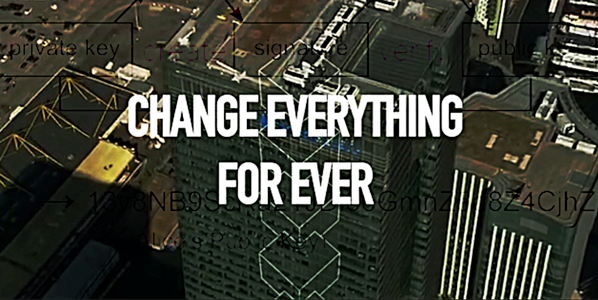
Among other things, we are suspicious of cultural production being brought under the same regime as finance.
Even as we write, this “new dawn” for transactions is being re-imagined as the next sleep-cycle taking us deeper into the neoliberal dream of complete financialisation. In this dream, Finance and Technology quicken their demented mining of value tokens from phenomena, while the grammars of culture, family, nature, politics and spacetime itself evaporate into a flurry of question and exclamation marks in their wake.
“It’s going to change everything!” (The Guardian)
The permanence and irrevocable automation of blockchain systems wedded to the irrationality and sweep of techno-financial hybrids has led to forecasts ranging from ‘fully automated luxury communism’, to our ultimate cryptological enslavement to machines, or the collapse of time itself, as the feature of algorithms to make-happen overtakes the temporal concerns of flesh and earth.
Artists Re:thinking The Blockchain
This book is not a site for a ludic cynicism or uncritical valorisation, though it celebrates the energies of these excessive forms of thinking. We welcome the potentials for ever more nuanced democratic apparatus, and the decentralization of power from state-corporation cabals, while rejecting the notion that any single technology would automatically enact these ideological transformations. We seek also to register and amplify the leakages, weirdness and side-effects that this new technology inaugurates.
Imagined as a future-artefact of a time before the blockchain changed the world, and a protocol by which a community of thinkers can transform what that future might be, Artists Re:Thinking The Blockchain acts as a gathering and focusing of contemporary ideas surrounding this still largely mythical technology.
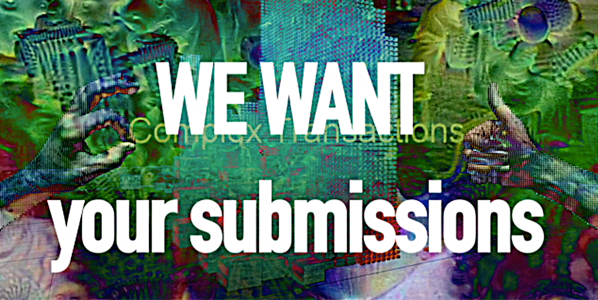
The book will include examples and discussions of current artistic projects making use of and illustrating the potentials of the blockchain, theorisation from some of the leading figures in the global blockchain conversation, and practical discussions which artists can use to guide their first steps towards this new technology.
We welcome submissions of
· book-based artworks which reflect on blockchain themes
· science fictions and theorisations, particularly in their hybrid form
· proposals for documentation of online and irl artworks
· poems, particularly based on the ‘new book’ and formal constraint txtblock [2]
The publication is a collaboration between Torque and Furtherfield, connecting Furtherfield’s Art Data Money project with Torque’s experimental publishing programme.
Alongside an illustrated print edition, the project includes a range of public-participation and debating sessions in towns and cities up and down the UK, and the first-ever book launch taking place on the blockchain itself.
DEADLINE FOR PROPOSALS 15th August
– up to 500-word abstract, description or sample of your proposed submission
– a short bio
– website link (optional)
mail to: mail@torquetorque.net
DEADLINE FOR FINAL SUBMISSIONS will be 1st October
torquetorque.net || furtherfield.org
https://www.facebook.com/torquebooks
#artblockbook
Contact: mail@torquetorque.net
Featured image: ToolsForAction.net / Artúr van Balen and QueerSport.info / Zeljko Blace, ‘POP-UP RAINBOW’, 2014
Zeljko Blace is working in(-between) contemporary culture, media technologies and sport, cross-pollinating queer, media and social activism. He is one of the initiators and a co-curator of the project ‘contesting/contexting SPORT 2016.’
to reclaim the field with art and activism
exhibition and program in Berlin (08.07-28.08.2016)
at nGBK and KunstraumKreuzberg/Bethanien
http://ccSPORT.nGbK.de
www.facebook.com/cc.sport.2016/
www.twitter.com/CcSPORT2016
The exhibition and program contests the field of SPORT through critical art and activist practices. Coming from feminist and queer practices, the project aims to challenge discrimination and encourage emancipation. SPORT is contextualized from its declarative neutrality and autonomy, rendering diverse influences, but also experiences and conditions of SPORT realities visible.
Organized by the ccSPORT international working group of the nGbK including also: Caitlin D. Fisher, Carmen Grimm, Mikel Aristegui, Sarah Bornhost, Stuart Meyers, Imtiaz Ashraf, Andreea Carnu, with support from: Tom Weller, Alexa Vachon, Ilaa Tietz, Tabea Huth, Barbara Gruhl, Steffy Narancic, Tristan Deschamps, Coral Short, Gegen Berlin, Schwules Museum, and advisors: Alex Brahim, Jennifer Doyle, Philippe Liotard, Jules Boykoff, Stephane Bauer and †Frank Wagner.
BOSMA: The ‘contesting/contexting SPORT 2016’ exhibition and program shows a wide range of uncommon perspectives on sports, questioning cultural systems embedded in them we hardly ever think about. Why did you make this exhibition?
BLACE: In this ‘networked’ and globalized time we paradoxically live out a multiplicity of highly fragmented realities, niched in specialized interest groups, while ‘others’ feel they can not contribute or even relate to them. It felt like this to me in my work during the late/post 90s with tactical and net media activism/art – fully disconnected from queer politics and sports organizing for which I had an increasing interest. In general the field of sport has not been part of the lives of many intellectuals, activists and creatives. Many had bad (even traumatic) experiences with sport in childhood and adolescence, feeling alienated, or simply not recognizing it as a possible field to develop work in (unlike right-wing populists in tribal fan cultures). Simply put, the sport system has been taken for granted in its current form. Hence, my first curated sport exhibition title, paraphrased ‘sport hater’ Chomsky, in ‘Another SPORT is possible?!.’ (2012, Galerija NOVA, Zagreb, Croatia). My Berlin colleagues and ccSPORT co-founders Caitlin Fisher, Tom Weller and Carmen Grimm felt the same about the separation of sport from arts, activism and academic research. Together (with the support of exhibition spaces nGbK and Kunstraum Kreuzberg/Bethanien) we made plans to instigate and support intersections, cross-pollinate practices and perspectives between these fields through an exhibition, program and media work. We strongly felt the field of sport would never become self-critical and reform, nor would it engage with a wider audience beyond a given consumerist mode, if left to the managerial mentalities and the opportunism of its leaders. We need to reclaim the field of sport together to change it.

Is this the first ever exhibition criticizing the cultural and political dimensions of sports, and if not, how does your perspective relate or differ from earlier approaches?
I can not say with complete certainty what other group exhibitions on sport critique have taken place before. There have been many on a small scale, marginal in comparison to the huge exhibitions that ‘celebrate’ sports and are used as decor and entertainment accompanying sport spectacles (a notable exception is the seminal work ‘Electronic Café’ by K. Galloway & S. Rabinowitz at the 1984 LA Olympics, that actually provides space for interaction/discussion in between different city locations). There were also a few archival exhibitions looking at historical artifacts and documentation critically, as well as some that were experimental and playful (such as the Fluxus Olympiad, scripted as non-competitive multi-sports event) but these approaches were somewhat one-sided. We aspire to create a basis for both critical reflection and informed envisioning of possible developments, by looking at personal perspectives and artistic visions, next to grass-root alternatives and interventions.

The main threads in the exhibition seem to be gender, queerness and the connection between culture, commerce and rules in sport. Are these the main issues at hand?
Indeed our starting points were feminist and queer positions, but we were also very interested in the wider range of intersections and systemic issues within the field of sport that we could connect, rather than focusing on single-issues like homophobia or racism as is often done in mainstream sport campaigns. We decided very early on that the project would not be about identity politics, but rather about the multiplicities of axes of discrimination. There is a spectrum of emancipation efforts and practices that inspire us to think outside of gender norms, result-focused competitions, spectacle creating events and omnipresent ‘development’ narratives – which ignore for example that women had more access to certain sports historically in different geographies then they did in past 30 years of globalized neoliberalism.
augmented_profile from Diego Grandry on Vimeo..
How do you see the role of the media in the perception of sport?
Traditional broadcast media are the key stakeholder in the Olympics and similar sporting-spectacles. They have made the organizers of large sport events addicted to their huge broadcast contract revenues, but then inherently push for the spectacle of mega-events even further at the cost of other aspects. Newer sports that have evolved around this economy of attention have often sexed athletes (most visible with female beach volleyball) or at least contributed to enforcing gender stereotyping (like the feminization of soccer/football to the point that there are almost no short haired players at the Olympics). Instead of actively evolving with the progressive trends in sport, most broadcasters deepen the stereotypes; too often commenting on the marital status and appearance of female athletes, or referring to them as girls. Athletes from smaller countries, and sports that receive the least coverage are often looked down on, projecting neo-colonial relations on them (or hosts as in Brazil).
With internet networks and ‘social’ media the situation it is more complex as the interactive nature of media often allows for feedback and multiple standpoints in the same, or various foras. These media diversity brings to the surface and exposes critical minority voices and individuals who are able to argue against norms and question their necessities. For example, the tokenizing of muslim female athletes during these last Olympics received great reactions including historical facts about muslim women winning medals in the ‘80s and ‘90s. Also the outing of gay athletes by one reporter, was widely criticized online and the media hype reboot around Caster Semenya was compensated by internet and hybrid media (i.e. AJ+) publishing numerous expert articles and even giving voice to many (including former opponents critics converted to supporters as in case of Australian runner Madeleine Pape).
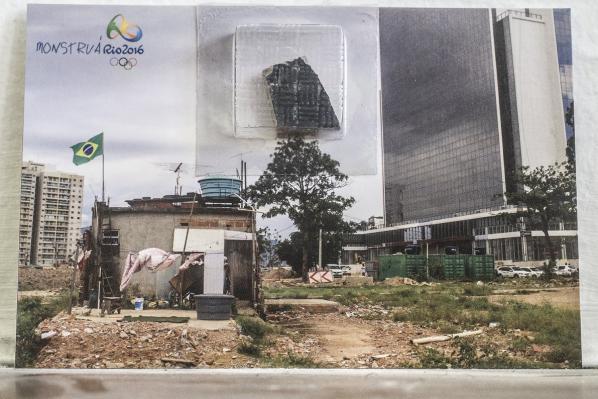
The connection between rules and cultural systems in sports is fascinating to me. You have worked as an organizer/curator in Multimedia Institute/MaMa before focusing on sport. What is your perspective on the rise of technological systems in the enforcement of rules, like for example drug testing or electronic goal-line and court line tracking?
Actually, the technological aspects of sport are the ones that still need to be addressed more specifically (technology centered single sport competitions exist since years, with The Cybathlon as their olympics premiere in Zurich, October 8th 2016). They not only re-enforce certain types of (measurable) norms, but also reduce the complexity into what appears to be arguable ‘logic’ and ‘common sense,’ while hiding other aspects (psychological and even aesthetic). Drug testing is an important measure of control, but is usually focused on the supra-performance of medal-winning athletes, rather than concerning itself with more generally applicable questions: what are the drugs, who has access to them and why. As long as the prevalent ‘production’ of results at all costs is dominating sports, the goal of ‘clean’ sports regardless of technological advancements in control will remain impossible. Gender policing at the Olympics has had a lengthy technological path, starting with visual and medical inspections, moving on to DNA and hormone testing and nowadays being fully questioned. Measuring and tracking technologies have the most interesting potential, not only for confirming line calls but for reshaping sports into allowing potentialities of variable norms and measuring based on generative fields/infrastructures. However, this kind of innovation is more likely to develop in the edges of eSports industry (that is pushed by novelty rather than burdened by traditions and conventions) and then maybe get normalized into traditional sport competitions once existing sport federations and regulatory bodies start losing young markets.

It was important for us to initiate conversations and collaborations that were not in place before, especially between those excluded from the mainstream sport system. We stirred up some interest from academic researchers for immediate follow-ups, but also informed some activists and artists of each other’s work. Ideally this could be developed further to elevate the critical and creative work in the field of sport and address issues in multifaceted ways.
We hope the exhibition and program enabled visitors to develop a more articulate position rather than just LOVING / HATING SPORTS, maybe supporting our platform — and ideally also inspired them to build personal or collective proactive relationships to sports. Maybe through practices of engagement against mega-spectacles and hyper-commercialization of sports, while supporting/partaking in grass-root sports or reforming the mainstream system.

Now we look forward to have the time for reflection after the intense work of materializing the exhibition and the extensive events program, as well as to see what future sport events could be interesting to contest and/or contextualize. One of the most important follow-ups is establishing an online space for sustainable communication, exchange and sharing information, know-how, methods, most likely using wikis, maps and media that came out of our research and workshops during the summer exhibition program.
This will be ncluding video of closing lecture by prof. Jennifer Doyle on art, sports and questioning the origins and need for the gender segregation in sports! More info will be appearing on our working website http://www.ccSPORT.link/
What is the relationship between state corruption and economic collapse in Greece?
Lina Theodorou, artist and creator of the board game ‘Pawnshop- Days of Mistrust’, talks with Furtherfield’s Ruth Catlow about Grexit, Brexit and crisis in Europe.
I met Lina Theodorou, the artist and creator of Pawnshop, in her apartment on a sunny Sunday morning in Berlin. It was just one week after the UK referendum resulted in a vote to leave the EU. I was in Berlin to take part in an event called Art, Money & Self Organization in Digital Capitalism, the first in a series of events called Arts and Commons, organised by Supermarkt.
Theodorou and I quickly got onto the topic of Brexit. We compared notes. She wondered if, like Greece, the UK government would choose to ignore the result of the referendum, fail to invoke Article 50, and stay in Europe after all. That possibility had not occurred to me. She talked about her memories surrounding the Grexit debate- the distress, the uncertainty, the shocking hatred and hostility expressed between family members and people previously considered friends. I had been deeply shaken by the upsurge of street-level racism on the streets of Britain.
Pawnshop, the artwork that is also a board game, was set up for play, laid out on a table in her studio. It is an inversion of Monopoly: the same square board, the pieces, the bank, the cards, the dice. However in this game the player starts the game with no money, only property – jewelery, a bouzouki, antique furniture, a flat- and pays a European tax of €1500 when they pass Go (if they get that far).

Players proceed around the board, according to the luck of the dice, along a path strewn with dilemmas. A second row of squares is used to keep track of the time spent dealing with the consequences of their choices- jail sentences, or hospitalizations for example. As they move around the board, they pick one of the cards, depending on their landing square, and must choose how they will respond to the given dilemmas.
Theodorou tells me that the game is based entirely in fact. For years she has collected newspaper stories in Greece. And here they are gathered in four categories of cards – Dilemma, Involvement, Debt and Luck- to encapsulate the experience of daily life, for everyone, in modern day Greece. ”If you are honest you lose” she says.
On her website are photos of engrossed players at Bozar, Center for fine arts, Brussels; at the exhibition TWISTING C(R)ASH; at Bâtiment d’Art Contemporain « Le Commun » in Geneva; and at the exhibition It’s Money Jim, but not as we know it, at Mario Mauroner Contemporary Art Vienna, and As Rights Go By, Museumsquartier, Vienna. She says it’s important that at the beginning players laugh… but because of ”synesthesia”, the longer they play, the more uncomfortable they become, they feel the ethical discomfort in their bodies.
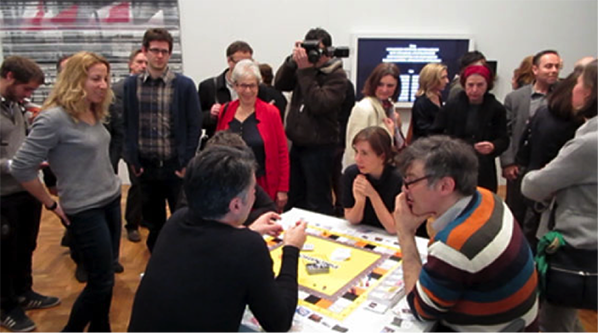

Theodorou and I digress again, coming back to the Europe question. Because I’m in Berlin I think about Germany’s role. Germany at the heart of Europe is perhaps more part of the problem than they realise. The style of bureaucracy is molded to reflect the German mentality and their industrial system.This is coupled with a confidence in the correctness of the system – that Theodorou points out, is accompanied by the Northern European, Calvinist attitude – anyone who does not comply is wrong and must be punished. “But what is good for Germany is not necessarily what is good for Greece” she says. In Greece for many years the economy was made up of many small entrepreneurs, small businesses, shops, and a community focus” Why must we suddenly give this up in favour of big business. “Why do you have to destroy something that is healthy?”After the banking crisis in 2008 pawnshops started popping up on every street in every town in Greece.
Theodorou tells me that Pawnshop is the Greek reality board game.
“Your father is sick, do you pay his hospital bill?
Yes: pay €3000 and he lives for another 6 years,
No: unfortunately he dies, but you receive a life insurance pay out of €75,000”
Picking an ‘Involvement’ card means that that player’s decision will have consequences for other people too; Debt (is the biggest pile of cards).
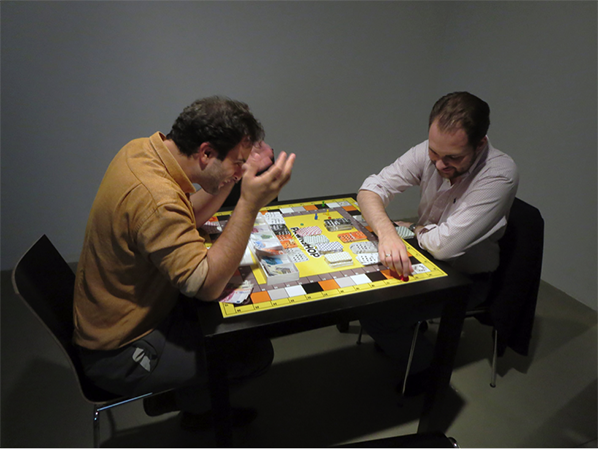
Gentrification strategies have failed in Athens. Back in 2006 the rich Greeks, many of whom were also art collectors, started to organise the large scale art events, (in which of course the artists worked for free), but it didn’t take. Then in 2008 the banks collapsed, the economy became surreal, but somehow, Athens remained the same. Perhaps this because regeneration does not have the ever-rising bubble of property prices to support its economy. In Greece everyday people do not speculate on the housing market (as we do in the UK). Rather a house is something you keep for ever in the family.
Theodorou describes the real world Greek tax system as “insane”. It changes every 3 months, Even the accountants have difficulty keeping up with the laws. This alone forces many people into the black market. Then the web of bureaucracy protects the hierarchical status quo and people in higher positions hold onto their power by putting obstacles in the way of others.
The only way to win this game (on the board and IRL in Greece) is with good luck. Good luck is the only way to avoid ethical discomfort or financial ruin.
The Luck cards (also based on fact as reported by the newspapers) are hilarious. “A politician hits you with her car, but fortunately the accident is witnessed by the media – collect €2500”.
“Some rich ladies wish you a Merry Christmas and hand you €100”.
Apparently Athens newspapers have reported tales, for the last few years, in which “ladies” have distributed money to “the poor” from black windowed limousines.

Pawnshop is a polemic on corruption. Small corruption. Long standing, Greek-style, everyday corruption from which no-one can escape. The universal, forced collusion in corruption, and its corrupting effect on the spirit of Greek citizens and society, is set out in the game mechanics. The playful and social medium of the game means that the impact of contemporary Neoliberal politics on the Greek ‘everyman’ is made legible, feelable and discussable: unending, ethical traps; the impossibility of old-style moral political clarity; the flushing of righteous action, solidarity, resistance or even survival. Corruption all the way up and down.
I question Theodorou carefully, because I have long been suspicious of the narrative that says that corruption is the cause of Greece’s economic problems. But the corruption is a fact. While it is not necessarily the only or even the primary cause of its economic distress – which is very very real- the lack of trust in the state is debilitating and has a stagnating effect on the economy.
Pawnshop sits in an honourable tradition of artist’s activist games: to change mindsets and attitudes by actively implicating players in a reconstruction of values – see Mary Flanagan persuasive research about crticial play and the many attitude-hacking games coming out of her lab Titlfactor. Also Brenda Romero’s chilling Train game, Yoko Ono’s Play it by Trust. And for games that train for resistance and solidarity in games such as Escape from Woomera, Debord’s Game of War, and my own pacifist chess hack, Three Player Chess.

A look around Theodorous portfolios of works reveals a long practice that crosses agitprop, video, installations, and networked pieces.
The work all builds on close observations of contemporary political and social systems. Through graphical exuberance and humour these observations are rendered just (barely) bearable so that we are able to spend time with complex, difficult situations and suspend our certainties. And this is necessary and important. We need to face the complexities and ethical contradictions of contemporary politics. There’s no time to lose.
Before the referendum, I found myself uneasy about actually campaigning for “Remain” in spite of my desire for a pan-European peoples’ alliance. This was because I couldn’t ally myself with the dominating political arguments proposed by the Conservative party (and backed up by big-business and the establishment). I also didn’t want to participate in a binary campaign that stamped on the dignity of the layer of people in the UK who are already so disenfranchised by the effects of austerity cuts (and many years of other systemic injustices). This moment revealed for me, and for many others in the ‘social liberal’ layer, a chasm between my own values and experience and those who voted to ‘Leave’. And a desire to find a way to connect. PostBrexit the reality board game may be just the thing we need to help us come together and play our way through the effects, consequences and possibilities.
Furtherfield in partnership with the antiuniversity and Radical Think Tank are proud to present this new 6-part course.
Aimed at people with an interest in radical social change, the course will apply concepts from complex systems theory to understanding (and creating) revolutions and social movements.
The course is directed at a general rather than academic audience, although a desire for radical social change will be assumed.
6.30 – 8.30pm at Furtherfield Commons, inside the park near Finsbury Gate
Booking essential – Please book here
Tue 27 Sept – Introduction to Complex Systems
Tue 4 Oct – Smash the System – Creating and Harnessing chaos
Tue 11 Oct – Erode the System – Building the New World in the Shell of the Old
Tue 18 Oct – Escape the System – Bodily Affect and Surviving Oppression
Tue 25 Oct – Tame the System – Reforms without Reformism
Tue 1 Nov – Bringing it All Together – A Trajectory for Revolution
Sessions will involves a mix of speaker presentation and participatory discussions/activities, covering subjects such as ecology, network theory and new materialist philosophy.
Other familiar concepts will be re-examined through this framework, including the commons, chaos, structural oppression and reform.
The ultimate goal is for this knowledge to be put into practice to create more effective activism, to contribute to better understanding the workings of contemporary society and to help inspire projects for building future utopian alternatives.
Graham Jones is an activist based in East London, working with groups such as Radical Assembly, Radical Housing Network and Radical Think Tank.
For those unwaged or on low income the course is free (or donate what you can). Choose either the Free Ticket or Donation ticket in the links above.
For everyone else, individual sessions are £5 + booking fee. A prebooking of all 6 sessions is available for £25 + booking fee.
During my visit to Ars Electronica I was humoured by the excessive amount of ‘hello world’ creativity that is often produced when science and technology meet and exhibit interactive spectacles that make very little claim other than an enchanting proof of concept. What I thought would be an interesting media festival turned out to be a robotics road show. This tech road show attracts over 90,000 people from Europe and Asia to wonder at the latest innovations in robotics, VR, bio-hacking, 3d printing, drones and anything that glossed the pages of Wired magazine as the next big thing.
The alchemists of our time, or as I like to call them ‘Dumb wizards’, are continuing to design and exhibit technological achievements in self-fulfilling speculative words that have very little concern, consideration or critique with any relevant social issues of our time. Excluding the CyberArts exhibition (curated by Genoveva Rückert), which I thought was a top selection of some of the best media art works of the last years, Ars Electronica is predominantly occupied by interactive spectacles that neglect to examine the social & political impact of technology.
To overlook how smart phones, big data and network computing are changing privacy & security, or how cloud based services are transforming the labour market or how Silicon valley start up culture has convinced a sizeable amount of the population that for every problem, there is an app based solution. In the bazaar of innovative design and interactive art I struggled to identify any work (be it art, product, or concept/agency) that voiced or articulated concern or criticism with technology, politics or social change. The most provocative aspects would be the whimsical one liner that is planted to introduce some speculative design projects, showcasing some daft prototype with a splash page and a quote in large font to grab the attention of the viewer.
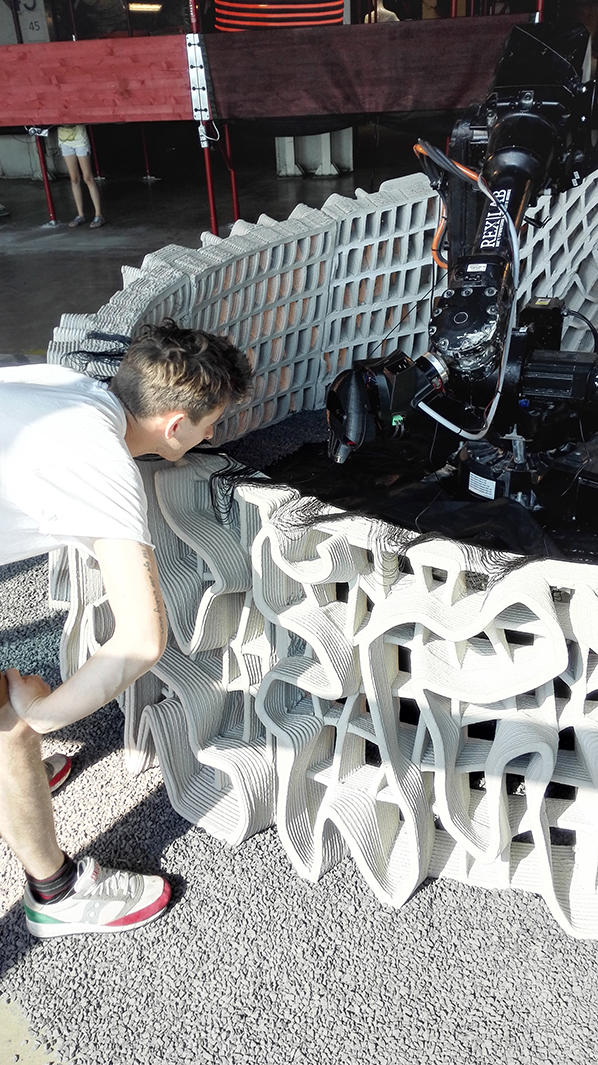
What is the gold of our time?
How do we build a social relationship with others?
Innovation: Where do we go from here?
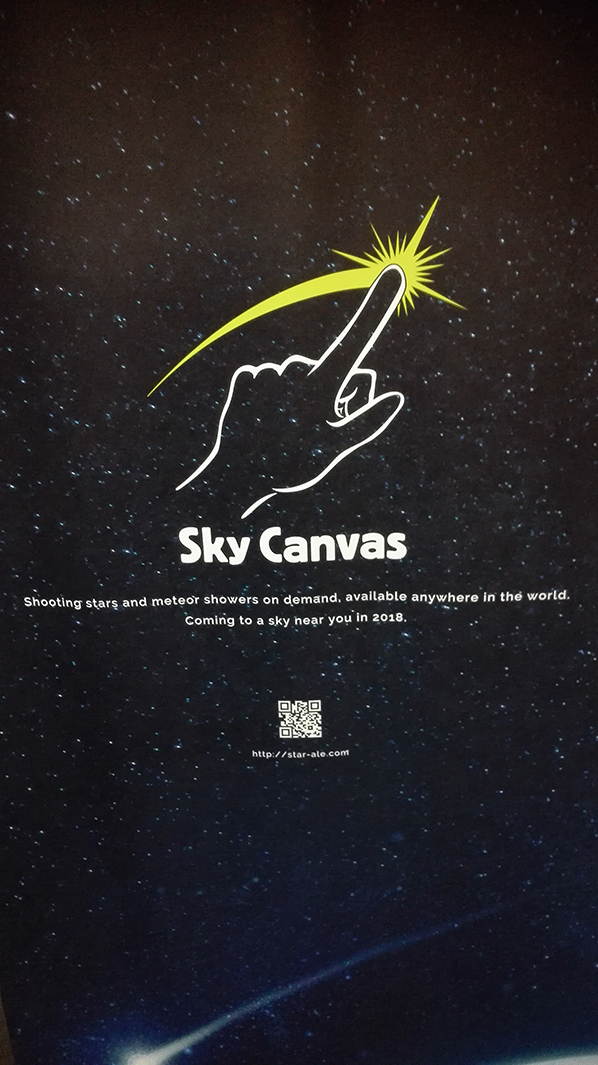
My favourite example of this was the disastrous ‘sky canvas: Shooting Stars. On demand’, an initiative to re-create the magic of a shooting star with satellite technology and glowing bits of plastic that can be shot into the night sky at the tap of a mobile app. The Alchemists of our time have fixed the magic of shooting stars. Great, thanks.
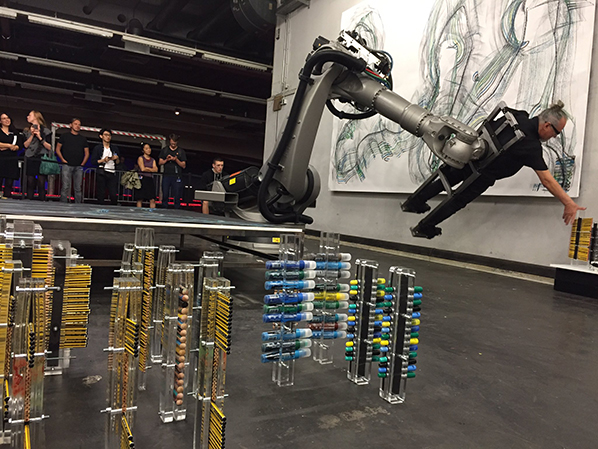
Much of the programme was better suited as light-hearted evening entertainment, drone racing, robot cooking, and endless drawing automaton. This robot, which I called ‘Human Pencil’ would throw around its inventor while he held 20 pencils and tried to make a drawing. Simultaneously inventive, pointless and entertaining; these robotic meme installations are better suited to robot fail video compilations on YouTube than to an art exhibition. The rejection of a critical consideration or a socio-political framing of the role of technology leads to what I call ‘enchantment art’, where the same devices used to execute mass killings in war zones become family friendly evenings entertainment.
Congratulations Dragan Ilić & team. Next performance at 10pm #Arselectronica16 #Artandscience @ArsElectronica pic.twitter.com/HgYXEctsYN
— GV Art (@GV_Art) September 8, 2016
So how has Ars Electronica, one of the longest standing and biggest media arts festivals in the world, found itself so far distanced from the political concerns surrounding technology? The first reason perhaps is that science does not bode well with critical theory. Many of the projects at Ars Electronica (again, excluding the CyberArts exhibition) feel like science museum artefacts that simply demonstrate technical (in)capability.
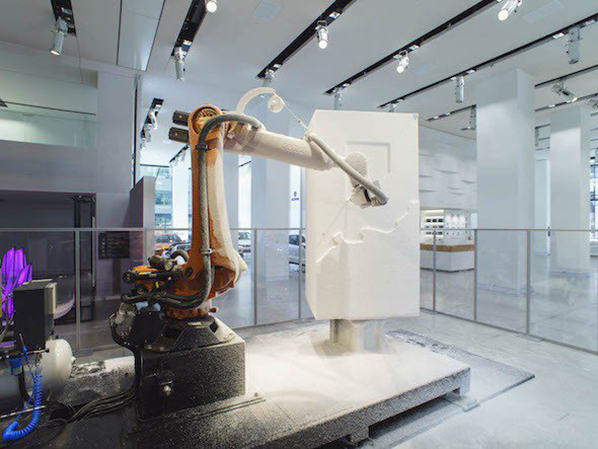
This attitude can be personified by the man I saw wearing a t-shirt stating “SCIENCE – It works, bitches”. Take for example this robotic arm reprinting Michelangelo sculptures which can only underline the immense technical potential of technology. Another possible reason perhaps that many of the works at Ars lacked social awareness is because they are produced by scientists & programmers in isolated laboratories. In this working methodology the viewer is rarely considered apart from in user tests, case studies and de-bugging. I found many maker lab types standing next to their large laser cutters avoiding eye contact while they printed out modular components and hoped for the next entrepreneur to walk past and slam down an investment fund. The lack of social awareness and engagement of issues surrounding our time have begun to impinge on the festival itself and an awareness campaign called #kissmyars is voicing concerns over the lack of female representation at the festival, particularly in the prix art prize which is awarded to men 9/10 times. The gender diversity in technology sector should no longer be ignored; this is one example of a socio-political issue not only overlooked at the festival program but also exacerbated by the organisation itself. I hope that the #KissMyArs campaign will not only rebalance the gender inequality at the event but also encourage the organisers to address other alarming realisations that operate within and around the application of technology in the social, political and economic sphere. Perhaps the Alchemists of our time should stop staring into the night sky planning the next life saving app and begin addressing the issues that applications can’t fix.
#KissMyArs
Leila Johnston was Rambert Dance company’s first ‘digital creative in residence’ from October 2015 – February 2016, having successfully applied to their residency programme, Sprint. The programme aims to enable Rambert to engage more deeply with the digital world, and is framed as experimental and light touch, with no expectations or goals in mind. One of the outputs of Leila’s residency – and the subject of this review – was a report ‘Hacking Rambert’, an incisive account of Leila’s time on Sprint, as well as a reflection on the nature of the creative residencies, dance and technology cultures.
Leila describes herself as an outspoken critic of current technology culture, resistant to its tendency for ‘digital evangelism’. The report belies her frustrations with technology culture – and indeed is a call to arms for rethinking what that culture needs to become. Her approach to the residency reflects this, emphasizing that its value came from bringing her critical perspectives about tech culture to bear, as much as from introducing dancers to ‘tools’ (though this played an important role too). She stresses how opportunities for growth and learning arose ‘through people (and sometimes tech)’ (my italics), and places human interaction and collaboration at the forefront, alongside, if not over and above, hardware and software. Dance is, she says, ‘about extraordinary relationships on every level – with yourself and then the little halo of space around you at all times, and then with greater and greater halos until it’s with everyone you meet.’ People are at the centre of her thinking and writing, and her residency was underpinned by questions such as ‘Is there a way to use technology to do justice to the human lifetimes that go into dance? Is there a way to dignify individuals, to invite confrontations with real people, to respect something other than the movement and acknowledge the part that individual experience plays in the construction of dance?’
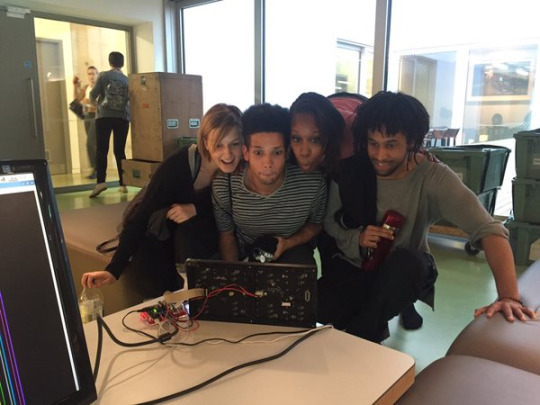
Reflections on the cultures of the dance and technology worlds are also central to the report. Leila was struck by the relative openness and accountability of the dance world, which she saw as ‘a home that opens its doors to anyone that knocks’, in contrast to self-aggrandizing, solution-focused, often misogynistic digital world that is so well equipped to sell itself and its benefits. One of the observations that fascinated me most was about the different approaches to labour in the dance and digital worlds. For the former, hard work is a celebrated and central driver – dancers are ‘efficient’ because no work is seen as wasted. By contrast, the digital world wants to recover ‘free time’ by getting the hard stuff out of the way. While tech wants to make things easier – dance wants to make them harder – so that difficulties and limitation can be mastered and overcome.
The dominant tech world rhetoric that technology – coding especially – is ‘for everyone’ is thrown into relief by its absence in the dance world, where no one would expect ‘everyone’ to be a brilliant dancer, since this is something that requires a lifetime of grit and dedication as well as the right body and innate talent. Leila shows us that we can learn from the dancers’ dedication and commitment that ‘not everyone can do anything, and that there are pursuits that arise from the nuanced world of individual lifetimes and personal, emotional, motivation, the results of which don’t resolve into a formula’.
Although her emphasis was on criticality and personal relations, she drew on an impressive range of kit. She experimented with a thermal camera attached to her iPhone, which enabled her to explore a ‘dance of heat’. She observed that ‘the idea that dancers can be expressed as their invisible heat is strange, but absolutely real’.
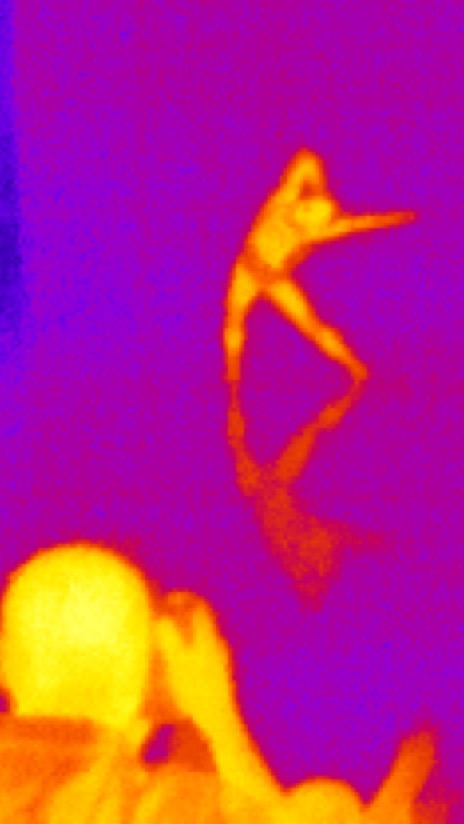
The Point Cloud demo on the Kinect was of great interest to the dancers, for whom it allowed a new kind of 360-degree vision, useful since they are ‘always looking for their own back’. Leila experimented with a Raspberry Pi, using it for a range of experiments including connecting LED panels where she could display words and video. Again though, as well as the tool itself, the Pi gave rise to critical reflection: ‘Why aren’t we teaching dancers and choreographers creative technology skills for their work, rather than reinforcing a hierarchy of expertise by ‘advising’ them on creative direction?’ Emphasizing how accessible and readily available Pis, LED panels and other technologies now are, Leila makes the point that maker culture can be embedded in the dance world at little cost, but this won’t happen organically unless more awareness of each other’s culture is fostered.
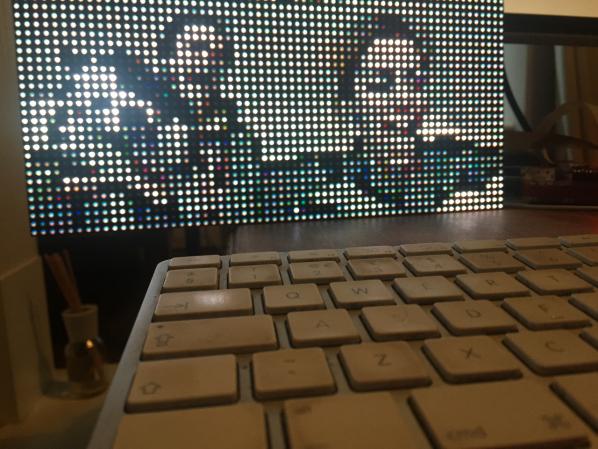
Drawing from the residency blog hackingrambert.tumblr.com, Leila reflects on time, truth, and difficulty. She is resolute that time, patience and commitment are needed to make meaningful artistic contributions, and that artists undertaking short term residencies need to be realistic about what can be achieved. Rather than gunning for a finished product, ‘short projects should be about making – what it means to be a creative, and what we learned about the best way to do things in the context of the artificially short creation time.’ Unlike the tech world, quick fix and solutionism will not fare well on a creative residency.
Leila’s reflections on the notion of truth are intriguing; she feels that there is ‘nowhere to hide’ in dance, and draws a parallel between dancers’ bodies and the ‘technical authenticity’ of circuit boards and wires. These forms of hardware offer respite from the slick interfaces that are so characteristic of digital technologies. She notes: ‘I’m interested in the relationship between truth and performance; the unique way in which (dance) performances are honest, how our bodies give away the truth, how things represent what they are very transparently’. These explorations of truth provoke rich questions about authenticity, identity, ‘fidelity’ and representation. The notion of the stripped back body is a striking one, and when one observes a dancer in motion, with their muscles, sinews, bones, sweat, and humanity on display, there can be a powerful connection between the dancer and the audience. However, there is artifice at work in dance too – creating illusions with the body, emphasizing certain lines, creating the appearance of fluidity and ease when the body is being pushed to its physical limits. Can we draw an analogy here to the performance of identity online, where the blood, sweat, tears and humanity are often glossed over with ‘choreographed’ images that appear spontaneous and perfect? Or is the truth of dance and bodies precisely an antidote to this phenomenon? My caution here would be that dancers have identities as well as bodies, and are not immune to the pressures placed on them about their appearance and representation.

Leila argues that the creative tech community needs to work harder to understand dance, but that dance too ‘has much to gain by creatively educating itself in the available tech options’. Introducing dancers and the dance world to creative technologies can be fruitful, but should not be understood in solutionist terms. Technologists must take responsibility for the enormous power they have in society – it is up to them to ‘educate and differentiate’ between the potentially homogenous mass that is ‘technology. Finally, she makes a case for ‘contemporary creative technology’. The notion of the contemporary connotes the historical nature of a given art form and the contingencies of its evolution – conceptually, technically, physically, socio-politically. The relative nascence of technology, she suggests, leaves it unanchored, and subject to the intentions of ‘commercial forces’. She states ‘A contemporary creative technology could lay down the microphone of narrative and exist in the depths of the present. We could stop writing our own story in the cultural canon – indeed stop telling stories about what we’re doing at all – and focus on being demonstrable and accountable.’
There are moments when Leila seems to idealize the dance world as relatively problem-free, without acknowledging its potential problems – not least the subjection of bodies to punishing regimes and the mental and physical problems this can give rise to, and issues of social inequality, accessibility and exclusivity that come with all creative industries. However, there is clearly a lot the technology world can learn from the culture of dance. Perhaps the tech sector should start having dancers in residence…
Basic Income is often promoted as an idea that will solve inequality and make people less dependent on capitalist employment. However, it will instead aggravate inequality and reduce social programs that benefit the majority of people.
At its Winnipeg 2016 Biennial Convention, the Canadian Liberal Party passed a resolution in support of “Basic Income.” The resolution, called “Poverty Reduction: Minimum Income,” contains the following rationale: “The ever growing gap between the wealthy and the poor in Canada will lead to social unrest, increased crime rates and violence… Savings in health, justice, education and social welfare as well as the building of self-reliant, taxpaying citizens more than offset the investment.”
The reason many people on the left are excited about proposals such as universal basic income is that they acknowledges economic inequality and its social consequences. However, a closer look at how UBI is expected to work reveals that it is intended to provide political cover for the elimination of social programs and the privatization of social services. The Liberal Party’s resolution is no exception. Calling for “Savings in health, justice, education and social welfare as well as the building of self-reliant, taxpaying citizen,” clearly means social cuts and privatization.
UBI has been endorsed by neoliberal economists for a long time. One of its early champions was the patron saint of neoliberalism, Milton Friedman. In his book Capitalism and Freedom, Friedman argues for a “negative income tax” as a means to deliver a basic income. After arguing that private charity is the best way to alleviate poverty, and praising the “private … organizations and institutions” that delivered charity for the poor in the capitalist heyday of the nineteenth century, Friedman blames social programs for the disappearance of private charities: “One of the major costs of the extension of governmental welfare activities has been the corresponding decline in private charitable activities.”
To Friedman and his many powerful followers, the cause of poverty is not enough capitalism. Thus, their solution is to provide a “basic income” as a means to eliminate social programs and replace them with private organizations. Friedman specifically argues that “if enacted as a substitute for the present rag bag of measures directed at the same end, the total administrative burden would surely be reduced.”
Friedman goes on to list some the “rag bag” of measures he would hope to eliminate: direct welfare payments and programs of all kinds, old age assistance, social security, aid to dependent children, public housing, veterans’ benefits, minimum-wage laws, and public health programs, hospitals and mental institutions.
Friedman also spends a few paragraphs worrying whether people who depend on “Basic Income” should have the right to vote, since politically enfranchised dependents could vote for more money and services at the expense of those who do not depend on these. Using the example of pension recipients in the United Kingdom, he concludes that they “have not destroyed, at least as yet, Britain’s liberties or its predominantly capitalistic system.”
Charles Murray, another prominent libertarian promoter of UBI, shares Friedman’s views. In an interview with PBS, he said: “America’s always been very good at providing help to people in need. It hasn’t been perfect, but they’ve been very good at it. Those relationships have been undercut in recent years by a welfare state that has, in my view, denuded the civic culture.” Like Friedman, Murray blames the welfare state for the loss of apparently effective private charity.
Murray adds: “The first rule is that the basic guaranteed income has to replace everything else — it’s not an add-on. So there’s no more food stamps; there’s no more Medicaid; you just go down the whole list. None of that’s left. The government gives money; other human needs are dealt with by other human beings in the neighborhood, in the community, in the organizations. I think that’s great.”
To the Cato Institute, the elimination of social programs is a part of the meaning of Universal Income. In an article about the Finish pilot project, the Institute defines UBI as “scrapping the existing welfare system and distributing the same cash benefit to every adult citizen without additional strings or eligibility criteria”. And in fact, the options being considered by Finland are constrained to limiting the amount of the basic income to the savings from the programs it would replace.
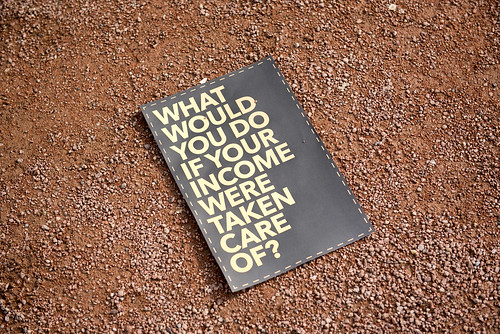
From a social welfare point of view, the substitution of social programs with market-based and charitable provision of everything from health to housing, from child support to old-age assistance, clearly creates a multi-tier system in which the poorest may be able to afford some housing and health care, but clearly much less than the rich — most importantly, with no guarantee that the income will be sufficient for their actual need for health care, child care, education, housing, and other needs, which would be available only by way of for-profit markets and private charities.
Looking specifically at whether Friedman’s proposal would improve the conditions of the poor, Hyman A. Minsky, a renowned and highly regarded economist, wrote the “The Macroeconomics of a Negative Income Tax.” Minsky looks at the outcome of a “social dividend,” which “transfers to every person alive, rich or poor, working or unemployed, young or old, a designated money income by right.” Minsky conclusively shows that such a program would “be inflationary even if budgets are balanced” and that the “rise in prices will erode the real value of benefits to the poor … and may impose unintended real costs upon families with modest incomes.” Any improved spending power afforded to citizens through an instrument such as UBI will be completely absorbed by higher prices for necessities.
Rather than alleviating poverty, UBI will most likely exacerbate it. The core reasoning is quite simple: the prices that people pay for housing and other necessities are derived from how much they can afford to pay in the first place. If you imagine how housing is distributed in modern capitalist society, the poorest get the worst housing, and the richest get the best. Giving everyone in the community, rich and poor alike, more money would not allow the poorest to get better housing, and it would just raise the price of housing.
If UBI came at the expense of other social programs, such as health care or child care, as Friedman intended, then the rising cost of housing would draw money away from other previously socially provisioned services, forcing families with modest incomes to improve their substandard housing by accepting worse or less childcare or healthcare, or vice versa. A disabled person whose mobility needs requires an additional expenditure on accessible housing may not have enough of the basic income left for any additional health care they also require. Yet replacing means testing and special programs that address specific needs is the big idea of UBI.
The notion that we can solve inequality within capitalism by indiscriminately giving people money and leaving the provisioning of all social needs to corporations is extremely dubious. While this view is expected among those, like Murray and Friedman, who promote capitalism, it is incompatible with anticapitalism. UBI will end up in the hands of capitalists. We will be dependent on these same capitalists for everything we need. But to truly alleviate poverty, productive capacity must be directed toward creating real value for society and not toward “maximizing shareholder value” of profit-seeking investors.
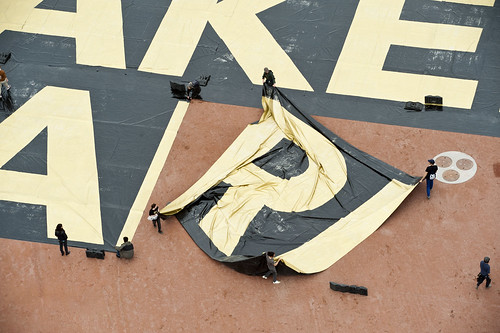
Many people don’t dispute the fact that establishment promoters of UBI are only doing it to eliminate social programs, but they imagine that another kind of basic income is possible. They call for a basic income that disregards the “deal” that Charles Murray advocates but wants UBI in addition to other social programs, including means-tested benefits, housing protections, education and child care guarantees, and so on. This view ignores the political dimension of the question. Proposing UBI, in addition to existing program mistakes, a general consensus for replacing social programs with a guaranteed income for a broad support base for increasing social programs. But, no such broad base exists.
Writing in 1943, with the wartime policies of “full employment” enjoying wide support, Michal Kalecki wrote a remarkable essay entitled “The Political Aspects of Full Employment.” Kalecki opens by writing, “a solid majority of economists is now of the opinion that, even in a capitalist system, full employment may be secured by a government spending programme.” Though he is talking about full employment, which means an “adequate plan to employ all existing labour power,” the same is true of UBI. Most economists would agree that a plan to guarantee an income for all is possible.
However, Kelecki ultimately argues that full employment policies will be abandoned: “The maintenance of full employment would cause social and political changes which would give a new impetus to the opposition of the business leaders. Indeed, under a regime of permanent full employment, ‘the sack’ would cease to play its role as a disciplinary measure. The social position of the boss would be undermined, and the self-assurance and class-consciousness of the working class would grow.”
The conflict between the worker and the capitalist, or between the rich and the poor, can not be sidestepped simply by giving people money if capitalists are allowed to continue monopolising the supply of goods. Such a notion ignores the political struggle between the workers to maintain (or extend) the “basic income” and the capitalists to lower or eliminate it to strengthen their social position over the worker and to protect the power of “the sack.”
Business leaders fight tooth and nail against any increase in social benefits for workers. Under their dominion, only one kind of UBI is possible: the one supported by Friedman and Murray, the Canadian Liberal Party and all others. They want to subject workers to bosses. The UBI will be under constant attack. Unlike established social programs with planned outcomes that are socially entrenched and difficult to eliminate, UBI is just a number that can be reduced, eliminated, or allowed to fall behind inflation.
UBI does not alleviate poverty and turns social necessities into products for profit. To truly address inequality we need adequate social provisioning. If we want to reduce means testing and dependency on capitalist employment, we can do so with capacity planning. Our political demands should mandate sufficient housing, healthcare, education, childcare and all basic human necessities. Rather than a basic income, we must demand and fight for a basic outcome — the right to life and justice, not just the right to spend.
Techno-feminisms are, once again, on the ascent. The Xenofeminist Manifesto, published in 2015 by the collective Laboria Cuboniks, is a provocative and elaborate example for the renewed exhortation for gendered bodies to merge with technology, rationality and the sciences in order to defeat white supremacist patriarchal capitalism. Cornelia Sollfrank, a practising technofeminist artist with a long history and rich experience in building and contributing to cyber-feminist-net-art platforms and organisations, and Rachel Baker, a former ‘net artist’ currently involved in collaborative feminist performance and writing practices, are curious: What drives the resurrected hype around techno-feminisms? What is new about the future 30 years after Cyberfeminism? Will the current techno-feminist virus take hold? Or has recent history resulted in an aesthetic immunity to the strategy of “seductive semiotic parasites?”
CS: Who is Laboria Cuboniks? How did you meet and why did you decide to work together?
LC: We are currently six women spread across three continents, all coming from different disciplinary backgrounds which gives us access to cover a broader territory of thought than working alone, and also provides us an intensive context for sharing our discrete approaches. We met in 2014 at a summer school in Berlin (Emancipation as Navigation) – which was equally a transdisciplinary affair focusing on developments in neo-rationalism. We decided to work together to address the rather quick, dismissive reactions that were circulating at the time surrounding neo-rationalism and accelerationism, as being de facto (and permanently so) cis-white masculine pursuits. While the historicity of some of these ideas most certainly does fall into that category, the consequences of brushing off things like reason, science, technology, and scalability as being enduringly locked into patriarchal regimes, seemed to us a serious limitation when trying to think an emancipatory politics and its necessary feminisms, fit for an age of planetary complexity.

CS: It hardly needs mentioning that there has been a feminist history of reclaiming reason, science and technology. In your Xenofeminist manifesto (XF) [i] you are alluding to both earlier technofeminist concepts, including cyberfeminism, but also to accelerationist ideas. What is your challenge, if any, adding a feminist agenda to a philosophical project that has largely been based on ignoring gender issues? Would XF have ever come into existence without accelerationism?
LC: Certainly the original Accelerationist Manifesto (MAP) did nothing to address gender politics, in a way mirroring its Marxian tones insofar as Marx himself also ignored gender and the types of labour (specifically care and reproductive labour) associated with a binary gender structure to which females have historically been subject to. MAP was a manifesto, which, by form alone is forthright; cannot address everything and is scant on nuance. Our own manifesto is no different in that regard. What we read from it, rather, was a demand for a scalar approach to leftist politics that can affirmatively face up to our situation systematically – the scope of which necessitates massive collective and collaborative mobilisation (which further entails the de-demonizing of the word ‘power’ as it is often portrayed in purely horizontalist approaches). XF responded to some of the general diagnoses mapped out in the MAP, but in its own terms, and opened up other territories for thought neglected by MAP. It’s instructive here to use this as a fruitful example against the type of puritanism that seems to be plaguing much of leftist efforts of late. When we don’t agree with every point, when we are offended at others, when we put all interpretive emphasis on authors’ biographies, we can end up dismissing entire thought-projects in one shot – rather than working out conceptual / pragmatic weaknesses and directing them, augmenting them otherwise. To be clear this isn’t about being conciliatory and taking every position on board – that would be pure triviality – but it is to say that we on the left desire some general transformations. How can we move beyond the game of ‘being right/superior’, of being locked into certain theoretical dogmatisms, of pissing perimeters around intellectual territories for our personal success in the name of a leftist-fashionability, towards the construction of useful concepts that can honestly respond to our complex reality? None of these concepts will ever be possible by a single ‘heroic’ actor/thinker.

CS: I can understand the desire to leave theoretical dogmatisms behind. This is also what we have tried with the Old Boys Network: to open up the term cyberfeminism and offer a platform where diverse and even contradictory concepts could meet. This entails, however, the problem of creating a common ground which is needed for collective agency… Some of the basic claims of accelerationism – that you are sharing – affirm an emphasis on rationality, universalism and self-mastery as well as the dismissal of traditional leftist political beliefs in micropolitics, direct action, inclusiveness, autonomous zones, politics of localism and horizontalism. Therefore, I’m wondering what agency could mean in a xenofeminist context.
LC: These ‘traditional’ leftist forms are only one side of the coin – the ones you mentioned seem more recent historically speaking, but there is also a long history of counter-hegemonically proportioned leftist activity. The danger in binding a leftist politics strictly and solely to a politics of immediacy (presentness, localisation, horizontalism, etc.) is that it seems ineffective at tackling globally-scaled systemic injustices (both structurally and ideologically), often existing in affective or symbolic form alone. The said, all politics occur in a local form – and that’s why a total dismissal of ‘localism’ does a great disservice to the ultimate task at hand (what we might envision as a postcapitalist turn) – but of course it cannot operate in isolation (as many of those with an investment in localist politics themselves acknowledge). The point is to articulate a politics that has the capacity to move between these scales that are commensurate with global reality, constructing vectors of connectivity that transverse these localisations (not only with regards to humans, but to things and disciplines of knowledge as well). Transiting between such scales (between the concrete here and now, and the untouchable, yet thinkable abstract) is a requirement for 21st century emancipatory politics, involving an expanded conception of ‘specificity’, ‘particularity’ and ‘situatedness’. These have been (and continue to be) crucial, contra-modern concepts developed in-large by feminist, post-colonial, queer and sub-altern discourses, but, like every theoretical proposition, have perspectival limits and require bootstrapping within larger ‘field’ conditions. Every difference or particularity exists in relation to something else, it’s embedded so it cannot be extracted and analysed in isolation. The more complex political question to us seem not only identifying/describing (or locating) a site, particularity or identitarian difference, but looking towards the field context as a kind of glue; that is, to approach the field context in which those situated differences experience structural discrimination or unjust advantages and to contemplate how that field context can be manipulated otherwise.
CS: I see your point, and I think it is exactly the complexity of the global situation which makes it impossible to come up with the one universal theory – which is what you are demanding?
LC: The demand would certainly never be for ‘one’ universal theory, but rather for a new theory of what a universalism on the left could mean today. The concept itself needs to be reformulated if it is to signify a non-totalitarian totality. This is where the metaphor of seeing the universal not as a top-down schematic, but as a type of artificial ‘glue’ that needs to be constructed is useful. The universal needs to be seen more as a kind of hosting condition; it is not ‘there’ to be unveiled; it is not a diagram to plug-into; it is an abstraction we urgently need to create in order for maximal human and non-human solidarities to be forged.
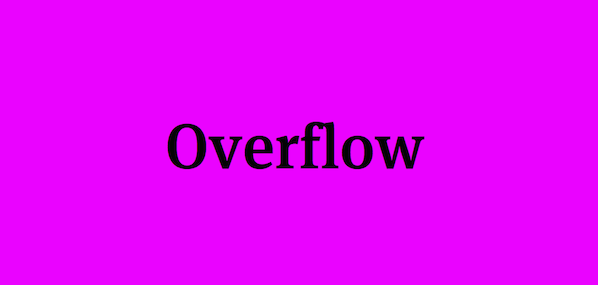
CS: Obviously, these ideas of universalism, totality, abstraction and scaleability are adopted from accelerationism that, nevertheless, remains somehow unaccomplished without gender politics? Is this the reason that you have set out to renew technofeminist thinking?
LC: One of the most pernicious critical reflexes against accelerationism (and we need to be clear we are talking about left-accelerationism) was that it was a Futurism 2.0, based on techno-utopianism and brute, masculine virility. While no one is trying to ‘enlist’ people for the accelerationist cause (some amongst us find the term itself quite misrepresentational to the project it espouses), we felt it was necessary to mine the field in two directions: to see what could be usefully applied to contemporary gender politics, and heighten the techno-feminist lineages of several claims made in the MAP. There are a myriad of points in which accelerationist politics intersect with (and are indebted to) feminist thinkers – as for instance with Judy Wajcman’s insistence that technology will neither save us, nor enslave us; but it requires refined analysis in the context of how it is used. Such a position echoes claims made in the MAP that advocate for an examination of the affordances of particular technologies rather than outright celebration or dismissal. Other thinkers associated with the neo-rationalist strand of left-accelerationism, like Ray Brassier, also tend to reverberate certain historically feminist positions, like the Promethean feminism of Shulamith Firestone when addressing the project of refashioning the human; or his emphasis on the use of abstraction for human cognition which also draws upon someone like Donna Haraway as a response to theoretical limitations ushered in via postmodernist positions.
CS: I guess tracking the feminist lineages of accelerationism could be an adventurous project in itself. For reasons of practicality, let’s stay with one example here. Building on Donna Haraway’s anti-naturalist Cyborg Manifesto (1983)[ii], cyberfeminists claimed to rebuild and repurpose technology in order to apply it for emancipatory purposes. At its core, the Cyborg Manifesto is about deconstructing traditionally Western antagonistic dualisms such as human-animal/machine and physical/non-physical. Haraway shows the taxonomic function of such categorisation and how it has been used to identify and construct “the other” in order to establish unjust power relations. She also emphasizes the importance of new technologies as playing an essential role in addressing, challenging and overcoming these dualisms. How does XF exceed this theoretical framework?
LC: We are quite theoretically aligned to the complexities inherent in Haraway’s work – cyborgian concerns – which examine human/machinic coupling adapted to an age where that coupling isn’t necessarily restricted to silicon chips and hardware, but it equally refers to the very ability to hack one’s biological/endocrine operating system. What we glean from such an understanding, is that we can’t simply ‘invest’ in the virtuality of online being as an emancipatory category unto itself, and we need to focus on how virtuality can be better interfaced with material existence. Furthermore, the sprawl-like functioning of online life has since been consolidated by a movement of deep centralization (mainly one search engine, one shop, one social media platform, etc.), so our collective efforts require systemic consideration. We need to conceive of larger structures of governance/justice that are commensurable with these new couplings; we need to focus on the construction of a milieu where the real and virtual, abstract and concrete couplings are politicized towards an emancipatory horizon.

OBN Readers (1998, 1999, 2001). Available online at www.obn.org
CS: Your manifesto stands in the tradition of a whole series of feminist manifestos like the Manifesto of Futurist Woman (1912), the SCUM Manifesto (1969), the Black women’s Manifesto (1970), the BITCH Manifesto (1972), the Cyberfeminist Manifesto for the 21st Century (1991), any many more [iii]. The cyberfeminist alliance Old Boys Network, however, agreed in 1997, at the end of the first Cyberfeminist International, to undermine the character of a proclamation by publishing an anti-manifesto… Why did you return to the traditional form of a manifesto – including its limitations – while at the same time claiming that what is needed is a refined analysis of technology in the context of how it is used?
LC: The manifesto, above all, gave us a highly compressed form through which to achieve a maximal libidinal engagement with ideas. There’s a reason why this form seems to be proliferating of late across movements; it’s quick to read online and can be readily shareable in snippet form. Those stylistic and factors of dissemination played a crucial role in deciding to write in an aphoristic way. As Sarah Kember puts it in her recent work on “iMedia”, the writing strategies common to manifestos ‘serve as hinge points between description and reinvention, art and activism, critique and creativity, writing about and writing out’. As such, there is still a great deal that the manifesto can do.
CS & RB: This takes us to the question of strategy. You are describing your strategy as the creation of “seductive semiotic parasites,” and we are wondering, if you understand your manifesto as a fictional scenario, or rather as political theory. We noticed, for instance, that you refer to ‘hyperstition’, a term originally employed in the mid-90’s to describe auto-loading ad windows during the delay incurred when the browser loads the main content – i.e what happens in the gaps created by the central activity. More latterly, it was used as an allusion to the practices of computer-based networked literatures (cf Simon Biggs, ‘The Hyperstitial Poetics of Media’) of which there is a notable precedence (Doll Yoko, Mez Breeze, Mark Amerika… etc). What can these linguistic forms and fictions achieve in terms of a politics? What can fiction writing and the creation of myths as literary forms achieve in terms of politics?
LC: We reference ‘hyperstition’ directly only one time in the text. It’s a disputed concept within the group; disputed not in the sense that it doesn’t ‘exist’, but disputed in terms of its operability or the ways in which hyperstition could be guided. The signification you mentioned is a bit foreign to us – we’ll have to check that out! But as far as we used it, it was to indicate the process whereby fictional entities become real. We can see many instances of this phenomenon at work, especially in finance where the sheer (collective) belief in a future occurrence can instantiate that very event, as in speculation. It is one thing to identify existence of hyperstitional operators, but it is another to understand and possibly leverage this type of novel causation they seem to exhibit. So, it’s not a phenomenon one can simply ‘celebrate’ as such. Some of the people – like Nick Land – who coined the term rather happily prognosticated dystopian visions as a result of its deterritorialising force. If XF or any other emancipatory project is to strategize hyperstitionally, it seems that it would be most effective, when conceptualized through the lens of contemporary power operations. Why are some fictions able to permeate reality (and by whom) and why do others simply fade out? One of the main qualities of hyperstition, or these fictional operators is that you can’t quite pinpoint this causation as if it’s of a purely mechanical order with clear input and outputs. So, it’s never something that can be fully determined. The fact, though, that we can see these processes at work, cracks open the given for what it is – contingent and subject to change. That this ‘given’ is volatile to fictional operations, is a clear indication of the relationship between ideality and reality and of a need for future interventions to find ways to mobilise that dialectic without falling into the pitfalls of an either / or dualism.

RB: Ok, maybe to concretise this question a little – what are ‘hyperstitional operators’? Are they ‘memes’? And in what terrains would their ‘future interventions’ most significantly occur for XF? Upon what terrains, exactly, is the fictive, the semiotic, the hyperstitional, actually acting for XF? Does it ever meet a ‘realpolitik’?
LC: Hyperstitional operators could be a variety of things – but at least according to CCRU definitions they are ideas that enter and transform the flow of cultural reality – a kind of hype mutated into actuality. We don’t spend much time on hyperstition because there doesn’t seem to be an adequate understanding of how this engine works exactly, but perhaps a more useful way to illustrate the power of fiction upon reality, is to look at it through the lens of modelling practices. The study on the Black-Scholes model of options pricing (arguably one of the most important models ushering in financialisation) from the sociologist Donald Mackenzie is a really interesting case wherein the model – at first – had little correlation to pricing activities on the trading floor; but as the model gained traction, won a Nobel Prize and became a tool of the trade, reality started to conform to the predictions of the model. This is a simplification of a book-length study, but the point being that the uptake, or ‘performativity’ of the model produced a reality in its likeness, provoking Mackenzie to even close his book with the question “What sort of reality do we want to see performed?” Clearly, we are not advocating for more profit-imperative modelling innovations, but we can leverage this incredible potency differently since we know how effective it can be. Models don’t represent or merely ‘reduce’ reality; they are tools as the philosopher Margaret Morrison argues, to intervene in reality.
RB: There is a sense that accelerationism and XF is invested in the organisational techno-architectures of social programmes, in platform-building and scaling networks. If so, how can one avoid the bureaucratic traps of techno-social administration – like the coercion and (self) surveillance through data management – that are encouraged under the guise of ‘creative tech innovation’? In addition, how can one escape the internal race, gender and class hierarchies that are often so constitutive to open techno-collaborative platforms?
LC: The materialisation of the conceptual framework raised in XF is certainly the largest, most difficult task at hand, one that will require substantial collaboration outside of our group. The hope with XF is that it manages to conceptually infect others to experiment on this tangible level. We know that the development of technology is also a reflection of our own biases, limitations, needs, desires and perceptions of the world, so contaminating this perceptual or cognitive level, although not enough, is still an important step. Your question really points to the delicacy and riskiness of our current world where so many potentially beneficial innovations are twisted to serve the few, be it either through sheer profit gains or through the cultural capital of becoming an antagonistic hero. The gross demographic misrepresentation within the building of techno-architecture (not to mention access to it) is the most obvious, direct hurdle to leap in order to mould and retrain these structures to serve the many. There are no user-manuals as to how to avoid the hazards you mentioned, all of which are bound to ideological imperatives of our time (for profit and self-branding), so any radical overhauling of the purposes that technology may serve, is wholly dependent on the restructuring of our given ideological ‘myths’ or frameworks.

RB: Is Laboria Cuboniks intended as collective pseudonym for others to inhabit, in a similar way, for example, to Luther Blisset where a specific political tactic was applied through its availability as an open alias, or is it a more limited identification, akin to art group Bernadette Corporation which was always a specific core group of authors? How important is anonymity? Are there other groups you know of assuming the tenets of Xenofeminism as a discourse/practice? Do you envisage more Xenofeminist ‘chapters’ as a scaling strategy?
LC: Our name is an anagram of Nicolas Bourbaki, another collective pseudonym for group of largely French mathematicians from the 20th century advocating for abstraction and genericity in their field, so we playfully identify with them. As of now, the group is just the six of us, and, for the better or for the worse, anonymity was never achieved from the outset having launched the manifesto in person (without costumes and robot voices). In hindsight, the performative ‘appearance’ of Laboria could have been much more elaborately conceived and enacted – but as it is now, the importance must be placed on the labour of XF in general (open to anyone who wants to tinker, intervene, augment, refute and expand on these initial claims), and not on ‘Laboria’, the author. We’ve seen several groups and individuals respond to the manifesto – either through translation, dissemination, zine creation, talk-radio, inclusion in course readings, artistic practices and so on – and this is crucial to any ambitions of scaling up beyond our own finite capacities. Perhaps it would make sense to speak of ‘nodes and forks’ rather than ‘chapters’; ‘chapters’ seem to indicate a certain linear sequence that fulfils a narrative, whereas ‘nodes and forks’ affords a plurality of actants and events, piece by piece, deviation by deviation.

CS+ RB: Many thanks for clarifying some of our questions related to xenofeminism. The issues you address are urgent and we hope your manifesto will inspire technofeminist experiments on all scales and levels and contribute to the materialisation of more feminist concepts, particularly within the development of technology.
FREE Exhibition Tour and Artists Talk: Sat 18 June, 2-4pm
DOWNLOAD PRESS RELEASE (.pdf)
SEE IMAGES FROM ACCOMPANYING EVENTS
Featuring Gretta Louw, Lily Hibberd, Brook Andrew, Curtis Taylor, Jenny Fraser, Sharon Nampijinpa Anderson and the Warnayaka Art Centre.
Networking the Unseen is the first exhibition of its kind to focus on the intersection of indigenous cultures and zeitgeist digital practices in contemporary art.
While digital networks manifest physically as tonnes of cabling, and electrical or electronic devices, the social and cultural impacts of the networks remain somehow invisible, eroding clearly felt boundaries of geography, place, culture and language.
Together with artist and curator Gretta Louw, Furtherfield presents an exhibition and event series that brings together concepts and experiences of remoteness and marginalised cultures, with art-making in contemporary society.
Five culturally and geographically disparate Australian artists – Gretta Louw, Jenny Fraser, Lily Hibberd, Brook Andrew, and Curtis Taylor – and artists, including Neil Jupurrurla Cook, Isaiah Jungarrayi Lewis, and Sharon Nampijinpa Anderson from the Warnayaka Art Centre in Central Australia, present work situated at the intersection between avant garde digital, media, and installation art, the sociological study of digital and networked culture, and activism.
Networking the Unseen proposes a radical rethinking of widely accepted stereotypes concerning the impact of networks on contemporary global cultures, digital art, the avant garde, and indigenous art-making.
It tackles subjects ranging from digital colonialism and cultural marginalisation (or, conversely, diversity/empowerment) within an increasingly connected, online world to universal concerns around cultural change as a result of technological migration.
The exhibition extends our focus to the extremities of the global digital network. It subtly proposes ways to claim power back from centralising forces of control to use these tools for positive change; for intercultural exchange and empowerment for marginalised communities.
The Phone Booth Project, by Paris-based Australian artist Lily Hibberd and Martu indigenous filmmaker and artist Curtis Taylor, is a multimedia installation that demonstrates the intricate relationship between community and technology and how this is uniquely affected by local circumstance and environmental factors. Phone booths have all but died out in urban environments, and yet this beautiful and nuanced work, created in the Western Desert region of rural Australia with the indigenous Martu communities, highlights the vital role that they continue to play at the edges of the network – where cell phone reception is often non-existent, and landline phone connections in every house are an infrastructure expense that neither the locals nor the government is willing or able to carry.

Brook Andrew is an internationally recognised Australian artist whose practice in installation, print, neon, and performance often draws on his Wiradjuri indigenous heritage. In Costumes for the Cell (2012) Andrew’s instantly recognisable digitally-facilitated contemporary revision of a traditional Wiradjuri pattern – a powerful example of the blending of old and new culture; tradition and technology – becomes a moving installation as it is worn by performers at the opening.
Gretta Louw’s ongoing collaboration with artists from the Warnayaka Art Centre has produced the two video works Digital Desert and Is the Desert Still the Desert in a Digital World? in 2012, followed in 2014 by the YAMA project – an immersive, on-site multimedia installation built in the remote central Australian desert. The immersive installation at Furtherfield manifests the physical installation in wall paintings, screens, and light. It invites us to explore the nature of cultural change brought about by the arrival of advanced digital technologies.

Name That Beach, a video work by a fore-runner of the indigenous digital art movement Jenny Fraser, is programmed alongside works by emerging artist Curtis Taylor in a fascinating and inspiring insight into contemporary digital media art-making in Australia.

The works in the exhibition invites reflection by non-indigenous audiences on the techno-cultural change within their own society, and their individual relationship to internet technologies.
Exhibition Tour and Artists Talk
Saturday 18 June 2016 – 2-4pm – Furtherfield Gallery & Commons
Join Neil Jupurrurla Cook, artist and Director of the Warnayaka Art and Aboriginal Cultural Corporation, and Gretta Louw, artist and curator, for a curated tour of Networking the Unseen and then head down to Furtherfield Commons for a Show and Tell about their collaboration and work.
FREE – Limited places, booking essential (register)
Free family workshops at Furtherfield Commons
Every Saturday from 23 July to 27 August, 2-4pm
Fun, interactive workshops for local families aged 5 upwards.
Details to be confirmed – Register your interest here
Young digital artists residency at Furtherfield Commons
25 July – 5 August, Monday-Friday, 11am-4pm
Adventures in arts and technology for young people 13-18 living in or attending school in Islington.
Details to be confirmed – Register your interest here
Networking the Unseen – Selfies and Alterity
Thursday 4 August, 6-8pm – Furtherfield Gallery & Commons
6-6.45: Gretta Louw will give a tour of the exhibition Networking the Unseen at Furtherfield Gallery.
7-8 join us at Furtherfield Commons where she will present preliminary work on a Warlpiri (First Nations Australian) selfie and photo editing app, a collaboration with the Warnayaka Art Centre, and discuss the ways in which your emojis are not innocent, digital colonialism, and how selfies, social media, and alterity can be used for social good.
FREE – Limited places, booking essential (register)
Do It With Others – Art and Solidarity in the Age of Networks
Saturday 6 August, 12-5pm – Wysing Poly, Wysing Arts Centre, Bourn, Cambridgeshire.
With Ruth Catlow, Marc Garrett, Gretta Louw, Tim Waterman and They Are Here
This day long symposium explores art as a commons (defined as the cultural and natural resources accessible to all members of a society) in the age of networks and neoliberalism. How can the practices, circulation, appreciation and stewardship of arts be emancipated for all? Exploring tensions between digital inclusion and cultural diversity in the digital global hegemony.
FREE – Limited places, booking essential (register)
Brook Andrew is an internationally acclaimed Australian artist of indigenous (Wiradjuri) and Celtic descent. He has had significant exhibitions at world class institutions like the Museo Nacional Centro de Arte Reina Sofia and the Tate Britain, and been part of numerous international showcases, such as the Asia Pacific Triennial of Contemporary Art and the Asian Art Biennial. Andrew’s practice is intensely research-based, resulting in interdisciplinary works and immersive installations.
Jenny Fraser is a screen-based artist, curator, and educator. Her work utilises popular cultural references as a bridge to challenge viewers’ frames of reference. She redefines the art of curating as an act of sovereignty and emancipation, and founded the groundbreaking cyberTribe online gallery over a decade ago. A Murri of mixed ancestry, Fraser has received many accolades for her trailblazing work, most recently being awarded a prestigious Australia Council Fellowship in 2012 for her project Midden.
Lily Hibberd is an Australian artist and writer, working between Sydney and Paris. Her practice centres on marginalised people and histories and the restoration of memory through interdisciplinary collaborative social practice. Hibberd’s recent project include major exhibitions at the Musée des art et métiers (2015-16), Paris, and Spaced 2: Future Recall for Perth International Arts Festival (2015).
Gretta Louw is a multi-disciplinary artist and writer exploring the potential of art as a means of investigating cultural and psychological phenomena, particularly in relation to new technologies and the internet. Born in South Africa, she grew up in Western Australia and is currently based in Germany. Her work has been exhibited widely – in New York, Berlin, Jakarta, and Tel Aviv, amongst others – including in a number of public institutions such as the Kunstmuseum Solothurn, Stadtgalerie Mannheim, and Kunstverein Ludwigshafen.
Sharon Nampijinpa Anderson is an artist and educator and one of the directors of the Warnayaka Art and Cultural Aboriginal Corporation. Born near Mt Doreen in the Tanami Desert, Nampijinpa holds a degree from Bachelor College in Darwin, Australia has exhibited her art work widely, including at Galerie Yapa in Paris, Cooee Aboriginal Art Gallery in Sydney, and at the Darwin Aboriginal Art Fair. Nampijinpa is passionate about preservation of Warlpiri culture and has been involved in numerous projects to this end, such as the Arts Workers Extension Program in Australia and the production of the 2013 publication Warnayaka Art Centre: Life in the Digital Desert (Ed Gretta Louw).
Curtis Taylor is an emerging Martu Australian filmmaker and video artist. He has had screenings of his work at the National Gallery of Australia, the Fremantle Arts Centre, the Western Australian Museum of Art, and many more public institutions. Taylor is also currently involved in the VR film project, Collisions, which is debuting at the Sundance Film Festival.
Warnayaka Art Centre is a nationally renowned Australian indigenous (Warlpiri) art centre. The centre is home to a number of internationally successful Warlpiri painters including Lily Nungarrayi Hargraves and Molly and Rosie Napurrurla Tasman. Neil Jupurrurla Cook is the lead media and installation artist; he is the Director of the Warnayaka Art and Aboriginal Cultural Corporation and has shown his sculptural and media installations at the Darwin Art Museum.
Furtherfield was founded in 1997 by artists Marc Garrett and Ruth Catlow. Since then Furtherfield has created online and physical spaces and places for people to come together to address critical questions of art and technology on their own terms.
Furtherfield Gallery
McKenzie Pavilion
Finsbury Park, London, N4 2NQ
Visiting Information
For more than two decades, Italian artist duo Eva and Franco Mattes have sought to subvert and expose the systems which produce power. Their current exhibition, Abuse Standards Violations at Carroll/Fletcher gallery, looks at who and what is made visible and invisible in the process of producing culture for online consumption.
The artists, who did not receive a formal arts education, describe themselves as “a couple of restless con-artists who use non-conventional communication tactics to obtain the largest visibility with the minimal effort.” They repeatedly worry the edges of technical structures – legal, religious, software – observe the resultant content and feed it back into new structures. It’s a process which acknowledges and seeks to communicate erasure, loss and chaos as well as their inverses. In Abuse Standards Violations, the artists acknowledge that chaos, and slippiness of boundaries in the arrangement of work that collides fragments of different disciplines and practices together.
The central work in the exhibition is Dark Content. When their project No Fun (2010), presented unchallenged in a gallery, was removed from YouTube on the grounds of being ‘shocking and disgusting content’, the Mattes’ began investigating content moderation. The video, image and text content we encounter on platforms like Youtube is there because it has been permitted to be there. To gain permission, content once produced must be approved. The approval process involves a number of decision-making structures. The rules determining which content passes or fails (is good or bad, safe or unsafe) are built by, and entangled with, the organisational framework of the platform. To deploy this framework and enforce its rules, algorithms organise data and trace patterns, and people – working as ‘content moderators’ – are paid to decide which criteria a piece of content belongs to, and act accordingly.
Eva and Franco spoke to a number of content moderators about their work. These interviews give insight into a role which is simultaneously powerful and socially stigmatised (one moderator does not tell their partner what they do); which, despite actively forming culture, is in many ways concealed. Following the neoliberal pattern, process is skipped over to reach the content; moderators are scarcely mentioned by the culture in whose production they are thoroughly implicated. This is unsurprising given that the moderators are people like you and me, as well as being points through whom the governing structures of social media can be accessed.
The Mattes’ interviews with content moderators are presented in the exhibition as stock avatars, preserving the anonymity of the speakers; away from the exhibition, the interviews can be seen only on the Darknet. The avatars in Dark Content are displayed on screens within booths constructed from office furniture; structures designed for typing and filing are flipped around like tetris blocks to become a new kind of structure. The furniture is simultaneously recognisable, and out-of-place – particularly, no doubt to the freelance, self-employed person who often works from the sofa or cafe.
BEFNOED (Be Everyone For No One Every Day), deploys unusual positioning of screens in the gallery space. Visitors are required to lie on their backs, crouch down or otherwise contort themselves in order to watch videos of other people carrying out banal tasks such as putting a bucket on their head. The latter group of people has been paid for their work, the tasks having been advertised on crowdsourcing websites. Both groups have spent energy and time on their endeavours, and now both come together in a space. The intimacy is an interface which suggests the connectedness of gallery visitor and global networks and their mutual implication in the way culture is produced.
The works in Abuse Standards Violations relate and separate different lives, different cultures and different kinds of labour. They muddle contexts and objects, creating spaces and structures that are – clearly and disconcertingly – no less strange than those already available in contemporary society. These spaces and structures complicate the difference between reality and simulation. They also make the distribution of power painfully clear. For a powerful structure to appear trustworthy it is useful to appear impartial, logical, scientific; to appear trustworthy it is useful to destabilise or dismantle other structures by choosing what is made visible and what is not, what to make public and what to keep private. Those who are unfamiliar with the regulatory structures become implicated unknowingly. One of the moderators interviewed for Dark Content did not consider their work censorship since they worked for the government. Another comment ran along the lines of ‘I am only enforcing the rules; I don’t make them’.
In making clearer the arrangements of power behind YouTube, the arrangements of power in the art world – one of the routes to cultural production – are necessarily also challenged. The aesthetic choices the artists have made have clear social and political implications which create uncomfortable questions about concepts such as privacy. The complicated act of content moderation makes some information unavailable in order to communicate other information. This process is by no means limited to the world of content moderation – it applies wherever there is a message to pass on.
Invisible labour and visible outputs are separated by social stigma, sophisticated regulatory systems and other factors, local and global, which create a powerful invisibility. The works in Abuse Standards Violations combine objects, images, texts and concepts in surprising ways which give some substance to this invisibility. The job of the content moderator is part of culture, as is the expenditure of energy by bodies, as are rotas, as are company regulations, as are artists and galleries and gallery visitors. Thinking about how such things relate leads to challenging and powerful questions.
Abuse Standards Violations is at Carroll/Fletcher gallery in Soho until 27 August alongside Planetary-scale Computation by Joshua Citarella.
http://www.carrollfletcher.com/exhibitions/55/overview/
In this special feature Steve Jampijimpa Patrick writes about YAMA, the name given to the installation currently on display as part of the exhibition Networking the Unseen at Furtherfield Gallery.
* * * * * * * * * * * *
I want to tell you about YAMA. This is the Warlpiri word for a shadow, or reflection. It’s also a word that we use to describe a meeting or a meeting-place; we gather under a tree that casts a shadow (a reflection of its shape) onto the ground, and we talk in a group – both men and women together, equally – to make decisions and to reflect on ourselves and our lives. But it’s deeper, too. In yapa (Aboriginal) culture, if someone says “you don’t have a shadow”, it means you don’t exist. All the birds, all the small animals, trees – these things all have a shadow; all of your country and everything in it; this is your universe. How can you reflect your universe? And what about you, reader? Does your homeland reflect you?
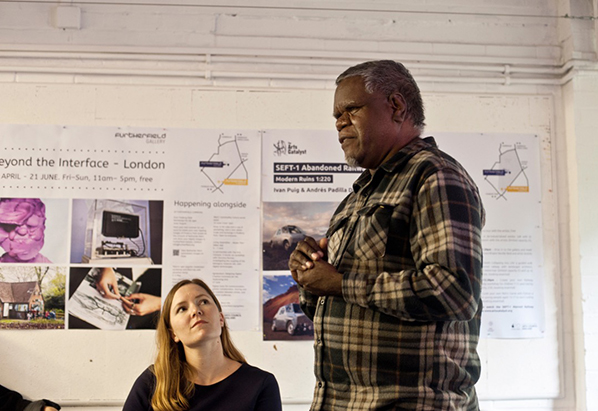
I’ve been all over the world, searching for ngurra kurlu (the home within). Each country’s, each people’s ngurra kurlu is different. If you don’t speak your language, if you don’t know your culture, the songlines of the animals in your country, how can you express yourself or where you’re from? This reflection happens through language, through dance, art, even food – that’s ngurra kurlu. There is a universe and we are its shadow.
We yapa say “don’t become Australian, become Australia”.
That’s ngurra kurlu.
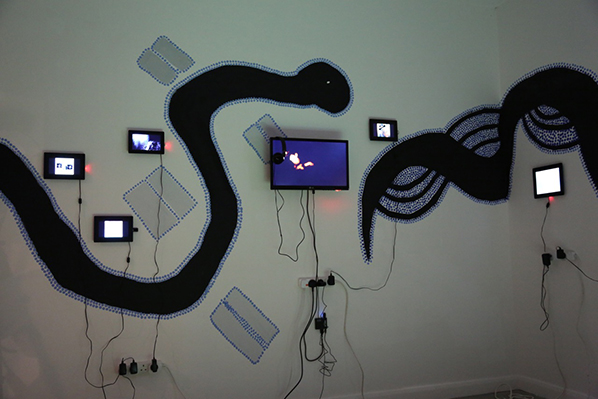
I am writing this from Germany, we (Neil Jupurrurla Cooke and I) were in England for a week working on YAMA, a multimedia installation with Napanangka (Gretta Louw) for the Networking the Unseen exhibition at Furtherfield. Every day we walked through Finsbury Park and the people we saw were really alive there, playing, walking, school children running through, watching the birds and the squirrels. But when we go into town, we feel closed up again. We went to the Horse Guard. Where I come from, the horses roam free – they are really alive. We don’t know their skin name , we don’t have a song for them because they’re feral animals, brought into our country by kardiyah (white people) – but they’re free. When we see the horses there in London trained to stand still like that, like they’re stone, we feel sad for them.
Then we look around and see those buildings round there (in Westminster). We’ve seen those buildings before. Even though we’d never been to London. They’re like underwater, you know, that coral when it dies – when it’s bleached – that’s what those buildings are like. Every thing, both living and created by the living, is a reflection of our universe. Imagine you are a little ant and you are walking through tombstones – this is how it feels for us to be in that place. I guess the people that made those towers are trying to express power, they want to have power over other people. They build those bleached towers and statues tall on columns to make the other people feel small. That’s a crazy world, when I’m coming at it from my culture.
Your home is going to reflect you and you’re going to reflect your home. So, think about your home and what it says about you.
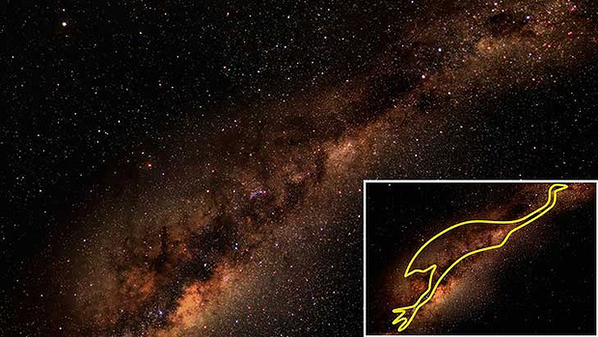
For us, the things we look up at are the stars. We’ve always known them and learned from them. They are part of our ngurra kurlu. What about that North star that you have here in the northern hemisphere – they say it doesn’t move. Maybe that’s why you have one leader, one queen, who doesn’t change. Down in Australia, we have five emus (the southern cross) – we live by that law. We call ourselves an emu country. You bear countries reflect your stars, too. I like to think that the queen is the ultimate kurlungu (guardian) for the country, but a kurlungu needs to really look after all their people and their country. Is that what’s happening in your country?
I wonder what would happen if you brought an emu up here and just let it walk around. I’ve never seen it but I think it might start heading south. We have a word for ocean, mangku-rla, even though we’re a desert mob. This shows how ancient our songlines are – they existed before us; they created us. We were supposed to be noble savages, from the settlers’ point of view we weren’t supposed to know about the ocean or what was on the other side, but our Emu Dreaming tells the story of the emu swimming across the ocean. He was a nervous emu because he was being chased into the water by dogs. I think that was when the emu went between the continents to make relations with the ostrich and the rhea bird and the moa. There were big, flightless birds like the emu on each of the continents. In the Jardiwanpa story, the emu comes out of the water and shakes himself like a dog. This is reflected in the stars as well; our emu stars (the English name is the Milky Way) come up after the wet season.
In yapa culture, we know that we didn’t create the body: our universe, our country created us. That’s why I am a black man from Australia – my country made me like this. This is what you call evolution. You can have bears in the north, and we have emus in the south. Our countries created those beings. Yapa have always known that this is how things are created.
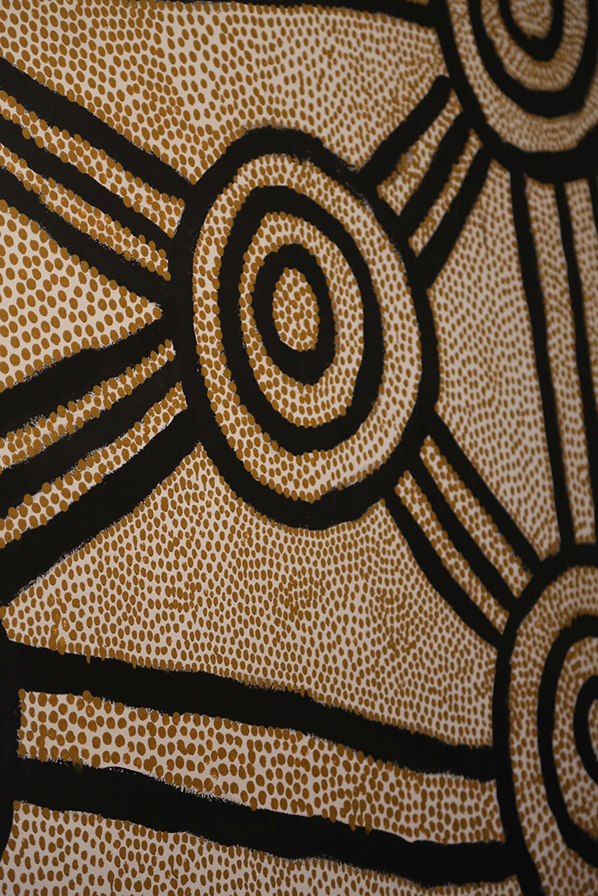
You live in the bear countries; even without people knowing it, they are reflecting what the bear is trying to teach them. We live by the emu. I can’t tell you what the bear is teaching you, I’d need to live here a lot longer, but you can learn to hunt the knowledge that the bear is trying to show you.
There are food sources for your stomach and there are some for your mind. Both are equally important. If you are hunting for goanna you bring it home and share it with your family and your community. If you are sitting, talking, learning that’s also hunting – you are hunting knowledge and you bring it home and share it with your people. The mind and the physical reflect each other – that’s yama.
The Australian coat of arms is meaningful to us, even though we weren’t asked to choose it. The emu is our teacher, wise and kind, and the kangaroo is like a warrior or a judge, strong and powerful. The nature of our land, our country, is reflected in this coat of arms. When I look at the English coat of arms, I see a lion and a unicorn. Do these animals come from your country? What does this coat of arms represent and what does it reflect about your country?


When I ask you to help me hunt the unicorn, will you understand what I mean?
Hunting the unicorn is a way to understand its ngurra kurlu, to try to understand the country and therefore to understand the people. After all, if you’re hunting something, you have to learn to think like the animal that you’re hunting. It’s a way to fit into the country and to feed on that country; that country nourishes you. That’s the most important skill you can have. It’s a skill to understand the prey, and to think like the prey. It’s something I never understood before. But now I do.
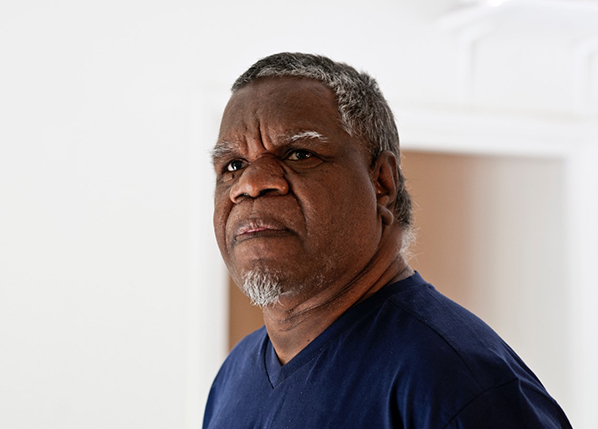
If you know how to reflect yourself, you can then reflect other people. Don’t try to do it back to front.
Join us on August 4th between 6 and 6.45 for an exhibition tour by Gretta Louw at the Furtherfield Gallery.
Then from 7-8pm, we will continue at Furtherfield Commons with Your Emojis Are Not Innocent: Selfies and Alterity, a presentation by Louw, in which she will present her upcoming collaboration with Warnayaka Art Centre to create a Warlpiri selfie and photo editing app, and a discussion about how selfies, social media, and alterity can be used for social good.
Gretta Louw is an artist, writer, and curator working predominantly with digital media, social practice, and networked performance, whose work explores the potential of art as a means of investigating cultural and psychological phenomena, particularly in relation to new technologies and the internet. For the last five years she has been deepening her research into cultural change brought about by, or happening in interaction with, digitalisation. She has a long standing collaboration with the Warnayaka Art and Cultural Aboriginal Corporation, a Warlpiri First Nations art centre in the remote community of Lajamanu in central Australia. The current exhibition at Furtherfield Gallery, Networking the Unseen, is a curatorial project born out of Louw’s collaboration with Warnayaka and Warlpiri artists like Neil Jupurrurla Cooke, Isaiah Jungarrayi Lewis, and Sharon Nampijinpa Anderson. The exhibition investigates themes of digital colonialism, contemporary indigeneity, digital and media art from outside the urban mainstream, and the ways in which digital media can be used either to perpetuate inequality or as a tool of social empowerment.
FREE – Limited places, booking essential (register)
In the second of three articles about the Web 2.0 photosharing service Flickr (the first is here), I continue to make a case for the quiet but profound innovations created by the sheer scale and ease of use, of these services – something which enables self defining artist, outsider artist, hobbyist & people who would run a mile from being called an artist to share and be mutually influenced by each others work. Here I offer some notes on the beautiful, funny and humane photography of London art teacher Joseph Cartwright, who operates under the Flickr name Noitsawasp.
Very few humans directly in these images but everywhere traces, evidence of human activity. Not cold. Full of humour.
Patterns of human activity, some accidental but capable of being invested with new meaning. Some straightforwardly meaningful, interpretable. Evidence of events and activities.
Always formally engaging.
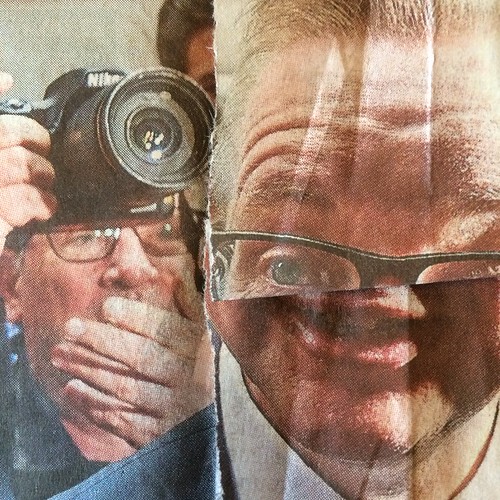
A map of a world. A map of our world. A map of the world of work, of most of us, of the 99%.
Impossible to imagine these images made on streets of a town where less than 50 languages were spoken.
What we see when we look at these is what we see when we look at art.
An invitation to narrative.
Patterns on the one hand // traces of the wake that humans leave behind them in the world.
One of those humans is Joseph C––sometimes the images are records of his interventions in the world of images––those image fold-overs or blends. Sometimes the photos are a record of him as performer, actor, in the world ( but after he has left the stage). Sometimes they seem to place us directly behind his eyes.

I think he looks quizzically at the world. Do you know him––does he look quizzically at the world?
You imagine his eyes darting around––down, to the side, up occasionally, lighting on something, some congruence of objects, pausing to decide whether to make an image…(brows knotted, a sense of pressure, the need to seize the moment…)
look at this; see through this; look into that; make that out
grids; grids; patches of light; a dictionary of cowboy terms
People nail nails, people mend things, people bend things, people break things, people clean, people wash clothes, people read, people admonish, people alert, people have funny feelings––goose bumps, shivers or feelings it’s hard to explain somehow.
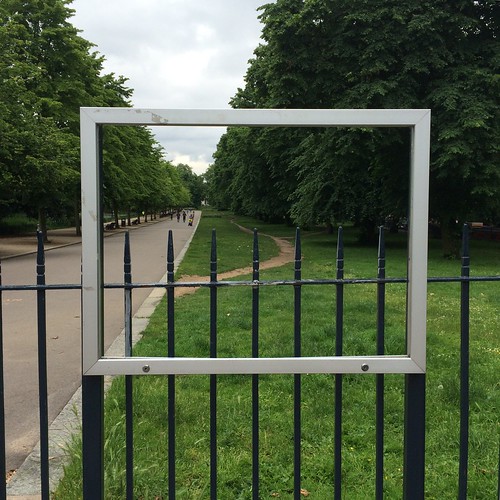
I saw a pattern! It was a message to me! It was a message to you. It made me feel…oh…I can’t say what…
This empty table here; those empty chairs there
The café/condiment photos––a series––eating––so basic––and we always remember that but we also think––‘we know this kind of café too’, ‘we go here on these occasions’––and we wonder what kind of a person this serial café goer is, is this an important routine in his life, does it define him amongst others, his friends, colleagues, what does he eat, are the condiments incidental or fundamental to his café visits, does he keep his distance from the condiments, use them with discretion, does he go to the café now only or mainly for his mission to image the condiments or do his meals and his art dovetail nicely, conveniently, pleasantly here. Do his companions laugh when he takes today’s photo? Or does he eat alone?

Cables, pipes, tangles––runes, ciphers, hieroglyphs.
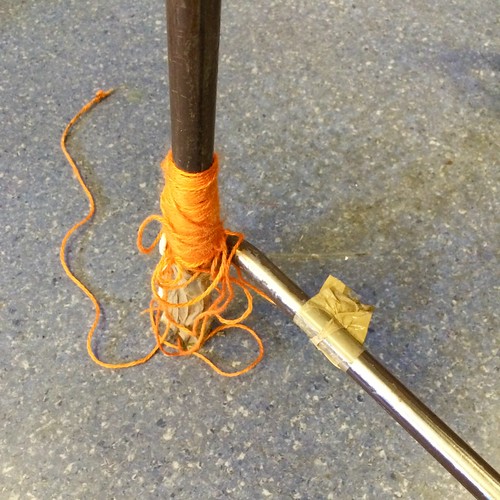
The morning was sunny. It rained. The afternoon was still warm but muggy. There was a rainbow. The sky was blue. The fence was a different blue.
Shadows, folds, stripes, other repetitive patterns. Some there, pre-intended, functional. Some found, loaned, in the process of making the photo.
Objects that are (or have been) useful or functional removed from or seen out of their usual context. (Sometimes by human agency––dumped, temporarily abandoned, or simply cropped)
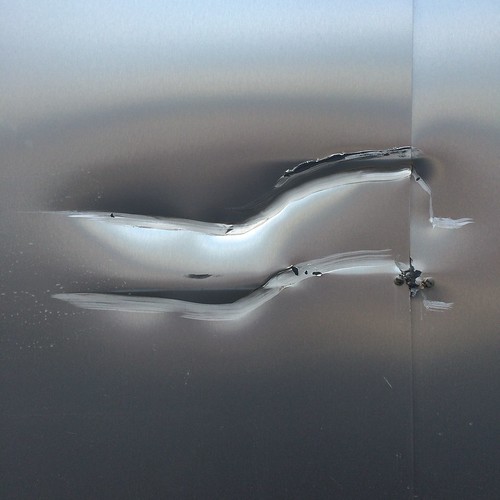
Estrangement––making us see the world anew // making us remember our world anew.
Found patterns, found juxtapositions.
A lively eye and a lively mind.
Joy in colour. Grace in handling, in apportioning that colour. It’s like he finds the best tidbits and, smiling, hands them to us.
It isn’t abstracting from the world // the function is often still evident so it’s like layer upon layer of meaning and affect and confusion // the original function or action…the strange pattern it makes… its removal from its usual context.
These images lend us Joseph C’s eyes. These images lend us another human’s mind and sensibility.
When you are a child and you’re walking along by the side of a grown-up and they have important things to do or say and so you are free to look around and feel and think and wonder and also you are half their height or less so you have both the utter freedom to look where you will and you lack preconceptions about what it is you see signifies or how it ought to make you feel and on top of that you see it from an angle that will never again be natural to you without a degree of contortion. And you are become magically a kind of still, observing, feeling centre of the world.
Joseph C gives us back some of that.
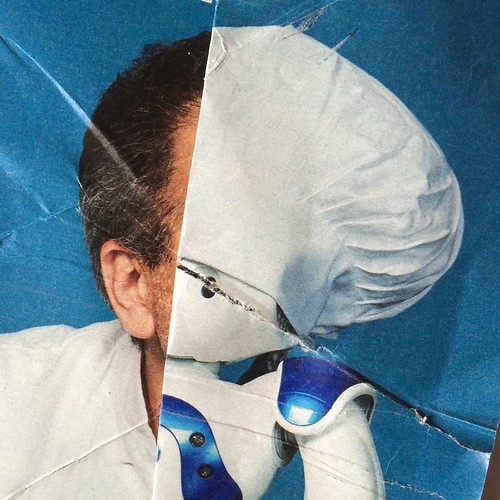
Featured Image: Ubermorgen, “Vote-Auction”, 2000. Installation view from the exhibition “Whistleblower & Vigilantes”
It has been a long time since an exhibition shocked and confused me. In fact, I cannot even remember when it last happened. Yet the exhibition Whistleblowers & Vigilanters has managed to do just that. Curators Inke Arns and Jens Kabisch of the Dortmund art institution Hartware Medienkunst Verein (HMKV) have put up a show in which complete nut cases are presented side by side with political activists, artists and whistleblowers a la Edward Snowden. This makes the exhibition ask for quite some flexibility from the audience. Visitors have to work hard in order to understand the connection made here between, for example, racist conspiracy theories expressed through YouTube videos and the ordeal of a whistleblower like Chelsea Manning.
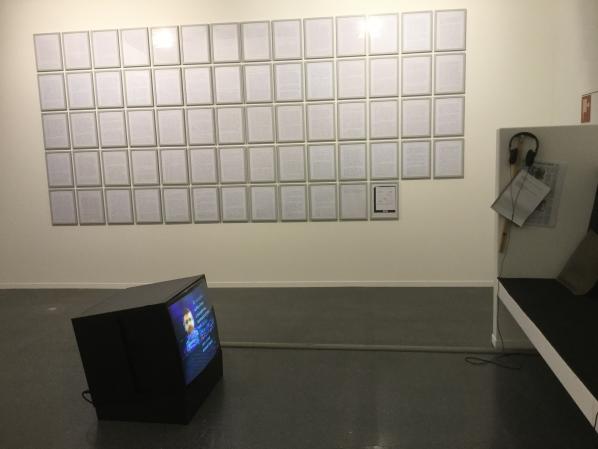
The very short introduction text to the exhibition guide is part of the puzzle we are presented with. The basic premises of the exhibition are explained in what I think is not the best possible manner, because it leaves out any mentioning or analysis of the huge political differences among the people and works presented. At the same time the use of words like higher law and self-legitimization easily creates a feeling of unease about each practitioner or type of activism in the show:
“The exhibition asks what links hacktivists, whistleblowers and (Internet) vigilantes. What is the legal understanding of these different actors? Do they share certain conceptions? Who speaks and acts for whom and in the capacity of which (higher) law? Among other issues the exhibition will examine the differing legal conceptions and strategies of self-legitimisation put forth by activists, whistleblowers, hackers, online activists and artists to justify their actions.”
By placing the revelations of Edward Snowden next to the complete print out of the manifesto of the Unabomber or (more harmless but still of a different level of impact) the battle over a hostile domain name takeover in Toywar the first impression is a levelling of the practices and people involved. To make some sort of distinction between the various represented rebellious or activist positions in the exhibition guide the whole is divided into sections. The sections however do not indicate socio-political position or relevance, but rather imply the ways people legitimize their actions (1).
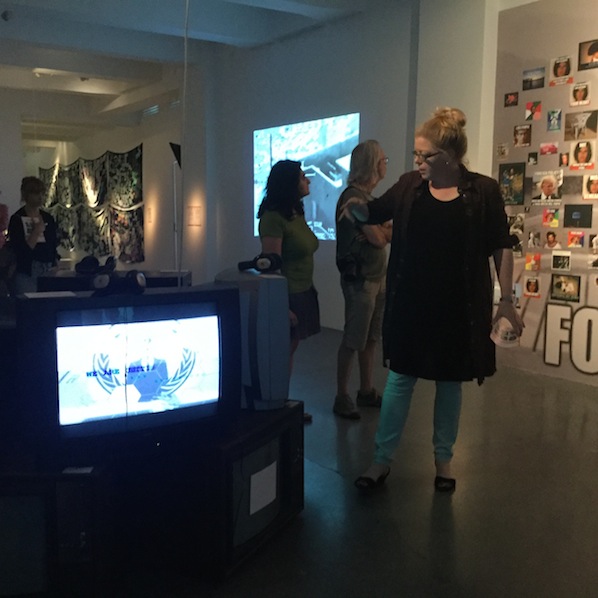
The spatial design and mapping of the exhibition seem to give some indication of political direction, but it is accidental. To the far right of the entry we find all installations labeled ‘Vigilantes’: a website collecting images of online fraudsters (419eater.com), two videos about Anders Breivik and Dominic Gagnon’s collection of mostly right-wing extremist YouTube videos. Slightly controversial is how the Vigilantes section puts together these quite obvious nut cases and criminals with Anonymous and what the curators call ‘Lulz’, the near troll-like jokesters who ridicule anything they don’t like with razor sharp memes. I am not sure whether these two products of the online forum 4chan deserve this simple pairing to YouTube hate preachers. A finer distinction between the various Internet underbelly representatives might have been better here. That this could have been done is shown by Lutz Dammbeck’s archive on the Unabomber’s placement in the Vigilante section, which has two labels. It is the sole representative of the Critique of Technology section as well. Another strange pairing happens in the Antinomism section, where an installation around a video with Julian Assange and a rightwing terrorist bomb disguised as soda machine are the only examples.
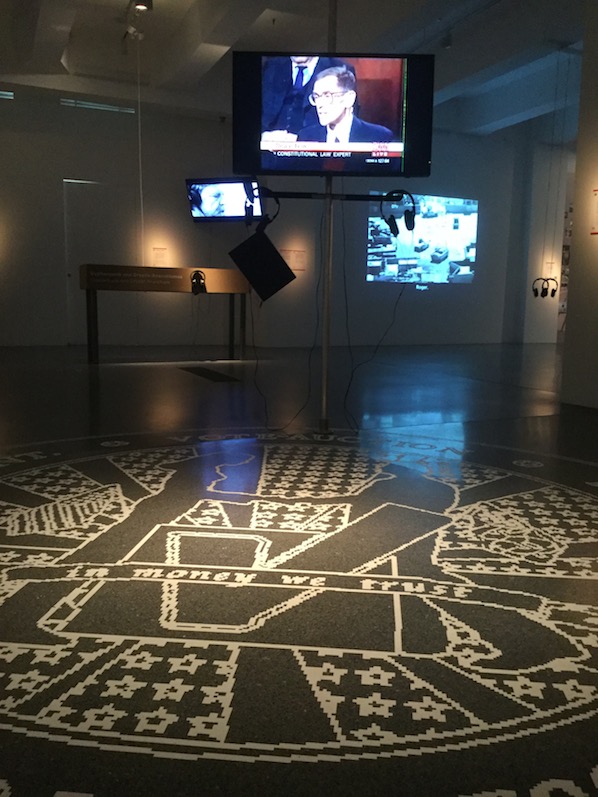
The middle ground of the exhibition shows a mix of artist activism and hacker culture. Mediengruppe Bitnik are here with a video of their Delivery for Mr. Assange. Black Transparency by Metahaven is represented through one utopian architecture model and printed wall cloths. The Peng! Collective’s Intelexit: Call-A-Spy has a telephone stand in the exhibition. The provocative sale of US votes in Vote-Auction by Ubermorgen is here as docu-installation. Etoy’s legendary Toywar is represented as well, with -in my opinion- too small a stand. Traces of many other art works and activist projects are presented in display cases, which give some more background or context to the theme. These were one of my favorite parts of the exhibition, next to the amazingly diligent and meticulous hand-drawn documentation of the Manning trial by Clark Stoeckley.
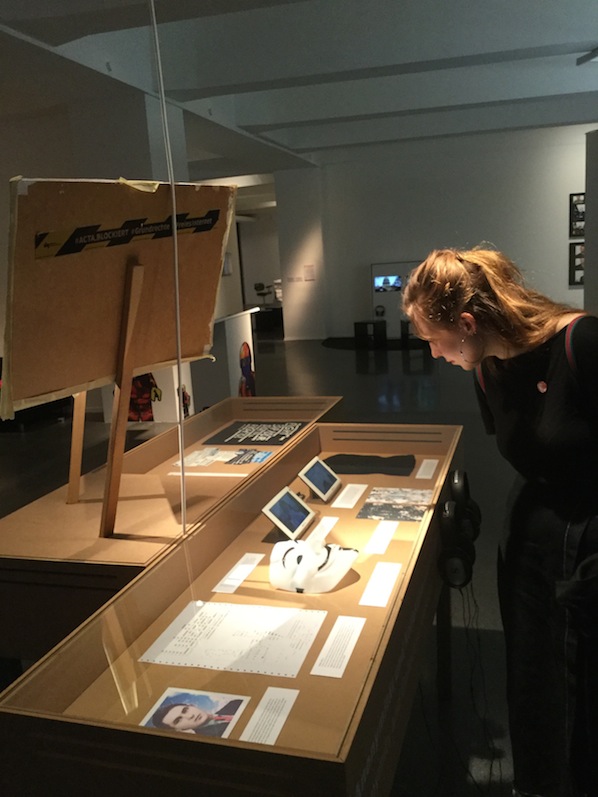
The display cases are dedicated to freedom of speech, tools of online resistance, the Netzpolitik case, anonymity and collective identities and cypherpunk and crypto-anarchism. They provide an important insight into the context within which the other practices in the exhibition exist.
Here we find Luther Blissett, the Italian born collective online identity, with a name borrowed from a former football player. The Blissett identity is related to pre-Internet art practices, in particular Neoism, and has been used for various art pranks and activist projects, particularly in Southern Europe.
Other art projects include the influential book Electronic Civil Disobedience by Critical Art Ensemble, the German hacker art collective Foebud’s battle for free speech and privacy (presented with one of Addie Wagenknecht’s anonymity glasses), and the Electronic Disturbance Theater’s Floodnet. The latter is a DDoS attack software that was used in actions for the Mexican freedom fighters the Zapatistas, by the Yes Men and for Etoy’s Toywar project.
There is also a print out of the Cypherpunk mailinglist. The cypherpunk crypto-anarchist community is responsible for some of the most influential elements of the free Internet. They produced the PGP encryption technology, cryptocurrency such as Bitcoin, TOR, the idea of WIKI and torrent platforms and marketplaces like the Silk Road. Julian Assange was one of its members.
Last but not least the presentation of the Netzpolitik.org case, which covers a German censorship scandal from last year, had to be part of this exhibition. Journalists from the online magazine Netzpolitik were arrested for treason after they had published about classified Internet surveillance plans of the German secret service. A copy of the accusation letter from the state prosecutor is oddly signed with ‘Mit freundlichen Grüßen’ (‘With kind regards’).
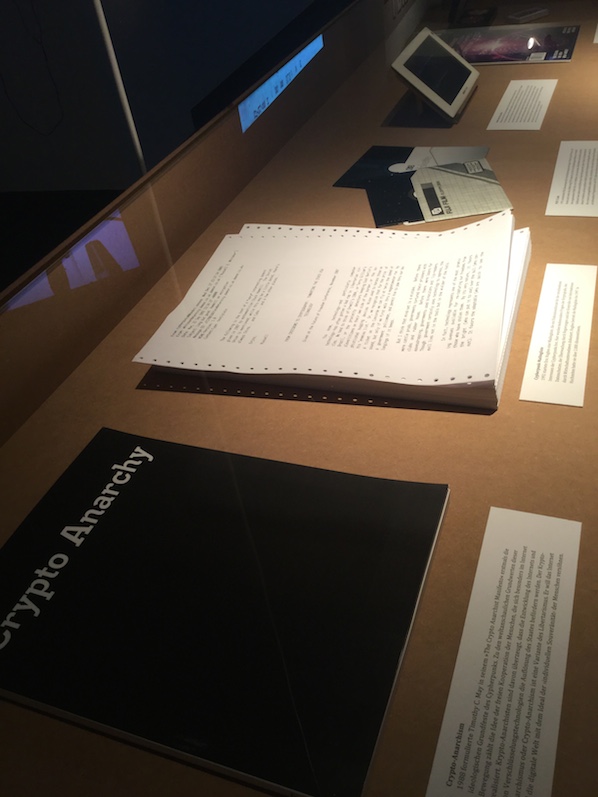
All in all the display cases made me happy to see some of the events and works that have been so hugely influential to the development of the Internet (and thus to the development of our current culture and politics) represented in a physical cultural space. They show a side of Internet culture that is heavily underrepresented in the general discourse around new media technologies in both mainstream media and art. During a private tour of Whistleblowers & Vigilantes for visitors of the simultaneously running Hito Steyerl exhibition Inke Arns explained how for her this exhibition is long overdue as well. According to Arns the threat to our freedom through abuse of new technologies should receive as much attention in art as the anthropocene. HMKV sees it as its responsibility to do something about it.

Whistleblowers & Vigilantes however does not make a straightforward statement. Its structure, both physically and content-wise, is too complex for that. This does not mean it is a bad exhibition. The bringing together of the ‘Lulz’, Anonymous, the Unabomber, net art, hacktivism, hackers and Manning, Snowden, Assange and even Breivik in one space definitely creates a lively exhibition, which cannot leave a visitor unaffected. This strange assembly then needs to be unraveled and this is where the curators take quite some risk. The addition of Hito Steyerl’s installation Factory of the Sun, an exhibition that runs simultaneously on a different floor, could help to bring the serious, crazy and light elements of the show together for that part of the audience that loses its way. In her smart playful manner Steyerl blends science fiction, humor and critique of the surveillance society in a faux holodeck cinema experience. The exhibition also includes a few live events that steer the whole into safe waters. Netzpolitik journalist Markus Beckedahl has given a presentation and so has Jens Kabisch. Kabisch wrote a text about whistleblowers that is available on the website, but this text is unfortunately only available in German. My advice to the non-German audience is to download the press kit in order to get more background information.
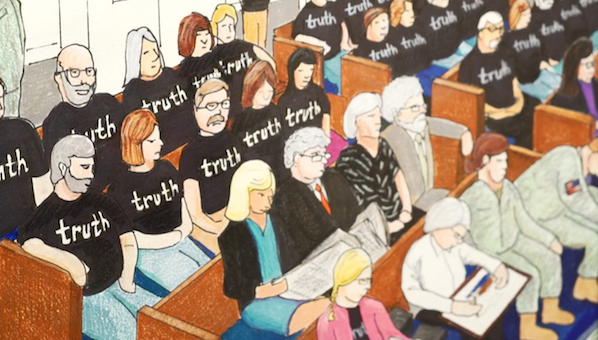
Whistleblowers & Vigilantes is a challenge to the audience. It asks for more reflection and time to take in than most exhibitions. After getting some more grip on it the complexity and scope of the exhibition, however, is impressive. It not only brings together many important, interesting and sometimes scary examples of contemporary forms of resistance and rebellion. What is also represented is the space of resistance and play that escapes attempts at systematic control, even in a full-on surveillance state. Once recovered from my initial shock this is what stayed with me the most. The wide-ranging documents, objects and installations reveal the system’s shadow spaces and vulnerabilities. Whistleblowers & Vigilanters differs from the flood of other art exhibitions themed around surveillance and control by reflecting on the legitimacy of online autonomous political action in general. Indirectly this means it also reflects upon the space of life that exists beyond all control. Rather than create another horror show around the future of privacy and freedom, with Whistleblower & Vigilanten we are presented with the persistence of fringe cultures and of free thinkers. For me this makes this an exhibition of hope.
Whistleblowers & Vigilantes. Figures of Digital Resistance
HMKV, Dortmund
9/4/16-14/8/16
https://www.hmkv.de/_en/programm/programmpunkte/2016/Ausstellungen/2016_VIGI_Vigilanten.php
https://www.hmkv.de/_pdf/Ausstellungsfuehrer/2016_VIGI_Kurzfuehrer_Web.pdf
Calling 13-18 year-olds!
Become a digital media artist. Design your own digital game, make a robot, or design a selfie app. Create small ‘geocached’ artwork for people to find in Finsbury Park, or narrate an audio guide for gallery visitors. Meet and learn with leading artists, and at the end of the programme you can keep your own ‘Raspberry Pi’ pocket computer
FREE, booking essential, limited places so BOOK HERE NOW
For more information contact: alicia.furtherfield@gmail.com
Young Digital Artists in Residence: Adventures in Art and Technology is part of Islington Council’s Summerversity programme.
There is a common sense in place about the fact that civil rights are undermined by a various amount of ‘exceptions’; exceptions which are based on a system, in which governmental decision-making processes are increasingly determined by the rule of money, or else the market. The idea of a constant ‘crisis’ leads to a ‘state of exception’. Regardless of established legal standards – in the name of financial, economical or security measurements – civil rights are constantly taken away. As a result, the social and legal relations between the different members of society and between nation states are increasingly out of balance. This creates an endless pool of watering down legal standards in postdemocratic societies and produces harmful sociopolitical asymmetries. The exhibition “As rights Go By” which took place in freiraum Q21 this spring 14th April – 12th of June 2016 aimed to exactly pinpoint these asymmetries and to unfold the irregularities of a ‘regular legal system’.
The 15 works in the exhibition, curated by Sabine Winkler, focused directly on the complex dynamics between the sources and consequences of disappearing civil rights under the global neoliberal umbrella. The show, which was very well set, had strong internal and external references and what really could struck somebody was the content. The exhibition could be experienced as a single piece, inviting the visitors to discover more more than just the visible tips of the il/legal iceberg and to bring these issues of discussion to schools, universities, festivals, shopping malls and the mainstream media. Of course this doesn’t mean not to exhibit – but it means not to stop there.
As Rights Go By was an exhibition which stays in mind ; the visitors could produce their own individual collages, making sense of the gravity of the problematics involved.
The works presented were the following:
Silvia Becks, who worked with the privileges in the art world, presented an installation which discussed how the special rights in place, like the information accessibilities, the funding resources and the leveling up of the societal status, are at the same time leading to a certain loss of legal rights.

James Bridle, with his video animation “Seamless Transitions”, tried to visualize the physical spaces of the unknown arrest, the legal decision making processes and the juridical judgments involved, offering a virtual insight into the secret spaces of il/legality. His work questioned not only the surveillance strategies of physical space but also the secrecy about trading agreements and legal treaties.

George Drivas’ film‚ “Sequence Error” referred to a typical business setting where a sudden crisis has lead to a collapse. A fictional situation with a more than real deal: The crisis serves as the exception for legal rights to be erased.
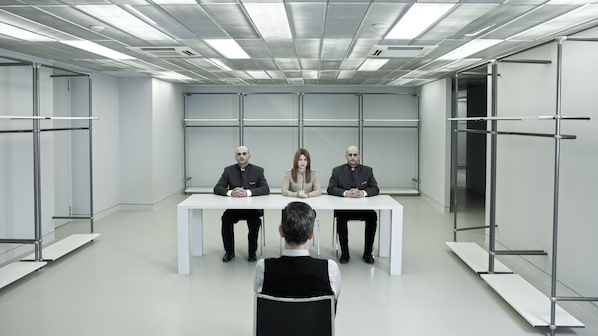
Özlem Günyol and Mustafa Kunt, overlaid the portraits of the hundred wealthiest people of the world fading into one collage of one single passport image projected to the wall. A symbol for lost identities and unidentifiable legal entities.
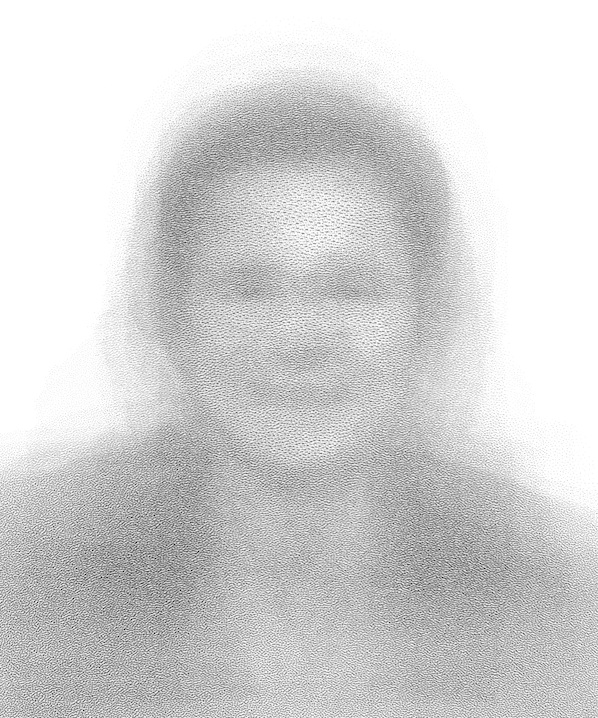
Adelita Husni-Bey video documentation gave a very detailed insight into an urban planning process in Cairo (“Land”) including gentrification processes, which go not only against Egyptian law but actually threaten a huge amount of informal dwellings. The notion ‘participations’, in particular, delivered a learning lesson about contemporary urban development strategies and their methods.
Nikita Kadan used a “Popular Medical Dictionary” of the Soviet era in his work “Procedure Room”. Painting torture methods on ceramic plates, he showed how physical and psychological violence can be justified for a ‘higher’ political order.
The Collective Migrafona reported via Comic strips about the Austrian migration politics. Imaginary Heroes are delivering identities in order fight for political rights.
Vladimir Miladinovic’s research focused on multinational companies and their strong connections to pre- and post-war power structures. His work discussed the power relations, which are in place during setting up regulations between states and their legal standards.
In his film “1014” Yuri Pattison mixed fictional Hollywood scenes with documentary footage from the hotel room where Edward Snowden gave his first interview. The work offered an insight into the conscious loss of legal rights when fiction becomes reality and vice versa.
Lorenzo Pezzani and Charles Heller raised the question about acting against human rights while being aware of the refugee tragedies based on surveillance technology. Their forensic reconstruction of a boat disaster offered a clear insight into the thin borderline between socio political responsibilities and legal settings.
Julien Prévieux work “What Shall We Do Next? 2006-2011“ showed how close technology, law and our bodies are connected; the fact that international corporations obtain patents for specific movements such as scrolling moves on a tablet shows how unaware we are about our daily il/legal routines.
Andrea Ressi related the notion of loss onto her work; loss of living space, loss of rights, loss of freedom, loss of security and represented these losses in her pictograms with modules of exception.
Judith Siegmund’s text based installations produced discomfort. Newspaper quotations about violence against refugees were set up opposite to philosophical text fragments, triggering associations about the relation between violence and competitiveness assuming that people take advantages from others who find themselves in a lawlessness situation.
Lina Theodorou’s project was one of the most intriguing works in the show. Her board game club offered a playful insight into the crisis in Greece and the social and legal consequences of austerity measurements up leading to losing well established rights. The setting would be funny if it wouldn’t be real.

Carey Youngs’ work “Obsidian Contract” transformed the visitor into an affiliate. The public space and the legal space were imagined and lost rights were reconstructed fictionally while watching the contract text through a mirror.
The exhibition did not refer directly to any political action, artivism, hacktivism or any other form of resistance but it implied the embedded hegemonic power structures pointing where it all begins.The exhibition was not a subversive act but it showed how subversion as an act of societal struggle became something illegal. Up to around 15 years ago the notion of ‘subversion’ was relatively easy to connect to counter-cultural productions. But a subversive act wasn’t nesessarily illegal – it was done in a grey shadow light between established settings in order to shake up presumably fixed sociopolitical surroundings. An unclear task under clear conditions.
In the era of global capitalist hegemony, shadows turned straight into black or white areas; no grey is involved anymore. Subversion dissolved into two parts: the legal one, which consists of what is now understood as innovation – or ‘creativity’ as the motor for an ‘idea based economy’- and the illegal one, what now labels all the ‘unwanted’ realities: terror, refugees, homeless; etc. Therefore subversive thinking and acting is no longer part of a cultural discourse but is simply illegal. Why?
The unlimited governmental practices which are today in place show that decisions are made as it happens in the financial markets; everything becomes a derivate, something to speculate with. The future has consequences on the present before anything happens. In times where potentials are seen as threats, the subversive process is turned upside down: subversions themselves become clearly defined and legal settings are turned into grey areas. A clear task under unclear conditions.
The exhibition encouraged, motivated and gave an insight into the power of rights including the absence of it. Focusing on how rights are either set or (il/legally) undermined by their exceptions and on how well these tendencies are sold as (inter)national necessities, it underlined the urge for a collective awareness of these i/legal practices and their consequences.
‘As Rights Go By’ was a very important exhibition; as mentioned above – what was visible was just the tip of the iceberg. As in many shows which include a huge amount of artistic research, a retrospective view in the future will show that this is just the beginning of a different kind of political engagement which most of all is a call for action.
Rights go by and are not falling from the sky.
Featured Image: With 69.numbers.suck by Browserbased
Athens Digital Arts Festival (ADAF) returned this year on the 19th to the 22nd of May with its 12th edition to bring Digital Pop under the microscope. Do machines like each other? Does the Queen dream of LSD infused dreams and can a meme be withdrawn from the collective memory?
Katerina Gkoutziouli, an independent curator and this year’s program director together with a team of curators proposed a radical rethinking of digital POP, placing the main focus on the actors of cultural production. From artists to users and then to machines themselves, trends and attitudes shift at high speed and the landscape of pop culture is constantly changing. What we consider POP in 2015 might be outdated in 2016, as the Festival’s program outlines, and that is true. But even so, in the land of memes, GIFs, likes, shares and followers what are the parameters that remain? ADAF’s curatorial line took it a step further and addressed not just the ephemerality of digital POP. It tackled issues related to governance and digital colonialism, but in a subtle and definitively more neon way.
450 artists presented their work in a Festival that included interactive and audiovisual installations, video art, web art, creative workshops and artist talks. Far from engaging in the narrative of crisis as a popular trend itself though, ADAF 2016 was drawn to highlighting the practices that reflect the current cultural condition. And the curated works were dead-on at showcasing those.

How are we “feeding” today’s digital markets then? Ben Grosser’s sound and video installation work “You like my like of your like of my status” screened a progressive generative text pattern of increasingly “liking” each others “likes”. Using the historic “like” activity on his own Facebook account, he created an immersive syntax that could as well be the mantra of Athens Digital Arts Festival 2016.
Days before the opening of the exhibition, Ben Grosser was asked by to choose the image that defines pop the most. No wonder, he replied with the Facebook “like” button. What Ben Grosser portrayed in his work is the poetics of the economy of corporate data collectors such as Facebook with its algorithmic representation of the “Like” button as the king pawn of its toolkit, that transform human intellect as manifested through the declaration of our personal taste and network into networking value.

Speaking of taste, what about the aesthetics? From Instagram and Snapchat filters to ever updated galleries of emoticons available upon request, digital aesthetics are infused with social significance. In the Queen of The Dream by Przemysław Sanecki (PL) the British politics and the Royal tradition were aestheticized by the DeepDream algorithm of Google. In an attempt to relate old political regimes and established technocracies, the artist places together hand in hand the political power with the algorithmical one, pointing out that technologies are essential for ruling classes in their struggle to maintain the current power balance. The representation of the latter was placed there as a reminder that it’s dynamic is to obscure this relation, rather than illuminate it.
However, could there be some space for some creative civil disobedience? Browserbased took us for a stroll in the streets of Athens, or better to say in the public phone booths of Athens. There, the city scribbles every day its own saying, phone numbers for a quick wank, political slogans, graffiti, tags and rhymes. With 69.numbers.suck Browserbased mapped the re-appearance and cross-references of those writings, read this chaotic network of self-manifestation and reproduced it digitally in the form of nodes. Out there in the open a private network emerged, nonsensical or codified, drawn and re-drawn by everyday use, acceptance and decline.
Can virality kill a meme? Yes, there is a chance that the grumpy cat would get grumpier once realized that its image would be broadcasted, connoted and most possibly appropriated by thousands. But how far would it go? The Story of Technoviking by Matthias Fritsch (DE) was showcased at the special screenings session of the Festival. It is a documentary that follows an early successful Internet meme over 15 years from an experimental art video to a viral phenomenon that ends up in court. Once the original footage was uploaded, it remained somehow unnoticed until some years later that it was sourced, shared, mimified, render into art installation, even merchandised by users. As a cultural phenomenon with high visibility it fails to be deleted both from servers around the world and from the collective memory even though that this was a court’s decision. In his work Matthias Fritsch mashes up opinions of artists, lawyers, academics, fans and online reactions marking the conflict between the right of the protection of our personality to the fundamental right of free speech and the direction towards which society and culture will follow in the future in regard to the intellectual property.

It’s the machines alright! Back in the days of Phillip K. Dick’s novels the debate was set over distinctions between human and machine. Since then the plot has thickened and in memememe by Radamés Ajna (BR) and Thiago Hersan (BR) things were taken a step further. This installation, situated in one of the first rooms of the exhibition, of two smartphones seemingly engaged in a conversation between them through and incomprehensible language built on camera shots and screen swipes is based on the suspicion that phones are having more fun communicating than we are. Every message is a tickle, every swipe a little rub. In memememe the fetichized device was not just a mechanic prosthesis on the human body, it was an agent of cultural production. The implication that the human might not cause or end of every process run by machines was promoted to a declaration. Ajna and Hersan have built an app that allows as a glimpse into the semiotics of the machine, a language that we can see but we can’t understand.
How many GIFs fit in one hand? If one were to trace all subcultures related to pop culture, then he or she would have to stretch time. Since they are multiplying, expiring and subcategorized not by theorists but by the users themselves and with their ephemerality condemning most of which into a short lived glory. Lorna Mills (CA) explores the different streams in subcultures through animated GIFs and focuses on found material of users who perform online in front of video cameras. In her installation work Colour Fields she is obsessed on GIF culture, its brevity, compression, technical constraints and its continued existence on the Internet.
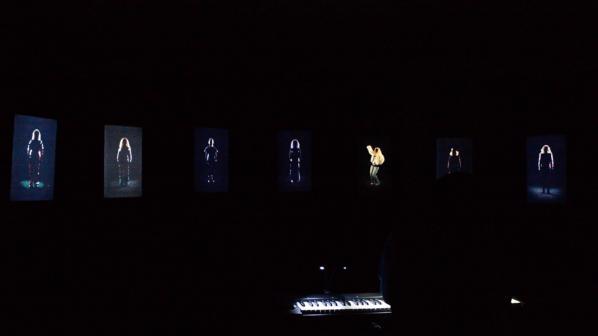
Global pop stars, a blueprint on audience development. Manja Ebert (DE) in her interactive video installation ALL EYES ON US, one of the biggest installations of the Festival, embarked on an artistic analysis of the global pop star and media phenomenon Britney Spears. Based on music videos of the entertainer that typecast Spears into different archetypical female characters, Ebert represented each and every figure by a faceless performer. All nine figures were played by a keyboard, thus allowing the users to recompose these empty cells decomposing Spears as a product into its communicational elements.
Going through the festival, more related narratives emerged. Privacy and control, the representation of the self and the body were equally addressed. People stopped in front of the Emotional Mirror by random quark (UK/GR), to let the face recognition algorithm analyze their facial expression and display their emotion in the form of tweets while they were photographing and uploading in one or more platforms the result at the same time.
Τhe Festival presented its program of audiovisual performances at six d.o.g.s. starting on May 19 with the exclusive event focus raster-noton, featuring KYOKA and Grischa Lichtenberger.
ADAF 2016 brought a lot to the table. Its biggest contribution though lies in offering a great deal of stimuli regarding the digital critical agenda to the local digital community. ADAF managed to surpass the falsely drawn conception of identifying the POP digital culture just as a fashionable mainstream. On the contrary it highlights it as a strong counterpoint.
Featured Image: Julian Rosefeldt Manifesto, 2014/2015 ©VG Bild-Kunst, Bonn 2016
Entering the darkened gallery space in the side wing of Berlin`s Hamburger Bahnhof – Museum für Gegenwart, the visitor first encounters a projection showing the close-up of a fuse cord burning in the dark. Shot out of focus its sparks are flying in slow motion, a firm clear female voice comes in beginning a monologue which includes familiar lines and passages: “I am against action; for continuous contradiction, for affirmation too, I am neither for nor against and I do not explain because I hate common sense. […] All that is solid melts into air. […] I am writing a manifesto because I have nothing to say.”. The fuse cord gradually exstinguishes without leading to an explosion.
Quoting parts of the manifesto of the Communist Party, Tristan Tzara`s Dada Manifesto as well as pieces of Philippe Soupault`s “Literature and the Rest”, the 4-minute video in its function as “Prologue” sets the tone of Julian Rosefeldt`s exhibition “Manifesto”. The opulent 13-channel installation is a homage to the textual form of the artist manifesto – in Rosefeldt´s words “a manifesto of manifestos”. Inspired by the research for his previous work “Deep Gold”, Rosefeldt began looking further into the genre and its poetics. From about sixty popular art manifestos – the earliest from 1848, the latest from 2004 – he collaged twelve new powerful and entertaining manifestos. Said manifestos serve as the source for each of the thirteen videos (a prologue and 12 scenarios) delivered and performed as monologues by Oscar-winning actress Cate Blanchett.
In every film, an extremely versatile Blanchett morphs into another role: From homeless man to broker, newsreader to punk, puppeteer or scientist. Obviously these roles do not represent the manifesto`s authors, they rather show contemporary types chosen by the artist to counterpoint or stress the ideas and attitudes of the text passages they are reciting. As a CEO at a private party, Blanchett is orating in front of an affluent audience, praising “the great art vortex”. Continuing her celebratory speech, she changes the tone to amuse her crowd quoting more passages of the Vorticist manifesto: “The past and future are the prostitutes nature has provided.”. Polite laughter, glasses are clinging. Another scene shows a bourgeois American family sitting at the dining table about to say grace. Blanchett in the role of the conservative mother is leaning her head, folding her hands but instead of the usual blessing, she begins to fervently recite Claes Oldenburg`s Pop Art Manifesto which consists of a series of propositions starting with “I am for an art …” and includes such gems as: “I am for an art that is political-erotical-mystical, that does something other than sit on its ass in a museum.” or “I am for the white art of refrigerators and their muscular openings and closings.”.

All 10-minutes-long videos in the exhibition work according to the same principle: the art manifesto collages are delivered as monologues by Blanchett at first in voice-over introducing the scene, then in filmed action and at its climax as speech to camera. Shown in parallel and installed without spatial division, the monologues interfere with one another, and the visitor is always confronted with more than one narration. While watching Blanchett in the role of a primary school teacher softly correcting her pupils quoting Jim Jarmusch: “Nothing is original. Steal from anywhere that resonates with inspiration or fuels your imagination.”, one can at the same time hear her in the role of an eccentric choreographer slamming the rehearsal of a dance ensemble with the words of Yvonne Rainer, “No to style. No to camp. No to seduction of spectator by the wiles of the performer.” From somewhere else the sound of a brass band appears, introducing the funeral scene in which Blanchett is holding a eulogy consisting of a collage of several Dada manifestos. Sounds and voices overlap and compete for attention until a point in each video when all characters in sync turn towards the camera falling into a chorus-like liturgical chant, filling the dark gallery space with a polyphony – or cacophony – of interfering monologues. It is an impressive experience, but simultaneously the installing method makes it very hard to concentrate on words and ideas expressed in the manifestos.
In general, the exhibition and each of the videos are aesthetically pleasing and entertaining to watch, which is equally due to the scenography with its amusing artifices, the strong selection of text passages as well as its its star power. Rosefeldt´s opulent, multi-layered and choreographed installation blurs the lines between narrative film and visual art. Commissioned by a unique group of partners that include the Australian Centre for the Moving Image, the Art Gallery of New South Wales, Hamburger Bahnhof and Hanover `s Sprengel Museum, “Manifesto” is in no way inferior to most cinematic productions made in Hollywood. But here´s the problem: Although Rosefeldt claims in his intro text and again in the video interview accompanying the exhibition online, that he wanted to emphasize and celebrate the literary beauty and poetry of artist manifestos, the texts are outshined by the cinematic staging of actress, setting and choreography of space. The attention of the viewer is drawn to speaker and theatrical performance, instead of focusing on the poetics and messages contained in each one of the thirteen art manifesto texts.
Another stylistic element that Rosefeldt uses attempting to highlight the manifesto texts is creating tension between text and image. Most of the settings and characters in “Manifesto” deliberately break with the performed text, which can for example be witnessed in the scene of the conservative mother reciting Oldenburg. Both were conceived by Rosefeldt to intensify the contrast between the rebellious rhetoric, idealism and radical notions of the manifesto form and the realities of today´s world. This does not work out at all times, sometimes the performances seem so exaggerated that they tip over and border on the ridiculous, the staging turns into travesty. It reinforces the impression that the exhibition is not in the first place about the texts, their content and reflective presentation, but rather aimed at the maximum achievable effect. But Rosefeldt succeeds in his intention to show how surprisingly current the demands of some of the manifestos presented are, most of them written in the 20th century. A century which was defined by historian Eric Hobsbawm as the short century and “The Age of Extremes” which saw the disastrous failures of state communism, capitalism, and nationalism. The world has more or less continued to be one of violent politics and violent political changes, and as Hobsbawm writes most certainly will continue like that.
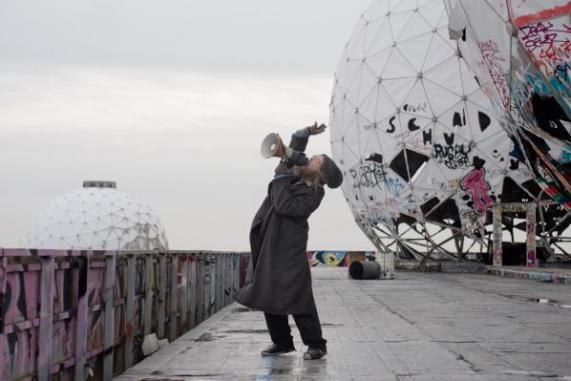
So it is no wonder that the manifesto, also serving as a signal of crisis, is experiencing a revival. With the internet as an easy means of dissemination, the manifesto form has been revisited by a great number of single artists and artist activist groups, it spread out in every niches of the art world, and was adapted by academia and beyond. So when Rosefeldt in his statements nostalgically praises texts from the “Age of Manifestos” and states that he misses this thoughts focus in today´s discourses, one cannot but wonder if he missed the current debates sparked by texts like the “#ACCELERATE MANIFESTO for an Accelerationist Politics”, “The Coming Insurrection” by the anonymous Invisible Committee, “Xenofeminism: A Politics for Alienation” authored by Laboria Cuboniks collective or texts by individual artists like Hito Steyerl which became important points of reference.
Rosefeldt´s selection of manifesto texts seems random and inconsistent with his expressed intentions: Why was the manifesto of the Communist party included in an assortment of art manifestos? Or why were Jim Jarmusch`s “Golden Rules of Filmmaking” from 2002 and Sturtevant`s ”Man is Double Man is Copy Man is Clone” from 2004 chosen in a selection concentrating on 20st century texts? Instead of concentrating on canonic art movements and a few single artists, it would been more convincing to reflect how the art field since then has been trying to re-position itself within the shifting boundaries of activism, technology and aesthetics. With a subjective selection of simply “the most fascinating, and also the most recitable” texts, “Manifesto” is caught up in an acritical nostalgia to the disadvantage of coherence and focuses rather on text as performance as on persuasive messages and reflection.
As Mary Ann Caws in her anthology “Manifesto: A Century of Isms” states, the manifesto is “a document of an ideology, crafted to convince and convert”. Naturally, there also is some discomfort with or even suspicion of the manifesto form. The obvious example being the Futurists, who in their manifesto glorified speed, machinery and war. Their text largely influenced the ideology of fascism which they supported in the run up to World War II. In the exhibition, the macho-male tone of the Futurist manifestos fittingly and amusingly is performed by Cate Blanchett in the role of a female stockbroker. Rosenfeldt met Marinetti`s dream of an engineered society showing us the violent creator and destroyer financial capitalism.
Julian Rosefeldt. Manifesto
Curated by Anna-Catharina Gebbers & Udo Kittelmann
10.02.2016 to 10.07.2016
Hamburger Bahnhof – Museum für Gegenwart – Berlin
http://www.smb.museum/en/museums-institutions/hamburger-bahnhof/exhibitions/detail/julian-rosefeldt-manifesto.html
The Critical Atlas of the Internet, Louise Drulhe’s latest project, is a virtual and physical exploration of the Internet space. The implications of our physical actions in ‘real-time’ are not only timeless in ‘cyberspace’, but also constitute the making of an obscure Internet architecture every time we browse the web. The Atlas itself is an enveloping notebook of Drulhe’s discerning methodology in desiring to represent the geography and architecture of the ‘unseen’ Internet territory. Initially, a graphic designer, Drulhe’s practice has meticulously evolved into including cyber-spatial analysis. She yearns to understand the sociological, political and economical issues that appear online or are exasperated by an online presence – ‘a territory we spend time in without knowing its shape’. The Critical Atlas of the Internet, by being parted between fifteen different hypotheses, sheds light on matters such as the monopolisation of non-physical spaces, the possibility of encumbered networks and the potential forms of the Internet.
I had the pleasure of interviewing Drulhe, where she clarified certain distinctive matters that arise from reading or looking at the virtual form of the Atlas online.
CS: In 2014, Google measured 200TB of data that they claim to be just an estimated 0.004% of the total vastness of the Internet. Initially, the Atlas perceives the Internet through many geometric shapes such as cones and spheres. Is this your approach to establishing that the Internet is an infinite space of shared connections and motion? If this is the case, do you believe it is immeasurable?
LD: I will probably get back to you with a better answer to this question in a few months… I am starting an art residency in Paris at La Paillasse, and I will study the question: “can we measure Internet?”. I am curious to see the best way to represent the Internet: to count the data or to measure the borders. I haven’t started this research yet, but I will look for the best unit of measure to calculate the dimensions of Internet territory: meters? Litres? Percentages? Data traffic? I wonder how to define the “size” of a website. If we look at Google.com, it’s only one webpage, so does this mean that Google is smaller than a regular shopping website that might have thousands of pages?
With the fourth hypothesis of the Atlas, “The Geographic Relief of the Internet”, I tried to represent the «size» of Internet platforms. Their size is actually based on the concentration of the activities they host. The Internet giants try to saturate and incorporate as much territory as possible. Google (now called Alphabet) possesses Chrome, Gmail, Android, Google +, YouTube, Blogger, Google Map / Earth / Street View, Cloud, Nest, and Google X… to cite a few. Internet giants are almost raging an online war to monopolize most Internet territory. I think the next virgin land to conquer is the Internet of Things. The map of this 4th hypothesis is based on a ranking by Alexa’s Top 500 Global Sites. What I would like to do next is to measure this representation.
CS: Extrapolating from your claim that the Internet is a single point at the centre of the globe, what would the repercussions if that space were to be encumbered? Can a network not be encumbered?
LD: It’s true. A reticular space cannot be encumbered, I guess. Facebook.com, for instance, is getting more and more popular, but the site works perfectly; you don’t feel crowded situations on Facebook. If Facebook were a physical public square and 1 billion people met there one day, the situation would be really problematic. On Facebook, you never see the crowd.
In the Atlas, I quote Boris Beaude on this idea “The growth of reticular networks, unlike that of cities, increases their interaction potential without boosting their internal distances. Regardless of the network size, the distance between its respective parts is potentially non-existent. Facebook can host 800 million people without affecting its interaction capacity.”[1] This is what he calls “reticular coalescence”.
[1] Boris Beaude, Internet : “Changer l’espace, changer la société“. 2012.
CS: You build your thesis on the hypothesis that Internet space does not require distance; each component is of equal distance to the other. Otherwise, one click away. Whilst this grants no special status to any person’s ‘search’ to being more important or unimportant, aren’t these ‘search results’ always altered depending on the search engine? For example, untracked browsers such as Tor or extensions on Chrome such as ‘Hola’ have the capability to displace a user from their current location and thus materialise a different order by which results appear to us.
LD: I wrote that the search engines “control Internet architecture” and “distribute the space”. Because almost everyone uses Google, we can assume that Google is the one that controls Internet space so if you use another search engine, like “DuckDuckGo”, you will access the web through a different architecture. But “Tor” and “Hola” are not search engines. “Tor” is a network that enables anonymous communication, and “Hola” is a VPN.
By using a VPN, you can bypass censorship. By changing your localisation, the VPN will give you access to another web. There are as many Internets as there are legislations. This idea is represented in the hypothesis, “A Global Object Projected at the Local Level”. The Internet is global, but we use a national projection of the global network. If you are in China, with a VPN, you can browse the Romanian web and access websites censored by the Chinese government. VPNs also enable anonymity, but that’s another aspect of it.

CS: Another one of your hypotheses places us (the users) at the Internet’s centre, constructing the space around us as we move through it. Indeed, the Internet meets our individual needs. Would you, therefore, account for it more as a product – the world’s only flawless consumer good?
LD: Here, I would like to draw your attention to another aspect of my research. If we look at the Internet as a consumer good, it’s probably the first that actually turned consumers into products! In rephrasing one of Mike Edgan’s statements, Jason Fitzpatrick says, “If you are not paying for it, you’re not the customer; you’re the product being sold”. The personal data that are generated through users’ browsing are the new “petrol” of the oncoming economy. And in this particular economy, we won’t be the consumer anymore!
CS: In early forms of the Internet, ‘cyberspaces’ were decentralised. Now, as the Atlas conveys, data is concentrated within the hands of a few ‘heavy players’, illustrated as ‘network nodes’ of various weights burying themselves within the Internet’s surface. Since most of the ‘network nodes’ come from the west, would you consider the Internet to possess a particular Westphalian sovereignty?
LD: The centre of gravity of the Internet is clearly the west, but not, in my opinion, the west as a whole. The US has a dominant position for multiple reasons that I detailed in the Atlas. The Internet’s centre of gravity is defined as “the weight, concentrated solely at one focal point, instead of being distributed over several different points”, a focal point which is undeniably Silicon Valley.
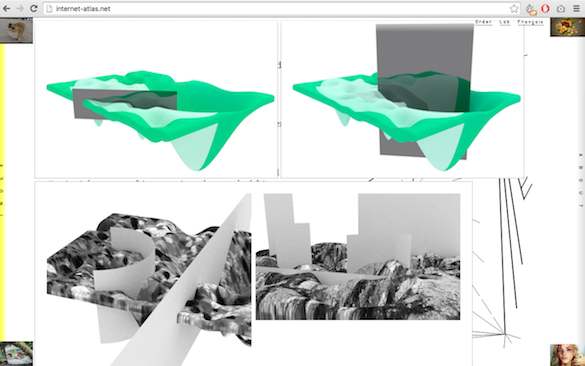
CS: I’d like to ask you about the visual representation of your online Atlas. In particular, about the rigid protrusions of space, you used to convey the ‘splinternet’ and the humorous intrusions of Hilary Clinton and Bernie Sanders, among other seemingly unplanned objects such as fried eggs. Could you comment?
LD: We often imagine the Internet as a single Cloud and a unified territory, but this is wrong. Some multiple limits or frontiers exist online. Some of them are really clear, like the Great Firewall of China: the wall of censorship that divides the Chinese Internet from the rest of the Internet. Another obvious frontier is the limit between the deep web and the surface web. But the frontiers that interested me most were the ones that nobody seemed to pay attention to. The limits are defined by private networks, such as Facebook. People with a Facebook profile never see the frontier because there are always logged in. But when you do not have the password, Facebook is closed, even if some pages are left open to attract you. Their goal is to make you join the private network.
CS: And the unsystematic quirks?
LD: Each time the website loads, the images are automatically taken from the emblematic forum “Reddit”, defined as « the front page of the Internet ». Those images work as timestamps in the Atlas; you can find them at the 4 corners of the website and on the books. The Internet is a perpetually changing space, constantly evolving. It was important for me to bring a timestamp to my Atlas. In addition, these images are symbols of the Internet culture; the Internet meme: viral images spreading through the web and overflowing onto my Atlas.
CS: I’d like to address your citing of Introduction: Rhizome by Guattari and Deleuze. They claim that a rhizome can be connected to anything other and must be’ and therefore does not follow the same arborescent structure of a book or tree. However, as mentioned before, there are arborescent nodes within the Internet itself – the ‘heavy players’. Do you believe this may distract multiplicity or enhance the creation of territories within the Internet? Would you also support that in the case of a rupture, where a rhizome breaks or one of the arborescent nodes fall apart, another node responds to replace as if it was always as such?
LD: Yes, that’s a good comparison. I believe that the heavy players saturate and erode Internet space. This idea is supported by the fact that each company creates a personalized arborescence that is really difficult to connect to by developing its own patterns or ecosystems, like the arborescence of a tree. In this idea, they are breaking with the original shape of the network and its interoperability.
About the rupture, actually, I am not sure. If a node disappears on the network, another node will not necessarily be replaced. If a web page goes offline and at the same time a Facebook page has just been created, the new node (from Facebook) does not take its place. The new node is actually created within the Facebook network. And to refer to my hypothesis about the geographic relief of the Internet, the node opens on the slope of a dominant gap.

CS: As a final point, there’s a particular passage from Baudrillard’s Simulacra and Simulation which I find can be quite relative when considering the structure of the Internet:
“Abstraction today is no longer that of the map, the double, the mirror or the concept. Simulation is no longer that of a territory, a referential being or a substance. It is the generation by models of a real without origin or reality: a hyperreal. The territory no longer precedes the map nor survives it. Henceforth, it is the map that precedes the territory – the precession of simulacra – it is the map that engenders the territory. If we were to revive the fable today, it would be the territory whose shreds are slowly rotting across the map.”
How would you interpret this if we took into consideration Internet territories?
LD: Most people do not consider the Internet as a territory. This idea of cyberspace is a bit old-fashioned. But, I think it is still pertinent today to study the Internet as a real space.
The way we access representations of the Earth today is really magical. Google provides easy access to an extremely precise representation of the Earth through satellite images and maps… But for the territory of the Internet, it’s the opposite. Even if there are a few maps of the Internet, there are no basic tools to map the web. The territory still precedes the map. I would love to see what a Google street view of the Internet looks like!
Featured Image: Gerald Raunig, Dividuum, Semiotext (e)/ MIT Press
Gerald Raunig’s book on the concept and the genealogy of “dividuum” is a learned tour de force about what is supposed to be replacing the individual, if the latter is going to “break down” – as Raunig suggests. The dividuum is presented as a concept with roots in Epicurean and Platonic philosophy that has been most controversially disputed in medieval philosophy and achieves new relevance in our days, i.e. the era of machinic capitalism.
The word dividuum appears for the first time in a comedy by Plautus from the year 211 BC . “Dividuom facere” is Ancient Latin for making something divisible that has not been able to be divided before. This is at the core of dividuality that is presented here as a counter-concept to individuality.
Raunig introduces the notion of dividuality by presenting a section of the comedy “Rudens” by Plautus. The free citizen Daemones is faced with a problem: His slave Gripus pulls a treasure from the sea that belongs to the slave-holder Labrax and demands his share. Technically the treasure belongs to the slave-holder, and not to the slave. Yet, in terms of pragmatic reasoning there would have been no treasure if the slave hadn’t pulled it from the sea and declared it as found to his master. Daemones comes up with a solution that he calls “dividuom facere”. He assigns half of the money to Labrax, who is technically the owner, if he sets free Ampelisca, a female slave whom Gripus loves. The other half of the treasure is assigned to Gripus for buying himself out of slavery. This will allow Gripus to marry Ampelisca and it will also benefit the patriarch’s wealth. Raunig points out that Daemones transfers formerly indivisible rights and statuses – that of the finder and that of the owner – into a multiple assignment of findership and ownership.
We will later in the book see how Raunig sees this magic trick being reproduced in contemporary society, when we turn or are turned into producer/consumers, photographers/photographed, players/instruments, surveyors/surveyed under the guiding imperative of “free/ voluntary obedience [freiwilliger Gehorsam]”.
The reader need not be scared by text sections in Ancient Greek, Ancient Latin, Modern Latin or Middle High German, as Raunig provides with translations. The translator Aileen Derieg must be praised for having undertaken this difficult task once more for the English language version of the book. It can however be questioned whether issues of proper or improper translation of Greek terms into Latin in Cicero’s writings in the first century BC should be discussed in the context of this book. This seems to be a matter for an old philology publication, rather than for a Semiotext(e) issue.
It is, however, interesting to see how Raunig’s genealogy of the dividuum portraits scholastic quarrels as philosophic background for the development of the dividuum. With the trinity of God, Son of God and the Holy Spirit the Christian dogma faced a problem of explaining how a trinity and a simultaneous unity of God could be implemented in a plausible and consistent fashion. Attempts to speak of the three personae (masks) of God or to propose that father, son and spirit were just three modes (modalism) of the one god led to accusations of heresy. Gilbert de Poitiers’ “rationes” were methodological constructions that claimed at least two different approaches to reasoning: One in the realm of the godly and the other in the creaturely realm. Unity and plurality could in this way be detected in the former and the latter realm respectively without contradicting each other. Gilbert arrives at a point where he concludes that “diversity and conformity are not to be seen as mutually exclusive, but rather as mutually conditional.” Dissimilarity is a property of the individual that forms a whole in space and time. The dividual, however, is characterized by similarity, or in Gilbert de Poitiers’ words: co-formity. “Co-formity means that parts that share their form with others assemblage along the dividual line. Dividuality emerges as assemblage of co-formity to form-multiplicity. The dividual type of singularity runs through various single things according to their similar properties. … This co-formity, multi-formity constitutes the dividual parts as unum dividuum.”
In contemporary society the one that can be divided, unum dividuum, can be found in “samples, data, markets, or ‘banks’”. Developing his argument in the footsteps of Gilles Deleuze, Gerald Raunig critically analyses Quantified Self, Life-Logging, purchases from Amazon, film recommendations from Netflix, Big Data and Facebook. “Facebook needs the self-division of individual users just as intelligence agencies continue to retain individual identities. Big Data on the other hand, is less interested in individuals and just as little interested in a totalization of data, but all the more so in data sets that are freely floating and as detailed as possible, which it can individually traverse.” In the beginning “Google & Co. tailor search results individually (geographical position, language, individual search history, personal profile, etc.” The qualitative leap from individual data to dividual data happens when the ”massive transition to machinic recommendation [happens], which save the customer the trouble of engaging in a relatively undetermined search process.” With this new form of searching the target of my search request is generated by my search history and by an opaque layer of preformatted selection criteria. The formerly individual subject of the search process turns into a dividuum that is asking for data and providing data, that is replying to the subject’s own questions and becomes interrogator and responder in one. This is where Gilbert de Poitiers’ unum dividuum reappers in the disguise of contemporary techno-rationality.
Raunig succeeds in creating a bridge from ancient and medieval texts to contemporary technologies and application areas. He discusses Arjun Appadurai’s theory of the “predatory dividualism”, speculates about Lev Sergeyevich Termen’s dividual machine from the 1920s that created a player that is played by technology, and theorizes on “dividual law” as observed in Hugo Chávez’ presidency or the Ecuadorian “Constituyente” from 2007. The reviewer mentions these few selected fields of Raunig’s research to show that his book is not far from an attempt to explain the whole world seamlessly from 210 BC to now, and one can’t help feeling overwhelmed by the text.
For some readers Raunig’s manneristic style of writing might be over the top, when he calls the paragraphs of his book “ritornelli”, when he introduces a chapter in the middle of his arguments that just lists people whom he wants to thank, or when he poetically goes beyond comprehensiveness and engages with grammatical extravaganzas in sentences like this one: “[: Crossing right through space, through time, through becoming and past. Eternal queer return. An eighty-thousand or roughly 368-old being traversing multiple individuals.”
It is obvious that Gerald Raunig owes the authors of the Anti-Œdipe stylistic inspirations, theoretical background and a terminological basis, when he talks of the molecular revolutions, desiring machines, the dividuum, deterritorialization, machinic subservience and lines of flight. He manages to contextualise a concept that has historic weight and current relevance within a wide field of cultural phenomena, philosophical positions, technological innovation and political problems. A great book.

Dividuum
Machinic Capitalism and Molecular Revolution
By Gerald Raunig
Translated by Aileen Derieg
Semiotext(e) / MIT Press
https://mitpress.mit.edu/books/dividuum
Exhibition Tour and Artists Talk (Neil Jupurrurla Cook and Gretta Louw)
Meeting point: Furtherfield Gallery
Join Neil Jupurrurla Cook, artist and Director of the Warnayaka Art and Aboriginal Cultural Corporation, and Gretta Louw, artist and curator, for a curated tour of Networking the Unseen and then head down to Furtherfield Commons for a Show and Tell about their collaboration and work.
FREE – Limited places, booking essential
Contemporary indigeneity, understanding Warlpiri (Australian First Nations) culture and law – and how these encompass art-making, and the relationship between tradition, culture and technology. Join Gretta Louw, Neil Jupurrurla Cook, and Warlpiri scholar and educator Wanta Jampjinpa Patrick, in an informal discussion and presentation on these and other themes at Furtherfield Commons. A Q&A session moderated by Furtherfield directors Ruth Catlow and Marc Garrett will open up the floor to visitors.
At the talk at Furtherfield Commons, there will also be a rare opportunity for Furtherfield visitors to purchase a painting, ethically sourced and sold directly by the Aboriginal-owned art centre. This curated selection of canvases are by some of Warnayaka Art Centre’s most acclaimed artists, including senior law women Lily Nungarrayi Hargraves, Rosie Napurrurla Tasman, and Molly Napurrurla Tasman.
DOWNLOAD PRESS RELEASE (.pdf)
Venue: Southbank Centre, London
Links: http://www.southbankcentre.co.uk/whatson/liliane-ljin-power-game-98125
Follow in the footsteps of Derek Jarman and gamble on the power of words in a casino of ideas.
Take a seat at the table with artist Liliane Lijn, Hayward Gallery Director Ralph Rugoff, author Ali Smith, poet Sabrina Mahfouz, technology guru Vinay Gupta and digital artist Alan Warburton for a night which promises to be as inspirational as it is provocative.
When playing cards, everyone knows that the Queen trumps a Jack, and they gamble accordingly. But how should you bet on the words ‘protest’, ‘logic’ or ‘love’?
Presented by Southbank Centre in partnership with Furtherfield, Power Game is both a game and a live, unrehearsed performance that uses gambling as a lens on the politics of identity and power. It holds up a mirror to our preconceptions and fantasies of power, and forms a metaphor for the system we call ‘democracy’. There are no actors, no rehearsals and no script.
Descend to the basement and gather in a pop-up cafe bar where recordings of previous Power Games are projected on the walls. The bold can buy a single chip to enter the casino and encounter a cross-dressed croupier, who presides over a constellation of artists and thinkers from the worlds of literature, music and politics.
Each of these players is ‘power-dressed’, and you may wish to dress in your own idealised costume of power.
At the table, the elite players wager their own money on the power of the words in their hands, weighting the odds in accordance with their confidence in their own powers of oratory and persuasion. If you’re feeling lucky, you could even take a seat at the table yourself. The Power Game begins…
Created by the artist Liliane Lijn, Power Game was first staged in 1974. At the heart of the game are the invited players, who in 1974 included figures such as Derek Jarman and Patrick Seale, chosen for their wit, originality and influential economic, political or cultural perspectives.
Each live performance is filmed from beginning to end and is simultaneously broadcast live on screens in the casino and the cafe bar. The live feed of each performance is interwoven with footage of past performances, creating a video record of Power Game that grows in depth and complexity with each new playing of the game.
Spirit Level (Blue Room) at Royal Festival Hall
For ages 18+
Please note, this free event requires a ticket. Please book your free ticket online, by phone or in person (no fees apply).
Power Game by Liliane Ljin is presented by Southbank Centre in partnership with Furtherfield
As part of Furtherfield’s Art Data Money programme
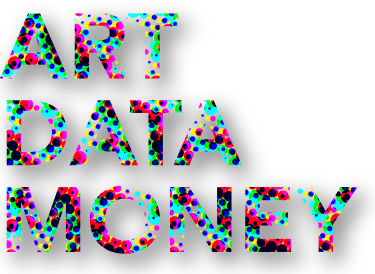
Artists to my mind are the real architects of change,
and not the political legislators who implement change after the fact
(William S. Burroughs)
A large-scale model of a CCTV camera made from recycled cardboard peers through the window of the Seventeen Gallery out onto Belmont Street in Aberdeen, alive with passers by. This is the main piece of Under New Moons, We Stand Strong (2016), the project conceived and designed by Teresa Dillon to prompt reflections on solidarity, literacy and symbolism within digital civic governance.
If one gets close enough, it is evident that the eye of this camera is blind for there is no actual watching and recording apparatus inside. Still, the sensation of being watched remains. Bird spikes are mounted on top of the camera. The first thing one notices is the scale of the model: for the first time, what is an almost impalpable and invisible presence (surveillance technologies tend to be increasingly difficult to spot in the urban space) gets amplified, taking a physical presence that invites us to explore our personal relationship with surveillance and the multiple technologies that embody it.
The enlarged cardboard CCTV camera not only reminds passers-by of surveillance, its visual presence, eye to eye and the size of an other, functions to interpellate the viewer as an active gazer. Instead of us being the object of its gaze, the large-scale model allows us to look at the CCTV camera up-front. The exchange of gazes between the two subjects, the surveillance apparatus and ourselves, occurs on an equal level: we occupy a position that is not anymore subservient to the mechanical all-seeing-eye. In the act of looking at the CCTV cardboard model, we can also recognise our own complicit capacity to become overseers.
Teresa Dillon’s installation invites us to become aware of the change occurred in contemporary social and technological developments in the relationship between surveillance and society. This change is subtler than it might appear at first. The Panopticon, Bentham’s prison architecture, was discussed by Foucault in his Discipline and Punish: The Birth of the Prison (1975) as an exemplar, among others examined in the book, of the mechanisms of social control that become permanent and interiorised. The prisoners, in fact, have no need to be actually watched, they know that they might be being watched. The condition of being potentially under surveillance transforms the dynamics of the gaze, causing an interiorisation of the watchtower’s gaze, in such a way that the prisoner becomes her own overseer.
Surveillance studies have pointed out how the Foucauldian metaphor of the Panopticon fails to describe the multi-faceted contemporary figurations of surveillance. It is not anymore a matter of keeping the prisoners in a certain space, but much more of keeping them away. The movement from the Panopticon to the Banopticon, for example, exemplifies the attempt to use profiling techniques to determine who should be placed under surveillance for security purposes. The Banopticon can be described as the attempt to keep away certain social groups (asylum seekers, migrants, suspected terrorists) in the context of global security and border control. This ban, interestingly, is not exercised exclusively upon certain groups or in extraordinary circumstances, but also upon those individuals who do not have the resources (for example credit cards and smartphones) to promptly respond to the enticement of consumer spaces such as shopping malls.
We need to take responsibility for the way in which we exercise the power to look. This was the sense of the two talks arranged as part of Urban Knights, a program of events conceived to provoke and promote practical approaches to urban governance and city living by bringing together people who are actively producing alternatives to our given city infrastructures, norms and perceptions. Programmed during the opening of Under New Moons, We Stand Strong, the first talk saw Keith Spiller, a lecturer in criminology at Birmingham City University, discussing state surveillance and individual rights in the context of his practical experiences of accessing CCTV data in London. Heather Morgan, a Research Fellow at the Health Services Research Unit, University of Aberdeen, presented her on-going research on sousveillance (in the context of health self-monitoring wearable technologies). In the middle of our smart cities, caught up in the illusion of being in control of smart technologies we are actually constructing our own prison.
Dillon’s interventions successfully unfold what the two talks left implicit at theoretical level, that is the passage from Foucauldian surveillance to “surveillant assemblage”. Deleuze’s and Guattari’s concept of surveillant assemblage makes visible processes in which information is first abstracted from human bodies in data flows and then reassembled as “data doubles” (Deleuze and Guattari 1987). Thus, a new type of body is formed, whose flesh is pure information transcending corporeality. The body is an assemblage, comprised of component parts and processes that need to be observed. Moving away from a hierarchical top-down gaze, in a rhizomatic-fashion, surveillance expands in multiple fractured forms.
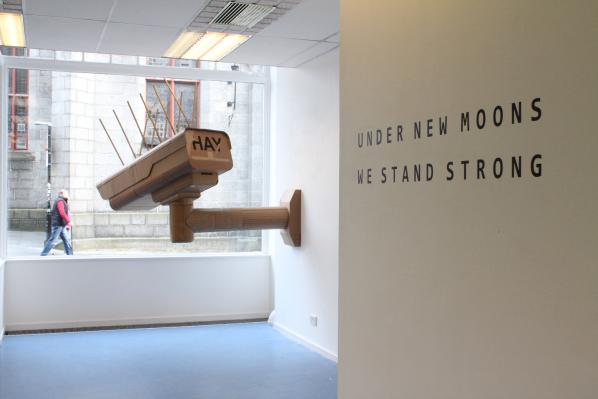
Going back to Dillon’s installation, on the gallery wall there is a digital print portraying a snowy owl in mid-air flight. This is a special edition print related to an episode on January 3rd, 2016 in Quebec, where a CCTV camera captured a stunning image of a snowy owl in mid-air flight. Four days later the images were tweeted by Quebec’s Transport Minister and went viral, turning the snowy owl into an “Internet star”. In Greek mythology the owl represents or accompanies Athena, the goddess of wisdom – and military strategy. Curiously, the next generation of surveillance technologies developed by the United States military bears the names of Greek mythological creatures. Argus Panoptes, which recalls the all-seeing giant monster with a hundred eyes, is a monitoring system that allows the constant surveillance of a city. Gorgon Stare, an array of nine cameras attached to an aerial drone, takes the name of the monstrous feminine creature whose appearance would turn anyone who laid eyes upon it to stone.
The owl is a highly metaphorical and yet ambiguous presence in the exhibition. On the one hand, the owl symbolises knowledge, wisdom and perspicacity. With its appearance, “flying only with the falling of the dusk” to paraphrase and transpose the famous passage from Hegel where the owl incarnates the appearance of philosophical critique and appraisal, the owl of Minerva (the Roman goddess identified with Athena) makes explicit the ideas and beliefs that drove an era but could not be fully articulated until it was over. Therefore, the owl is revealing something to us about our own epoch – it is our task to decipher the content of the message.
On the other hand, the owl is also the physical medium through which collaborative interspecies strategies of resistant actions to surveillance can be organised. Dillon’s techno-civic intervention, as the artist herself calls her work, is ideally connected to another artistic project, Pigeonblog, made by Beatriz da Costa, artist, academic and activist, member of the Critical Art Ensemble and graduate student of philosopher and science and technology scholar Donna Haraway. Pigeonblog was a grassroots initiative designed to collect and spread information about air quality to the public. Pigeons were equipped with small air pollution sensing devices capable of gathering data on pollution levels. The data could be then visualised and accessed by means of Internet (da Costa and Kavita 2008). Da Costa’s Pigeonblog was inspired by a photograph depicting a technology developed in Germany during wartime but then never implemented: a small camera, carried by a pigeon and set on a timer, was designed to take pictures at regular intervals of time as pigeons flew over specific regions of interest – possibly military targets. Pigeons were participating agents in this early surveillance technology system. Da Costa resuscitated that idea to create a surveillant assemblage formed by a living animal and technology but with civilian and activist goals.
By means of this mythological creature, the owl, Teresa Dillon asks us to learn to look at those technologies of surveillance, to re-adjust our gaze in order to be ready to face them upfront. The role played by mythology is evident not only in the installation but in the procession that accompanied the exhibition on Saturday May 7th. The public were invited to gather together and take part in a “forensic anthropological walk”, as the artist labelled it, throughout the city of Aberdeen, with participants holding hand-held models of two-dimensional CCTV cameras. Stopping in front of the CCTV cameras encountered in Castle Square during the walk, the artist revisited the world history of CCTVs, starting from the first documented use of surveillance cameras in Germany in 1942 for the documentation of Test Stand VII, the V-2 rocket testing facility, through the introduction of CCTVs in the urban landscape in the US in 1968, and more recent examples of surveillance technologies in the UK.
Dillon blends story-telling techniques with an emotional urban cartography created by means of walking together. Namely, the walk cannot be described in the guise of a city tour: the performative element transformed the walk into a procession, a collective rite, consumed on the Aberdeen beach where the paper cameras were set alight by participants. The history of surveillance technologies is in fact interwoven with mythological, symbolic and ritual elements, from the owl to the closing ceremony on the beach. Like in Cities of the Red Night, written by Beat Generation novelist William S. Burroughs, Dillon’s multiple interventions combines history with rituals and performance to evoke magical elements, doomsday scenarios and our phobias about the powers that control and enslave us.
The different interventions conceived and designed by the artist (the artwork itself, the performance, the walking tour through the city, the talks that accompanied the opening of the exhibition) can be read as artistic enactments of the cut-up and fold-in literary technique used to re-arrange and combine the pieces of a text to form new narratives. The technique can be traced back to the Dadaists of the 1920s. It was then popularised by Burroughs in the 1960s as a radical and creative method of socio-political subversion. It is evident that the cut-up and fold-in technique can be applied to contexts other than literature as Dillon demonstrates. It helps overcoming conventional associations (in this case, surveillance as a merely technological apparatus) to create new ones (the literacy infrastructure of surveillance), transforming the reader/player/visitor from a passive consumer of other people’s ideas into the architect of her own knowledge and action.
Under New Moons, We Stand Strong allows citizens to become not only more aware of the technological power infrastructure at work in our cities but also to learn how to read it, confront it, possibly resist it. The beach, at the outskirt of the urban space, a liminal site, nowadays often associated with the refugees crisis, becomes a space of freedom and catharsis. To set the cardboard cameras alight is, simultaneously, an act imbued with mythology – Prometheus’ gift of fire, the first techne, to humankind for their survival – and a collective gesture of transformation and renewal. Having freed ourselves from the idols, from all-seeing eyes, we can stay up-front, together, as a community, to face the darkness of our time.
Seventeen, Art Centre, 17 Belmont St, AB10 1JR, Aberdeen
Supported by Scotland’s Festival of Architecture, Peacock Arts Centre & Aberdeen City Council
Date: Thurs 5 – Sat 28 May 2016
Location: Seventeen, 17 Belmont St, AB10 1JR, Aberdeen
Opening: Thurs, 5 May, 6pm with special edition of Urban Knights
Procession: Sat 7 May, 8pm from Seventeen, 17 Belmont St, AB10 1JR, Aberdeen
Credits
Model & assistance: Jana Barthel
Commissioned by: Festival of Architecture, Scotland, 2016; Peacock
Visual Arts, Aberdeen & Seventeen Gallery, Aberdeen
In the introduction of Civic Radar, editor Peter Weibel sets out the motivation, layout and journey of the book. This first comprehensive monograph of Lynn Hershman Leeson’s artistic career, spanning across five decades. It must have been a dizzying publication to work on, when compiling her pioneering work in the fields of photography, video, film, performance, installation, and interactive and net-based media art. It is noteworthy that Hershman Leeson collaborated in its production. One feels her personal involvement in the book – its richness, care and detail, shows in its nearly 400 pages, and approximately 500 illustrations. It also features supporting texts by other writers, curators, theorists, and artists, such as: Andreas Beitin, Pamela Lee, Peggy Phelan, Ruby Rich, Jeffrey Schnapp, Kyle Stephan, Kristine Stiles, Tilda Swinton, Peter Weibel and interview by Hou Hanru and Laura Poitras with the artist.
“I try to live in the present, because most people live in the past. If you live in the present, most people think you live in the future, because they don’t know what happens in their own time.” Lynn Hershman Leeson.
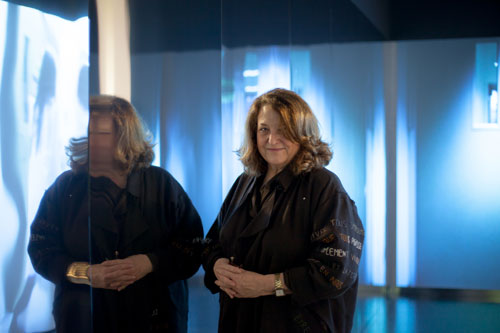
Lynn Hershman Leeson has pioneered uses of new technologies, recognized as key to the workings of our society today. She tackles the big questions surrounding: identity in a time of mass, overpowering consumerism; privacy in an era of surveillance; the interfacing of humans and machines; the relationship between real and virtual worlds; and new bio-ethics surrounding practices such as growing parts of the human body from DNA samples. We can think of Hershman Leeson as a direct artistic descendant of Mary Shelley. Consider Shelley’s celebrated publication, Frankenstein: Prometheus Unbound, published in 1818, and its challenges towards macho revolutionaries of ‘reason’, and her critique of the misuses of science and technology by the patriarch. We can see strong parallels between both women. They are feminists, who have managed to find ways around (and to work with) traditional forms of dominant, patriarchal frameworks, so to express personal, creative and cultural identities, on their own terms.
“Lynn Hershman Leeson’s mission statement seems to be that the body is a programmable software embedded in a changeable hardware. Therefore, she shows us so many hybrids and mutants, aliens and agents, actors and avatars, in real life and second life. From Dolls to clones, she demonstrates the paradox plurality of identities especially in the age of total observation.” [1] (Weibel 2016)
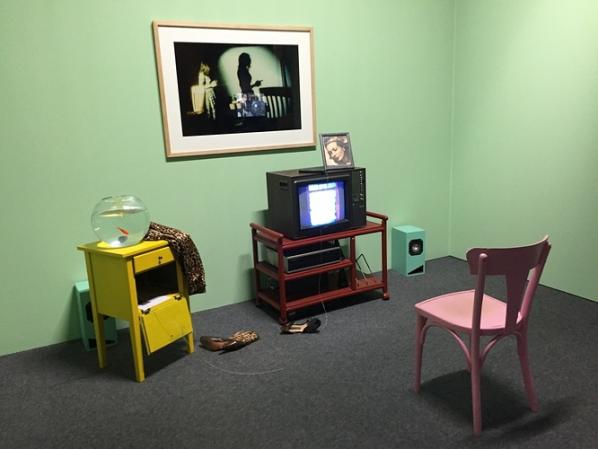
Hershman Leeson’s artistic process however does not keep its distance from the processes of science and technology. She leaps into the depths of our fears and unreservedly engulfs herself, and her imagination in their material influences and modifications. Like Donna Haraway, Hershman Leeson takes cyborgs, misfits, biology, mutation and transformation as her inspiration, contexts and materials. And also like Haraway, she playfully and critically owns concerns around science and technology, along with the ethical issues that may arise out of their continuously shifting, influences on society; and, thus not owned by or weighed down by them. Every work put forward by Hershman Leeson, is an experiment. Her interests and knowledge inspired by science and technology reflects her constant state of contemporariness. Her work directly correlates to breaking down systems of perceived values.
“Hershman Leeson confronted conventional gender roles and exposed the normative construction of gender identity. Some of her videos have included cross-dressers and transgender men and women, as in Double Cross Click Click (1995), and her assumed male pseudonyms at a time when the art world was dominated by men who mostly ignored women.” [2] (Beitin 2016)
Hershman Leeson’s art moves fluidly between different formats, contexts and disciplines. This of course is not easy to brand. The art market survives by promoting art that fits into particular roles and products that are easy to promote, predict and consume. The irony here is that the art world promotes the idea of itself as a site of novelty and insights, but in reality represents a deeply conservative culture. Some artists, Hershman Leeson is one of them, transcend the contemporary artworld norm and build alternative universes, contexts and identities, where the art is so investigatory and esoteric, traditional conventions are challenged.
When I interviewed Hershman Leeson last year for Furtherfield she talked about how she’d like to “eradicate censorship, and make more transparent the capitalistic underpinnings that are polluting access, value and visibility”. In the 70’s, she was the first artist working on a prison art project in San Quentin, and many of her early public art works “geared toward social change.” [3]
Civic Radar shows us that her work is not reduced to a singular, reflection of her own creative self. There is a wider story and it includes the voices of many others as part of the narrative of her life and her work, as well as reclaiming a history in a male dominated society.
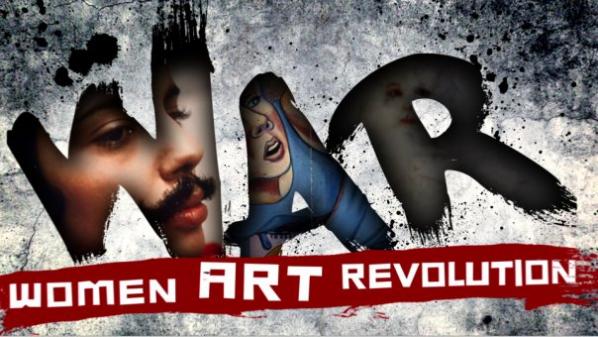
We see reaffirmed a varied and dynamic history where she has been involved in strengthening the role of women in society, as part of an extension of her art process. One excellent example of this rich history is that over a period of 40 years she interviewed an extensive array of women artists, historians, activists, and critics who integrated personal and political content into their work. Then, some of that gathered material was made into a film project !Women Art Revolution, in 2010.
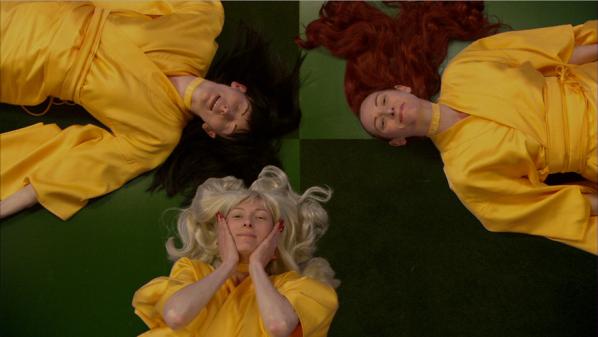
Lynn Hershman Leeson has not only achieved pioneering work as an artist, but also as filmmaker. She has collaborated with actor and Oscar winner Tilda Swinton in several feature films that have gone on to receive numerous awards at international film festivals on account of their outstanding quality and innovative themes. »Teknolust« is an absurd, amusing and scientifically highly topical science-fiction drama on the subjects of cyber-identities, biogenetics, gender constructions and sexual self-determination in the age of the Internet. The plot turns on the scientist Rosetta Stone (Tilda Swinton), who illegally produces three clones of herself. The artificial entities can only be distinguished by the color of their clothing and live in an enclosed cyberspace. Because they are dependent for survival on the male Y chromosome, Ruby, the femme fatale among the clones, goes in regular pursuit of men. Sexual contact with Ruby leads to impotence in her lovers as well as to an allergic reaction triggered by a computer virus which is transferable to human beings. The FBI becomes aware of the clone family’s machinations following the increased incidents of infection among men, and begins to investigate. Note*
Her work has crossed into many different fields and formats. Which includes: installations, videos, films, sculptures, robots, avatars, contracts, computer programs, photography, paintings, drawings, collages, browser based art, artificial intelligence, bio-matter, network communication systems and devices. Synthia Stock Ticker and Dollie Clones are just two examples that demonstrate how ahead she has been with her ideas and her integration of digital technologies into art. Synthia Stock Ticker, is a networked-based media artwork made in 2000. It refers to the stock ticker invented by Thomas Edison and is unusually prescient in its portrayal of the emotional life of global markets. Inside a glass casing sits a small monitor screen, showing a video of a woman character named Synthia. “When the market is up, the character dances and shops at Christian Dior: when the market is down, she chain smokes, has nightmares, and shops at Goodwill.” [4]

Again The Dollie Clones 1995-96 predate a contemporary artistic obsession with creeping surveillance. Two telerobotic dolls, Tillie the Telerobotic Doll and CyberRoberta, whose eyes have been replaced with cameras. Each doll has a website that allows users to view the images taken by the webcams and click on an “eyecon” to telerobotically turn the doll’s head 180 degrees to survey the gallery.

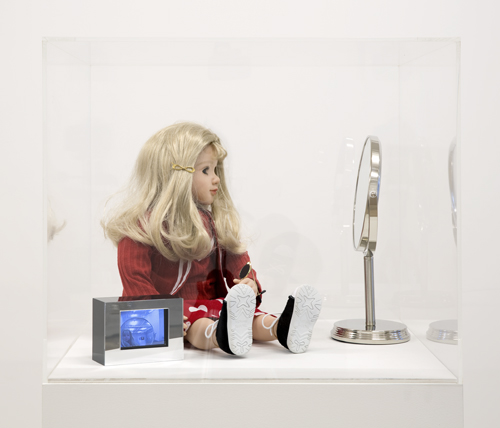
Hershman Leeson’s most prominent performance work was as another woman, Roberta Breitmore. This elaborate alter ego existed between 1973 and 1978. The Breitmore character was well developed, possessing different behaviors and attitudes to Hershman Leeson’s own personal identity. Roberta Breitmore had her own handwriting, clothing, wig, makeup, driver’s license, apartment, psychologist, bank account, credit cards, acquaintances, life story, and adventures. Hershman Leeson took the audacious leap and sporadically became Roberta Breitmore for 5 years. Other women also lived as Roberta Breitmore and sometimes simultaneously. [5]
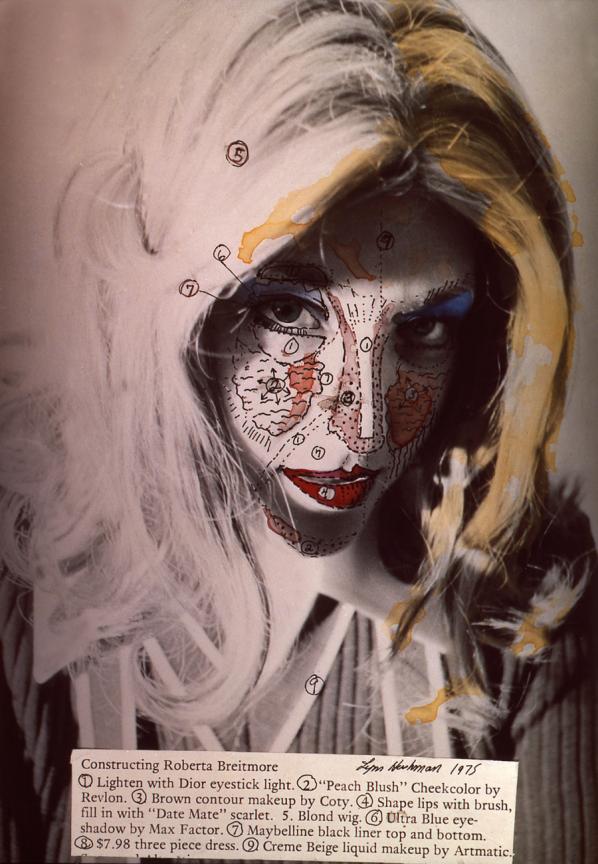
“Hershman Leeson hired three additional performers, all women, to play Roberta. They wore costumes identical to the ones Hershman Leeson herself wore, and they treated Roberta essentially as a professional (albeit part-time) gig. They undertook some of Roberta Breitmore’s correspondence and went on some of her dates (which were documented in photos and audio recordings). Eventually, Hershman Leeson stopped enacting Breitmore, reducing the instantiations of Roberta Breitmore from 4 to 3.” [6] (LaFarge 2007)
The spirit of Hershman Leeson’s radical art persona can be seen in younger, contemporary artists today. For instance, Heath Bunting’s Identity Kits, part of his larger The Status Project consist of various items, personal business cards, library cards, a national railcard, T-Mobile top-up card, national lottery card and much more. “They take a few months to compile each of them because they are actual items that everybody uses in their everyday lives, involving evidence of identity. There is also a charge for the package of 500.00 GBP, which is cheap for a new identity.” [7] (Garrett 2014) Then we have Karen Blissett, an Internet artist who suddenly decided to go multiple by opening up all of her email, Twitter, Facebook and Google accounts to many different women around the world. “A torrent of provocative, poetic, and often contradictory voices issued proclamations, made auto portraits, and shared psalm-like meditations on her existential transformation; distributed across online platforms and social spaces, in text, image and video.” [8] (Catlow 2014)
Towards the end of Civic Radar a collection of pages show us various images of the exhibition by the same name at the ZKM Museum of Contemporary Art, in Germany 2014. When viewing the images of her work in the large gallery spaces you realize the scale of it all, and how substantial her work is.
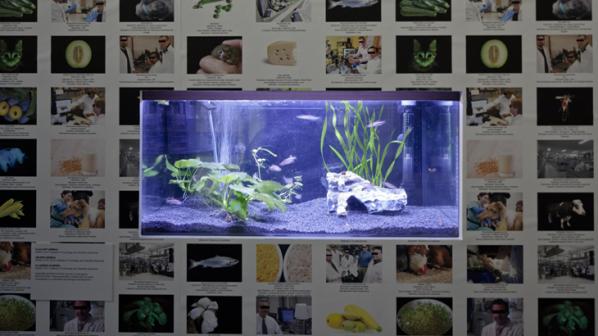
Moving on after the images of the works in ZKM, there is a selection of Hershman Leeson’s texts written, from 1984 and 2014. These writings, take us through different stages of her career, revealing ideas and intentions behind much of her work and also some of the work included in the publication. In the last paragraph of the last text in a short essay, titled The Terror of Immortality she writes about the contexts that have given rise to her most recent work. “As organic printing and DNA manipulation reshapes the identities of newly manipulated organisms, so too the culture of absorbed surveillance has dynamically shifted. In the next 100 years, the materials used to create DNA will become increasingly distributed and hybridized. The implications of this research include not only the creation of a sustainable planet of hybrid life forms that can survive a sixth extinction and incorporate into to its existence a morally responsible future.” (Leeson 2016)
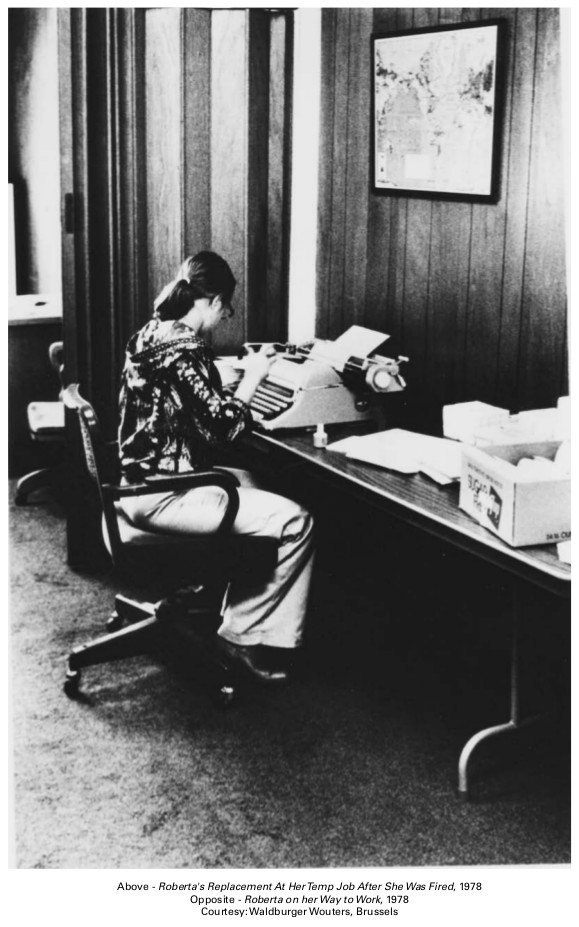
This book is a profound read, offering an insight to this generous and profound artists’ fantastical journey in an era marked by accelerating change. And what’s so amazing is that the content, the narratives, and the histories, are real. It is an Aladdin’s Cave of rich, exceptional artworks, flowing with brilliant ideas. Hershman Leeson has had her finger right on the pulse of what’s relevant in the world for a long time, and transmuted the knowledge she unearths in her examination of identity, feminism, science, technology and more into her own artistic language.
Her work is way ahead of most contemporary artists showing now. This book should be read everywhere. Not just because it features great art, but also because features a woman with a great mind. I am not a fan of the words genius or masterpiece; I find them tiresome terms reflecting a form of male domination over women and the non-privileged classes. Yet, after spending time with Civic Radar, I cannot help myself thinking that I have just witnessed something equivalent without the negative baggage attached.
*Text from ZKM – Teknolust. With Lynn Hershman Leeson at the cinema.
http://zkm.de/en/event/2015/03/teknolust-with-lynn-hershman-leeson-at-the-cinema
In 2015, ZKM in cooperation with the Deichtorhallen Hamburg / Sammlung Falckenberg exhibited the first comprehensive retrospective of Leeson’s work, including her most recent productions of art. Last year Modern Art Oxford hosted a major solo exhibition of her work Origins of a Species, Part 2 and she also has work in The Electronic Superhighway, at Whitechapel Gallery, in London.
Featured Image: Obscurity (2016), Paolo Cirio
Obscurity, the latest project of Paolo Cirio, targets american mugshot websites. Mugshots are one of the utmost paradigms of the inexorable logic of today’s online economy and its controversial ethics; they collect and expose photos of people who have been arrested in the U.S., irrespective of the type of offence, and they profit by placing reputation management ads or by charging a removal fee. The owners of these websites are often anonymous or based offshore. As part of his project, Cirio cloned some the most known mugshots, scrambled the data profiles of the listed individuals and obfuscated their identities. In addition, he programmed the algorithm so that it boosts the ranking of the cloned websites in order to interfere with the activity of the original ones and to therefore sabotage their function. Mugshots can have a decisive role in someone’s life, reinforcing a new form of social stigmatisation defined by search engines results. When visiting the mugshot duplicates, users are invited to decide whether the listed profiles should be kept or removed. Obscurity brings to the foreground critical and complicated issues around today’s privacy and transparency, discussing the current legislative system in the U.S. in comparison to Europe and other parts of the world.
I talked with Paolo Cirio about the challenges and difficulties behind his -once again- daring act and artistic work.
DD: Mugshot websites are based on the exploitation of the anxiety and fear of people who have been arrested in the U.S. It addresses a new form of monetisation that takes reputation management to its extreme. Could you tell us how ‘big’ is the issue of mugshots in the U.S. and what made you develop a project about it?
PC: There are probably over 50 million mugshots on the Internet, and perhaps more, considering that every year in the U.S., city and county jails admit between 11 and 13 million people, an average that has been steadily increasing in the last twenty years. I personally met people that had their mugshots published on those websites and had to pay a removal fee. I would say that this is a very common issue for non-white and low-income Americans, who are the majority, although they’re often neglected by public attention.
I was surprised that this issue was being ignored and not addressed seriously. I couldn’t find any privacy organization in the U.S. focusing on this issue or making a major case for the Right to Be Forgotten in the U.S.
In particular, the several contradictions and complexities of the situation offered me an exciting subject to intervening practically and conceptually. It was the saddest and most delicate material I had ever worked with. However, it was important to address how the flow of information today can impact lives so directly and how art can do something with that. In most of my artworks, I highlight our information society’s legal, economic, and social implications. These fields are all tightly interconnected in this work: the economic value of sensitive information with the personal interest and the legal system with the public democratic interest. I would say that this work is about society as a whole.
DD: At the heart of your project lies an obfuscation algorithm. Obfuscation is a strategy against datafication which has been very much discussed in the last few years. How is it used as part of your project, and why?
PC: The obfuscation of information became quite a sophisticated operation in this work. The huge dataset I assembled with such delicate material could not be wasted or mishandled. That’s why I decided to apply different layers of obfuscation to protect the privacy of the individuals and, at the same time, keep the data accurate.
The algorithm shuffles first and last names and mugshots based on common gender, race, age, and location, making their obfuscated identities similar to the original ones. Meanwhile, for the profile of the person arrested, all the data concerning the arrest is maintained accurately. The individual records provide the social context of the arrest for public scrutiny without exposing the individual. For instance, you can still count how many people of colour have been arrested in a specific county, but it would be hard to identify individuals.
I believe there is a need to learn how to handle sensitive information very carefully, case by case, and to deal with complexity to provide simplicity and not make it more overwhelming. The notion of privacy and transparency can’t be polarized between fears and utopias of big data.
In past years, I’ve been working on several projects concerning the circulation, appropriation and exposure of sensitive information over the Internet. In particular, I made artwork by recontextualizing photos of individuals on Facebook, Twitter, Google Street View, and other online platforms. These provocative works were meant as a warning regarding social media companies’ privacy policies and the danger of losing control over one’s pictures posted online. However, I never let search engines index this personal information or expose their names in all cases.
I believe in a need for an ecology of information. I see information as water; it should be safe, accessible, and clear for everyone’s sake. Any form of pollution could damage an entire ecosystem. Therefore, for me, obfuscating a particular flow of information is more of a technique to clean a toxic spill into a reserve of data that can be essential for a democratic society. Like when it allows public scrutiny over law enforcement agencies. Imagine some operations trying to obfuscate open data or inject fake stories into WikiLeaks. Wouldn’t it be as shameful an act as polluting spring water? In the future, it’ll be even more important to fight to keep the oceans of data clean, safe, and navigable.
This is another reason why obfuscation is something that should be done carefully.

DD: As part of your artistic practice, you often deploy participatory formats for the audience. Lately, though, you seem to be more and more interested in having the audience take a stance and become more involved in the decision-making or problem-solving process. What made you turn in this direction for this particular project? How does user participation become an indispensable part of the work?
PC: I follow the natural evolution of the Internet. I started research works involving millions of individuals in early 2009 when I noticed how quickly Facebook was becoming popular, thus offering a huge audience for my work, which became the actual material of it. Many apps let us manage our life and everything around it by tapping buttons on screens. At this point, everyone makes decisions on the Internet that affects someone else as they produce changes in concrete reality. The Internet is the best tool and environment for decision-making and problem-solving today. Therefore, the basic sense of civility we developed in the physical space should be learned in the online environment.
Yet, with the Internet, we are in the Paleolithic Period, almost naked in public, and learning about what we can do with primitive tools while not knowing how to live together peacefully and with respect for one another.
In this project, I examine online judgment. The rating that is taken to its extreme is online shaming. I’m interested in the ethics and aesthetics around it concerning algorithms and individuals who rate and score others.
With the participatory model proposed, everyone can decide to keep or remove an individual criminal record. I like to invent systems of participation, as they can be structured to channel flows of social dynamics for creative forms of society.
It is a preposition, “what if” everyone could judge people online accused of a crime like an open jury and give a verdict on whether they should be forgiven or punished by society. The project also questions the necessary information to make a fair judgment. I’d not be surprised if tribunals were to one day have this type of online public forum.

DD: Through your artwork, you are underlining the urge for the ‘Right to Remove.’ How does this differ from what we know in Europe as the ‘Right to be Forgotten?
PC: The Right to Be Forgotten has been largely contested in both the U.S. and the E.U. for its potential to censure, for its lack of transparency on the decision process, and because it makes search engines the only jury on what the public can find online. Yet, in the E.U., although not perfect, the law offers all European citizens some rights since a few years ago.
In the U.S., it’s more complicated, mainly because the First Amendment protecting the Freedom of Expression is supposed to win over any attempt to curb the publishing of public information and opinions. This is the case made to oppose the Right to Be Forgotten in the U.S., and the one pushed forward by many organizations, like those dedicated to lobbying for freedom of the press or governmental transparency laws, that still defend the publishing of mugshots.
The federal system in the U.S. further complicates this situation. Every state in the U.S. has been approaching issues concerning the online publication of mugshots, revenge porn, and even information on minors differently. In many states, these are still totally unregulated. Talking about the legal and justice system in the U.S. is very hopeless when considering that Google is the company that has spent the most money ever in lobbying the U.S. Congress. Google has always been strongly opposed to the Right to Be Forgotten in both the E.U. and the U.S. They always mention censorship, technical impracticality, and not being accountable for their search results.
However, with copyright and trademark claims, search engine companies can manage huge quantities of takedown requests. Why would they not be able to offer the same for personal information complaints? Ownership rights should not be more important than human rights.
With this project, I made a proposal for a basic list of very specific categories of personal information that ordinary people in the U.S. should be able to remove from search results. With the Right to Remove, I wanted to create a straightforward campaign to inspire a workable form of this right for the U.S. To do so, I researched this legal subject on the campaign’s website. I launched a petition that I plan to have signed by a few key privacy lawyers, academics, and organizations in the U.S. in the coming months, to be finally presented as an open letter to search engine companies and the FTC. However, for me, this proposal is part of the conceptual artwork. I don’t have hopes of being able to effect change as that would require a huge press effort, and so far, I haven’t received any funding or institutional support for this project.
DD: Are you also interested in the aesthetic qualities of obfuscation? Are you planning a physical installation of the artwork?
For me, the aesthetic qualities are mainly conceptual and strategic.
In most of my work, there is also a documentative function, in this case, it’s about bringing attention to mass incarceration and the lack of a privacy policy in the U.S. Because of the research presenting facts with videos, texts, data, and images, the audience can enjoy the artwork as an interactive documentary. I don’t find data visualization an interesting mode of presentation. Still, I did use the database to find gross human rights violations like the mugshots of ten-year-old kids or seniors over ninety-five.
I later realised that the algorithm that manipulates the mugshots created very interesting visual effects. It seems worth it to make prints of them for the installation. The darkness and the blueness recall the obfuscation of data in a visual form. They look scarier or more inoffensive when the colours hide their appearance. This reminds the audience of how difficult it can be to judge someone without having clear and complete information about the individual. In the installation, I would have a paper shredder that destroys mugshots as they are printed based on the audience’s browsing and interactions on the mugshot websites.
With this project, I also suggest a form of Internet social art practice. It’s inspired by many artists I admire that have been doing social practice work in the U.S. In this case, I’m suggesting that artists can make Internet artworks that have a social function for a problematic group of people, communities and the environment.
For instance, with this project, I started to receive an increasing number of emails from people asking me to remove their records because they thought I was behind the real mugshot websites. They are automatically redirected to sign the petition.
What makes an aesthetic difference for me is when artworks live outside the art world and artistic modes of representation. My audience is not really the minority attending the spectacle of art. Instead, it’s real people with real lives and concerns. Even when the artwork is not exhibited, reviewed, or sold, it’s still online, informing, producing reactions, and possibly changing.

project website: https://obscurity.online
cloned websites:
http://Jailbase.us
http://Usinq.us
http://Mug-Shots.us
http://JustMugshots.us
http://MugshotsOnline.us
http://BustedMugshots.us